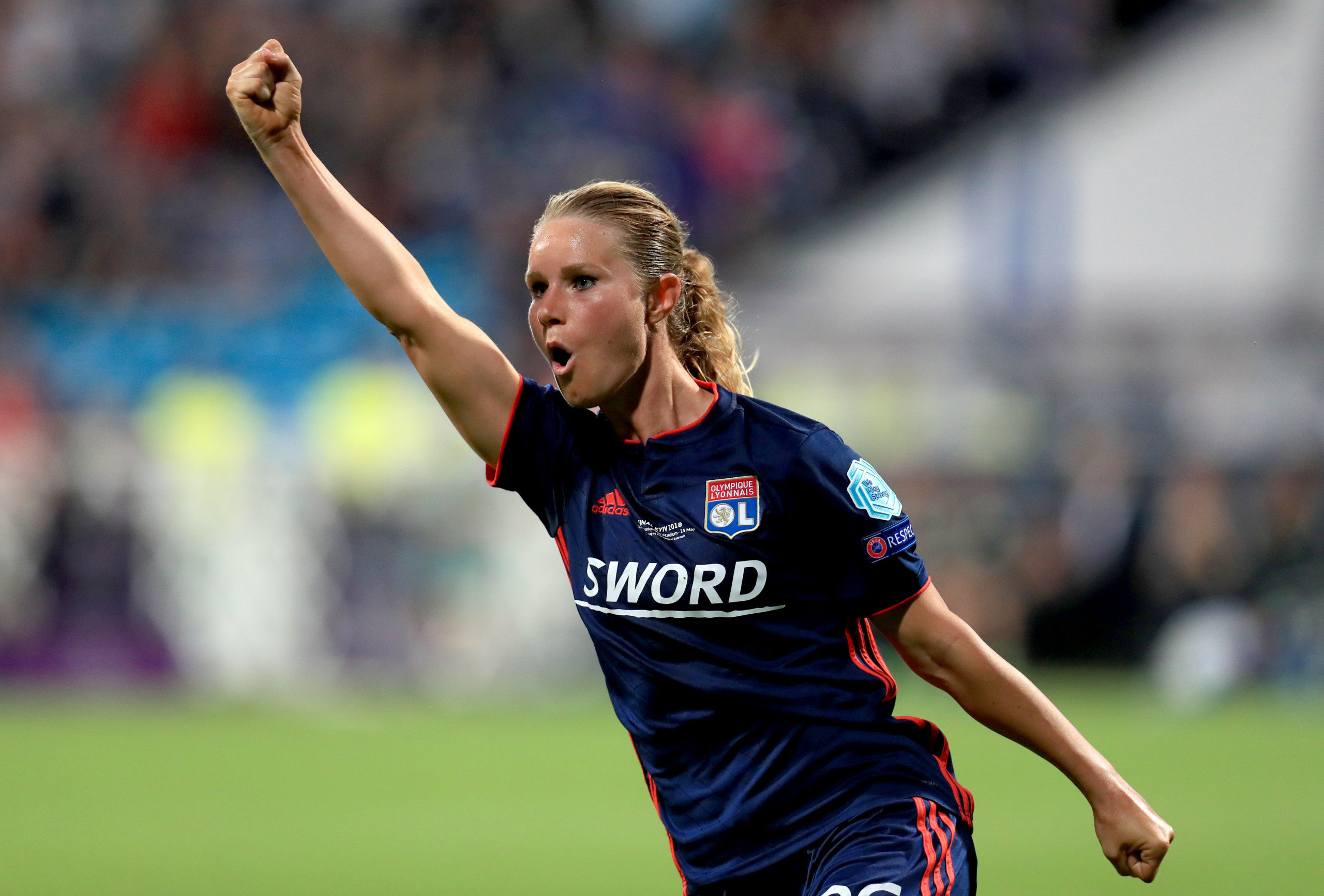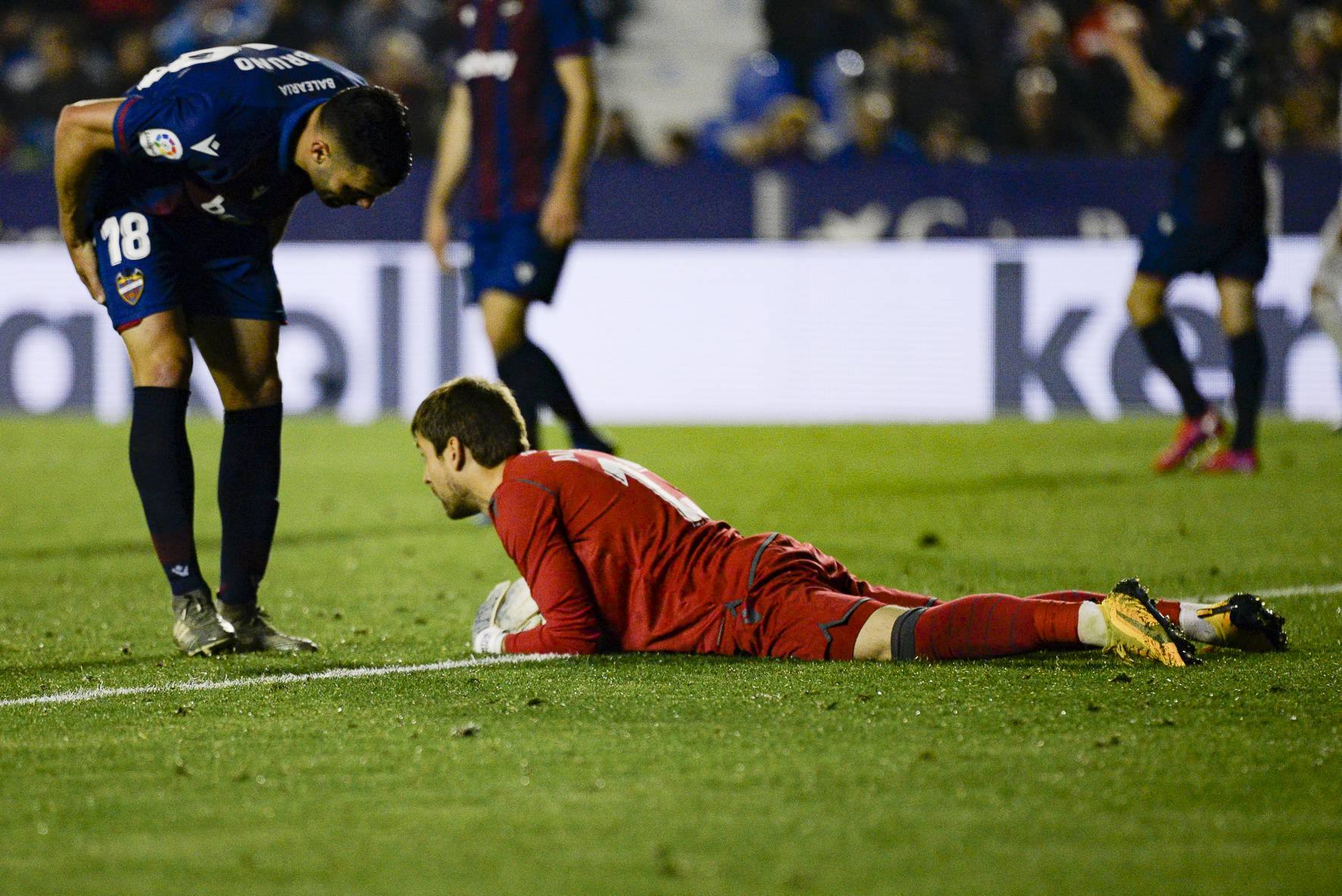Juventus - Inter is almost always the most anticipated match of the year in Serie A, but this season it’s an even greater attraction as it could be decisive for the title fight. The Bianconeri, who have lost only once in their last 14 matches against Inter, lead by 6 points. A win would pretty much destroy the Nerazzurri’s title hopes, even though Inter’s last match against Sampdoria was postponed and so they have a game in hand. However, if Conte’s men manage a win at Juventus, it would balance the defeat of the first leg, seriously threatening the Old Lady’s quest for a 9th consecutive league title. This season Inter have done their utmost to close the gap with Juventus, and their expected goal difference makes it appear they’ve managed to do so. Their xG of 0.73 is only slightly worse than Juve’s 0.77. With penalties excluded, however, Juventus remain far superior, with a 0.77 non-penalty xG difference versus Inter’s 0.60. In the first leg, Juventus showed that superiority, beating Inter 2–1, with double the number of Inter’s chances (18 shots to 9); the only goal they conceded was a penalty. 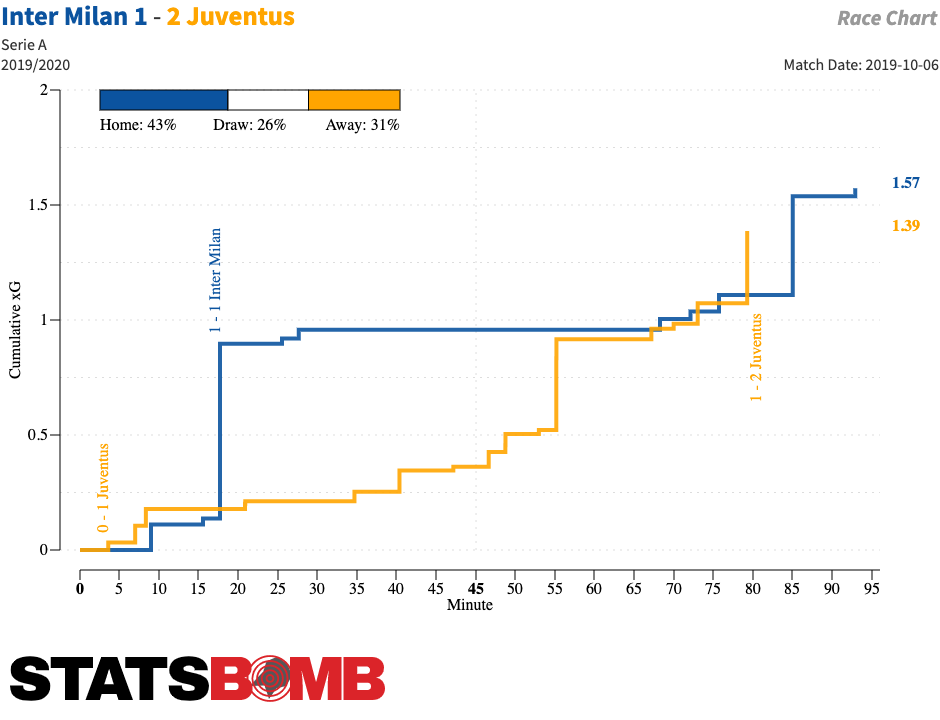 However, Antonio Conte's team, despite the win against Ludogorets in the Europa League, has been declining recently, no longer able to maintain the same level of performance as in the first half of the season. But the same can be said for Maurizio Sarri's squad, which suffered two defeats in their last five Serie A games and unexpectedly lost the first leg of their Champions League Round of 16 match against Lyon (somehow).
However, Antonio Conte's team, despite the win against Ludogorets in the Europa League, has been declining recently, no longer able to maintain the same level of performance as in the first half of the season. But the same can be said for Maurizio Sarri's squad, which suffered two defeats in their last five Serie A games and unexpectedly lost the first leg of their Champions League Round of 16 match against Lyon (somehow). 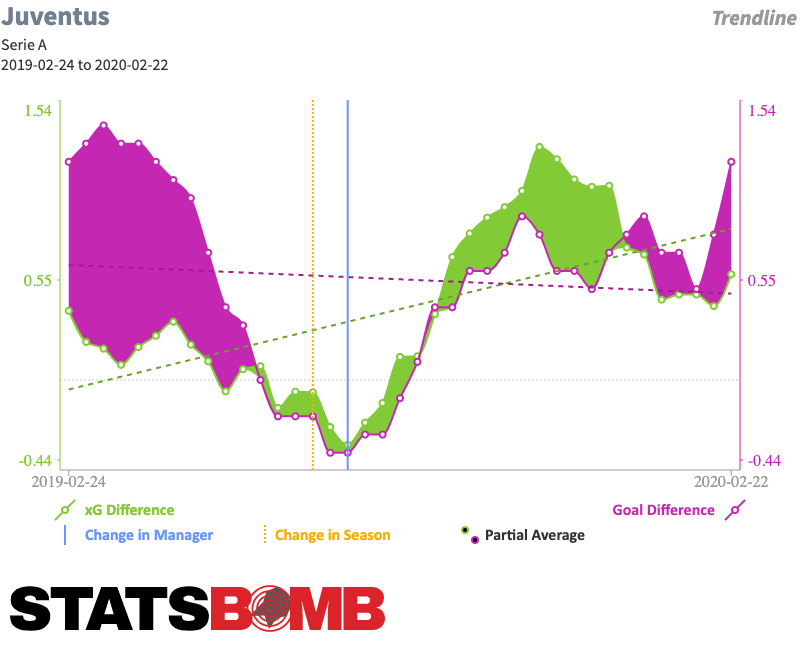 Those who expected an improvement in Juventus' performance as the decisive moment of the season approached are disappointed. The team did not make the anticipated leap in the quality of their play; on the contrary, they dropped in performance, though they still do benefit from Cristiano Ronaldo's fantastic finishing form. Ronaldo has scored in 11 consecutive Serie A games, a record on a par with Fabio Quagliarella and Gabriel Batistuta adding a total of 16 goals (including 5 penalties), though he had scored just 5 times before the start of December.
Those who expected an improvement in Juventus' performance as the decisive moment of the season approached are disappointed. The team did not make the anticipated leap in the quality of their play; on the contrary, they dropped in performance, though they still do benefit from Cristiano Ronaldo's fantastic finishing form. Ronaldo has scored in 11 consecutive Serie A games, a record on a par with Fabio Quagliarella and Gabriel Batistuta adding a total of 16 goals (including 5 penalties), though he had scored just 5 times before the start of December. 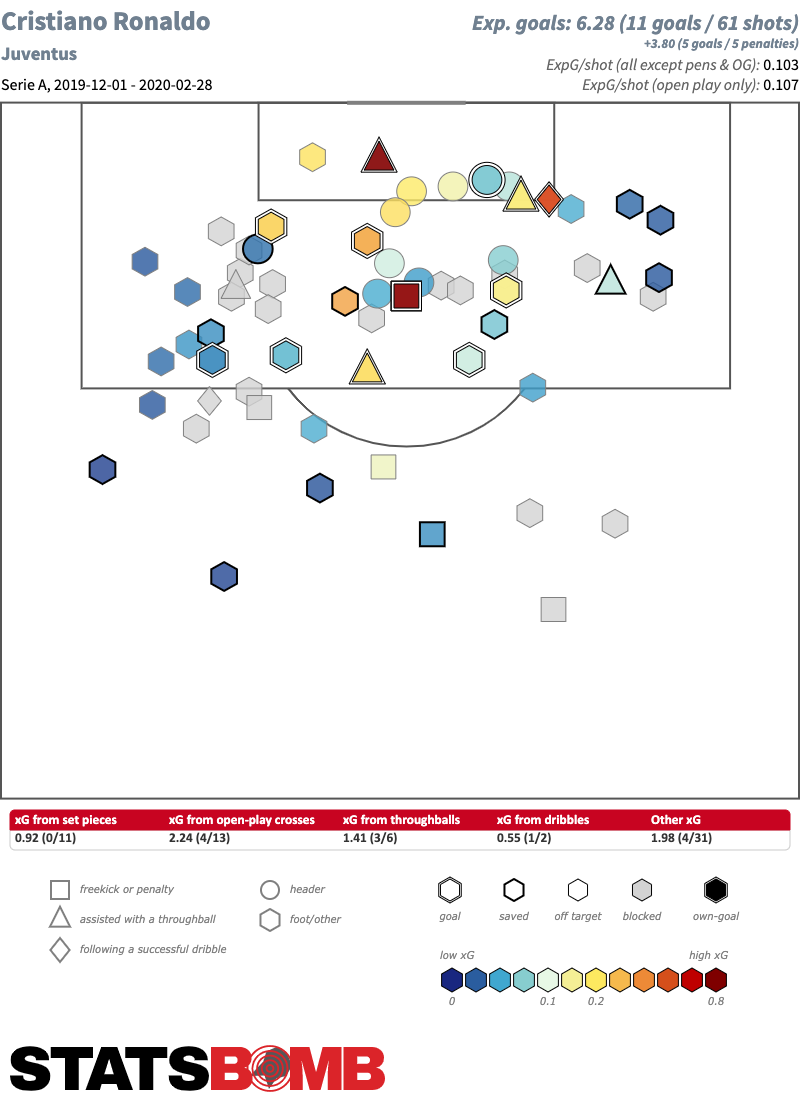 If Inter manage to limit Ronaldo Juventus will seriously struggle, as other Bianconeri have often failed to convert their chances during their top scorer's streak. As Mike Goodman pointed out, Juventus have a high percentage of ball possession, but have a hard time getting into the penalty box and are sometimes forced to take relatively low-quality attempts (their average xG per shot is 0.09). Inter's defense, which concedes shots with an average xG of 0.08 and just 1.92 passes inside the box, will be far from easy to crack. But things will change if Conte is forced to do without his starting goalkeeper; Samir Handanović has already missed six games and his month-long finger injury could keep him out of the Derby d’Italia as well. Not that he has been stellar this season (he's 13th in the league per goals saved compared to the average goalkeeper) but in the few games he’s played, it’s been obvious the Inter players don’t have as much confidence in his replacement, Daniele Padelli, as they do in their trusted veteran Handanović.
If Inter manage to limit Ronaldo Juventus will seriously struggle, as other Bianconeri have often failed to convert their chances during their top scorer's streak. As Mike Goodman pointed out, Juventus have a high percentage of ball possession, but have a hard time getting into the penalty box and are sometimes forced to take relatively low-quality attempts (their average xG per shot is 0.09). Inter's defense, which concedes shots with an average xG of 0.08 and just 1.92 passes inside the box, will be far from easy to crack. But things will change if Conte is forced to do without his starting goalkeeper; Samir Handanović has already missed six games and his month-long finger injury could keep him out of the Derby d’Italia as well. Not that he has been stellar this season (he's 13th in the league per goals saved compared to the average goalkeeper) but in the few games he’s played, it’s been obvious the Inter players don’t have as much confidence in his replacement, Daniele Padelli, as they do in their trusted veteran Handanović. 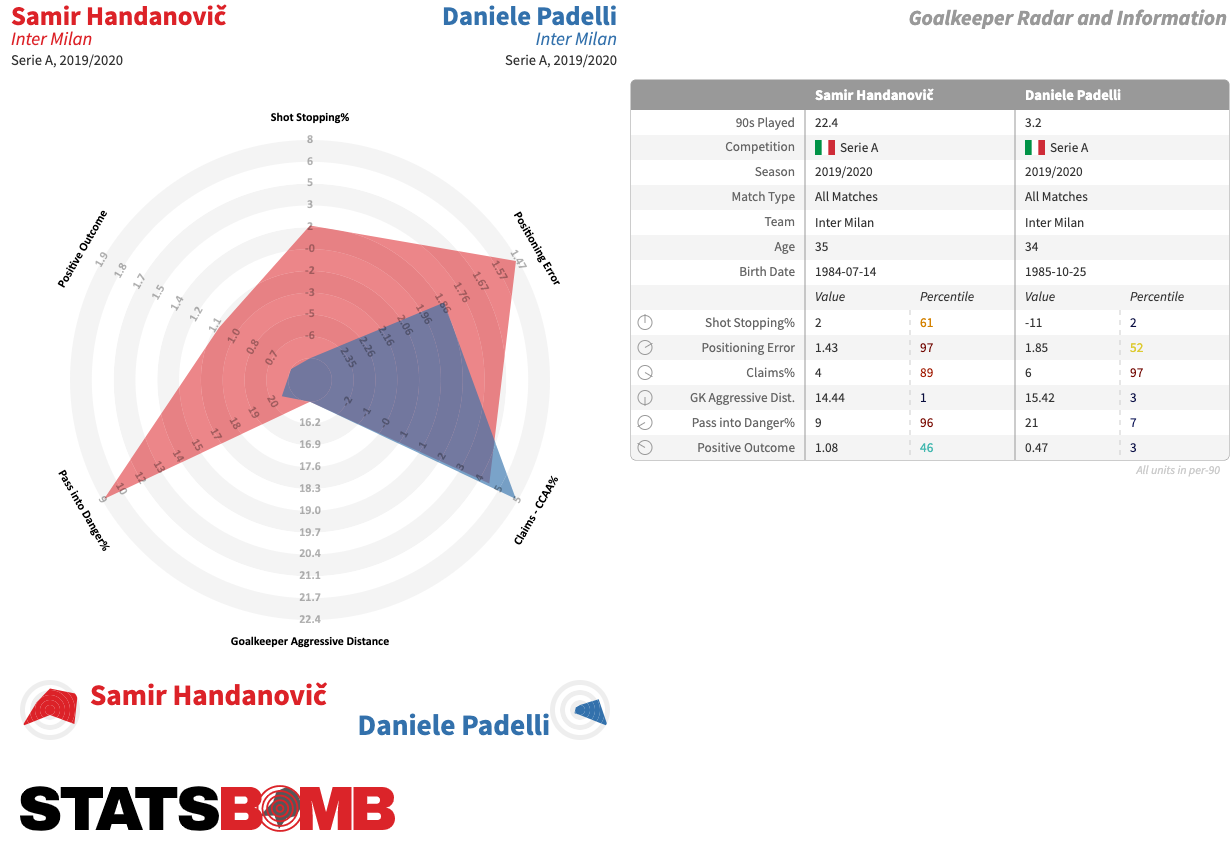 Back in October, Juventus' pressing strategy worked well. Against Inter’s 3-5-2, Sarri had lined up his team in 4-3-1-2. Ronaldo, on the left, pressed Diego Godín, while Paulo Dybala, selected over Gonzalo Higuaín, limited Stefan De Vrij and Sami Khedira while also pushing higher up to press Milan Škriniar. Federico Bernardeschi, as the offensive midfielder, marked deep-lying playmaker Marcelo Brozović. If Inter managed to gain space, then Juventus would regroup, leaving De Vrij, the central defender in the opposing three-man defense, free. Juan Cuadrado and Blaise Matuidi, on the other hand, were effective in shutting down Inter attacks on the flanks, a key area for a team lined up with a midfield diamond.
Back in October, Juventus' pressing strategy worked well. Against Inter’s 3-5-2, Sarri had lined up his team in 4-3-1-2. Ronaldo, on the left, pressed Diego Godín, while Paulo Dybala, selected over Gonzalo Higuaín, limited Stefan De Vrij and Sami Khedira while also pushing higher up to press Milan Škriniar. Federico Bernardeschi, as the offensive midfielder, marked deep-lying playmaker Marcelo Brozović. If Inter managed to gain space, then Juventus would regroup, leaving De Vrij, the central defender in the opposing three-man defense, free. Juan Cuadrado and Blaise Matuidi, on the other hand, were effective in shutting down Inter attacks on the flanks, a key area for a team lined up with a midfield diamond. 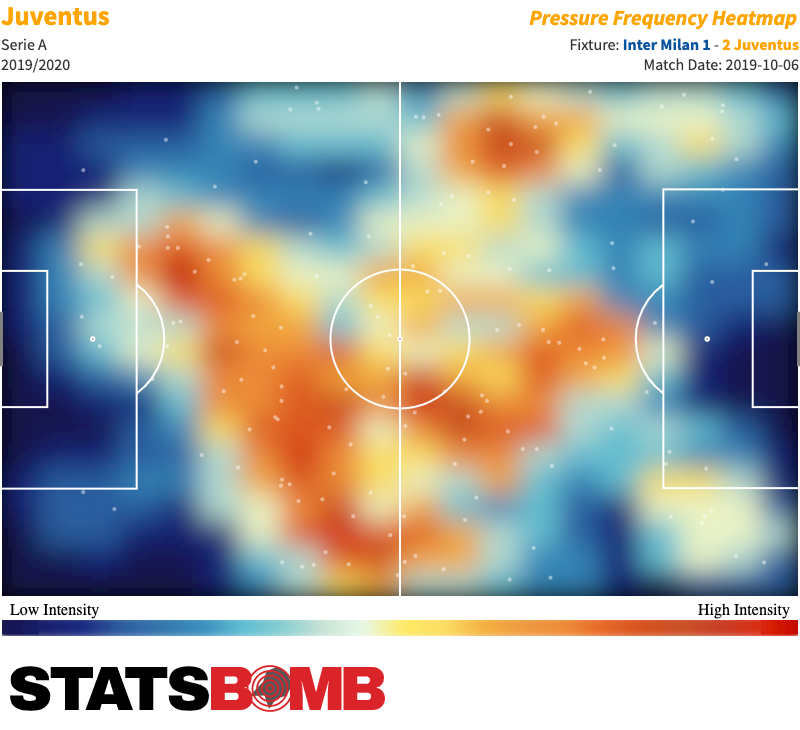 In the reverse fixture, Juventus will probably line up with a different midfield and could even change their system of play, but if they manage an equally effective pressing strategy they will control the momentum of the match. As happens often this season, last time around Inter leaned heavily on their two strikers in an attempt to overcome Juventus' effective pressing but failed to create high-quality chances. They couldn’t penetrate Juventus' defensive block, and more than half their chances came from the feet of Lautaro Martínez, who finished the game with 4 shots, 4 dribbles, and a key pass. At the San Siro, Stefano Sensi’s injury was a real blow for Inter; when the midfielder was forced to leave the pitch before the end of the first half, they became much more vulnerable to pressing and less dangerous on the attack. It’s not clear if he will start in Turin, but the presence of Christian Eriksen could certainly help his teammates consolidate possession and achieve greater penetration. In defense, Inter pressed Juventus's build-up by man-marking their players, but if their opponents overcame the first pressure they dropped deep, maintaining a 5-3-2 defensive shape, which gave too much freedom to the opposing midfielders.
In the reverse fixture, Juventus will probably line up with a different midfield and could even change their system of play, but if they manage an equally effective pressing strategy they will control the momentum of the match. As happens often this season, last time around Inter leaned heavily on their two strikers in an attempt to overcome Juventus' effective pressing but failed to create high-quality chances. They couldn’t penetrate Juventus' defensive block, and more than half their chances came from the feet of Lautaro Martínez, who finished the game with 4 shots, 4 dribbles, and a key pass. At the San Siro, Stefano Sensi’s injury was a real blow for Inter; when the midfielder was forced to leave the pitch before the end of the first half, they became much more vulnerable to pressing and less dangerous on the attack. It’s not clear if he will start in Turin, but the presence of Christian Eriksen could certainly help his teammates consolidate possession and achieve greater penetration. In defense, Inter pressed Juventus's build-up by man-marking their players, but if their opponents overcame the first pressure they dropped deep, maintaining a 5-3-2 defensive shape, which gave too much freedom to the opposing midfielders. 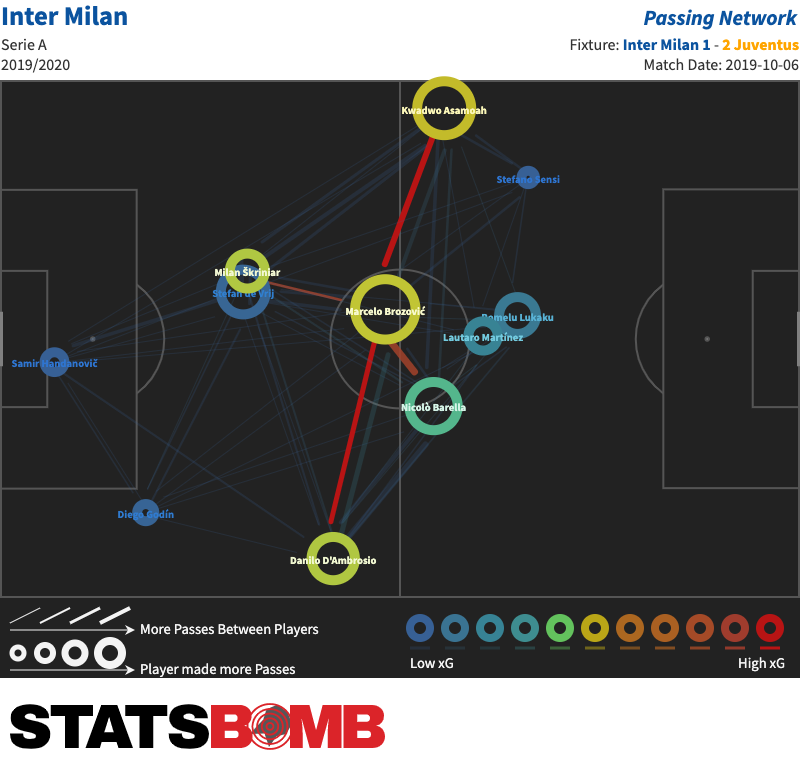 Nevertheless, Verona has shown that even a team of Juventus' quality can get into trouble against intense, well-organized pressing. Inter cannot afford to be pushed into their own half for 90 minutes. Even the penalty in Inter–Juventus had come from a ball recovered from a successful pressing action. If the San Siro game is any indication, the pressing battle will be decisive for the outcome of the match. If the drop in Inter's intensity in recent games is a result of Conte's load-management, then this is the match where no one will limit their effort. This huge match will be played in an unreal atmosphere, as due to the coronavirus outbreak it will take place behind closed doors. However, even without a crowd in the stands, and with only a few games before the end of the season, both teams will do everything they can to win. If one doesn’t emerge victorious, Lazio could benefit from the draw by leaping to the top of the standings. The 237th Derby d’Italia will be a thriller; it’s too bad no one with be there to watch in person.
Nevertheless, Verona has shown that even a team of Juventus' quality can get into trouble against intense, well-organized pressing. Inter cannot afford to be pushed into their own half for 90 minutes. Even the penalty in Inter–Juventus had come from a ball recovered from a successful pressing action. If the San Siro game is any indication, the pressing battle will be decisive for the outcome of the match. If the drop in Inter's intensity in recent games is a result of Conte's load-management, then this is the match where no one will limit their effort. This huge match will be played in an unreal atmosphere, as due to the coronavirus outbreak it will take place behind closed doors. However, even without a crowd in the stands, and with only a few games before the end of the season, both teams will do everything they can to win. If one doesn’t emerge victorious, Lazio could benefit from the draw by leaping to the top of the standings. The 237th Derby d’Italia will be a thriller; it’s too bad no one with be there to watch in person.
Month: February 2020
Data Spotlight: The good, the bad and the almost certainly getting relegated from Division 1 Féminine
For a league that boasts one of the most successful women’s teams of all time, predictably, there’s no shortage of things said about D1 Arkema (the technically official name for Division 1 Féminine, France’s women’s first division), but such an unbalanced league usually leads to unbalanced coverage. Olympique Lyonnais’ can skew league news while the majority of teams that play in France’s top tier fall from the radar, lost in the shadows cast by the giants of the women’s game. But the league has lots to offer beyond the star power at the top. In D1F, it’s easy to subdivide the table into groups: first come the heavy-hitters of Lyon and Paris Saint-Germain, then we drop to the consistent no more, no less of the third-place finishers. Moving to the nuts and bolts, the background characters who make up the bulk of the league – they’re not going to trouble the top but they’ll also be safe, locked in an existence of perpetual obscurity. Finally, at the bottom are the teams I simply like to call au revoir, as they’re going down; you know it and they know it and little can be done to change it.
Heavy-hitters
In France, the two heavy-hitters are Lyon and PSG. These two are the crème at the top of the league and boast star-studded squads that marry homegrown French talent with the financial means to buy the best players from around the world. Lyon remain the heaviest hitters of all; for 13 straight seasons, they have romped to the title, casting all others aside like me en route to the buffet.This year is no different, the side leads the league in non-penalty expected goals difference.  Dominant both domestically and in Europe, Lyon are the current UEFA Women’s Champions League holders and hand out drubbings all over Europe as often as in France. Consistently boasting the best attack in France – if not Europe – Lyon’s current strength comes from their midfield with playmaker Dzsenifer Marozsán pulling the strings, ably assisted by fellow midfield maestros, Amandine Henry and Saki Kumagai. As the side’s defensive heatmap shows, they’re a team that rips the ball away high up the pitch, and suffocates its opposition with wave after wave of attack.
Dominant both domestically and in Europe, Lyon are the current UEFA Women’s Champions League holders and hand out drubbings all over Europe as often as in France. Consistently boasting the best attack in France – if not Europe – Lyon’s current strength comes from their midfield with playmaker Dzsenifer Marozsán pulling the strings, ably assisted by fellow midfield maestros, Amandine Henry and Saki Kumagai. As the side’s defensive heatmap shows, they’re a team that rips the ball away high up the pitch, and suffocates its opposition with wave after wave of attack. 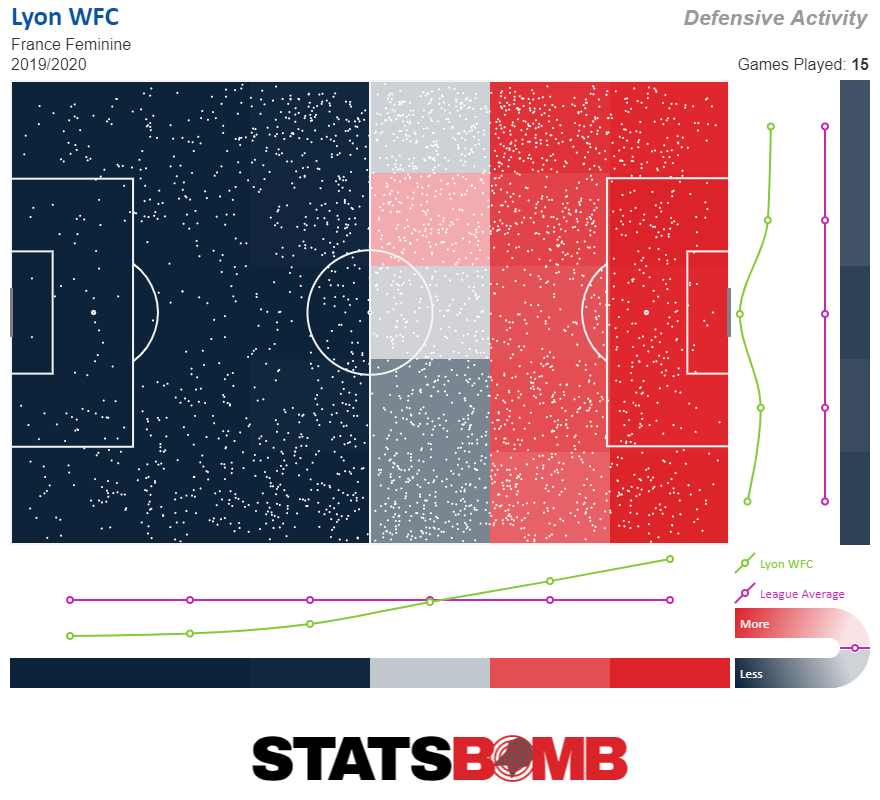 Lyon have a set piece prowess as well and usually use dead balls to unlock opposing defences – and they’re not bad with their heads either. The side has created 15 goals from just over 11 xG from dead ball situations.
Lyon have a set piece prowess as well and usually use dead balls to unlock opposing defences – and they’re not bad with their heads either. The side has created 15 goals from just over 11 xG from dead ball situations. 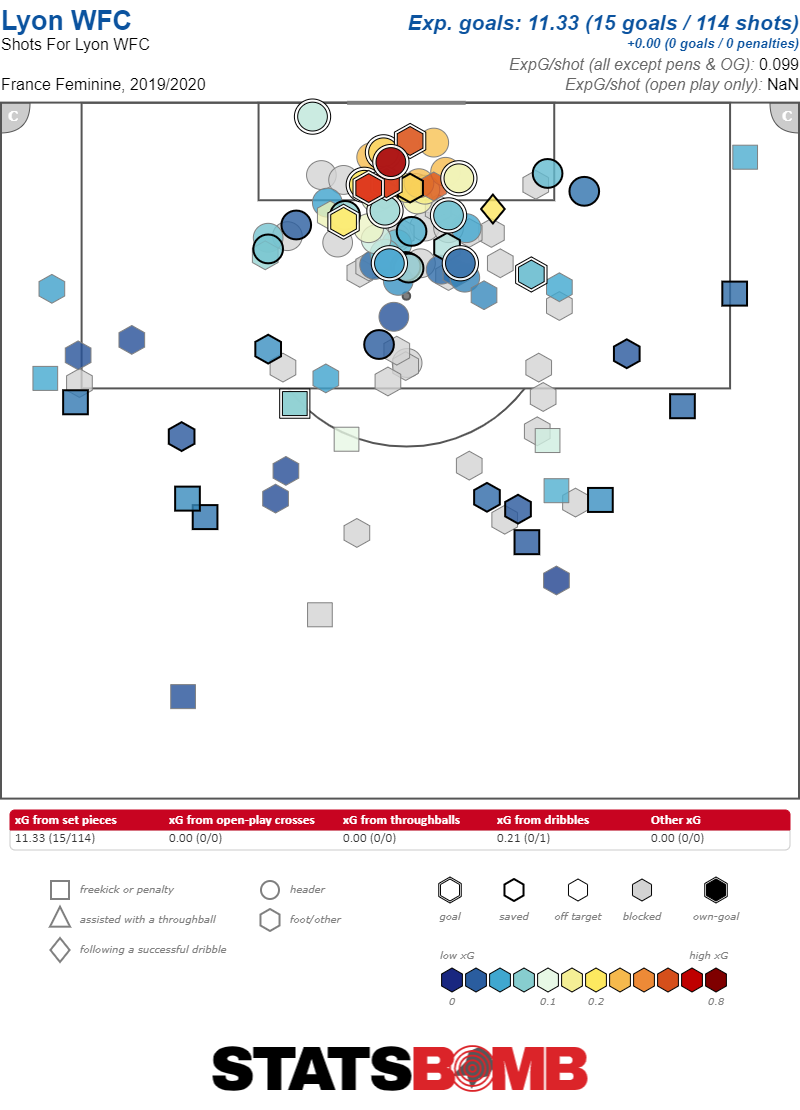 The perpetual bridesmaids to Lyon’s blushing brides, PSG are the only team that could come close to rivalling the champions. Yet they repeatedly fall at the last hurdle, usually surrendering vital points to Lyon along the path to their second-place finish. Lyon already handled them comfortably once back in November with the return leg in Paris set for 14 March.
The perpetual bridesmaids to Lyon’s blushing brides, PSG are the only team that could come close to rivalling the champions. Yet they repeatedly fall at the last hurdle, usually surrendering vital points to Lyon along the path to their second-place finish. Lyon already handled them comfortably once back in November with the return leg in Paris set for 14 March. 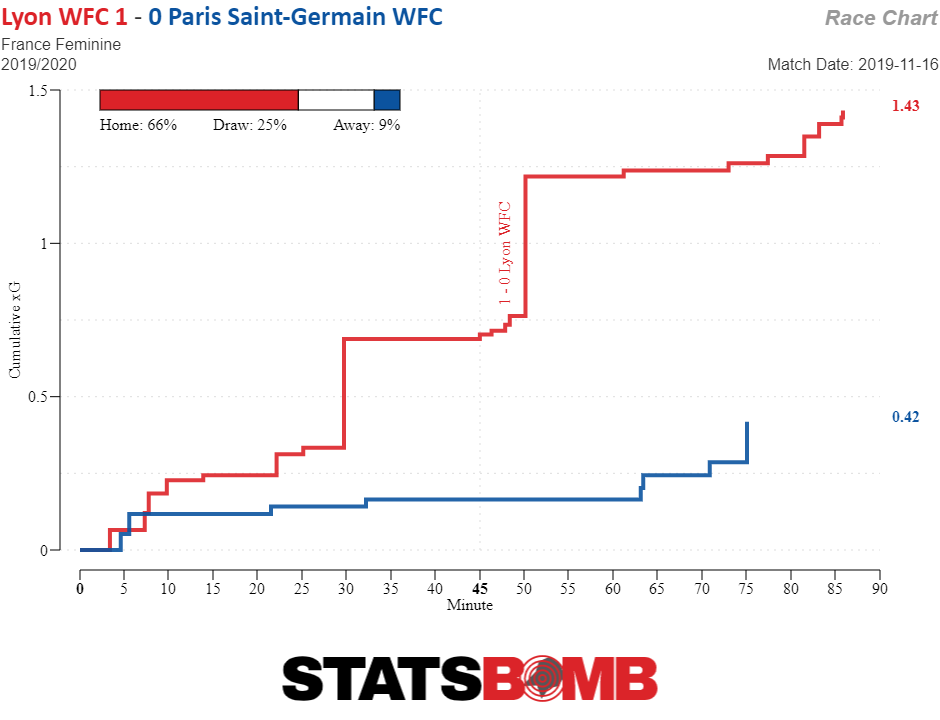 PSG have not always been the heavy-hitting team they are today. However,constant investment and a steady rise from the lower divisions have proved that time and millions in the bank make almost anything possible (except, perhaps, winning the league). Having struck the right balance across the pitch, the team moves fluidly. Much like Lyon, they don’t lack in any area but particularly boast riches in attack, and this season the team is flying thanks to the attacking partnership of suburban Parisien duo Marie-Antoinette Katoto and Kadidiatou Diani. The dynamic duo account for the lionshare of the team’s xG.
PSG have not always been the heavy-hitting team they are today. However,constant investment and a steady rise from the lower divisions have proved that time and millions in the bank make almost anything possible (except, perhaps, winning the league). Having struck the right balance across the pitch, the team moves fluidly. Much like Lyon, they don’t lack in any area but particularly boast riches in attack, and this season the team is flying thanks to the attacking partnership of suburban Parisien duo Marie-Antoinette Katoto and Kadidiatou Diani. The dynamic duo account for the lionshare of the team’s xG. 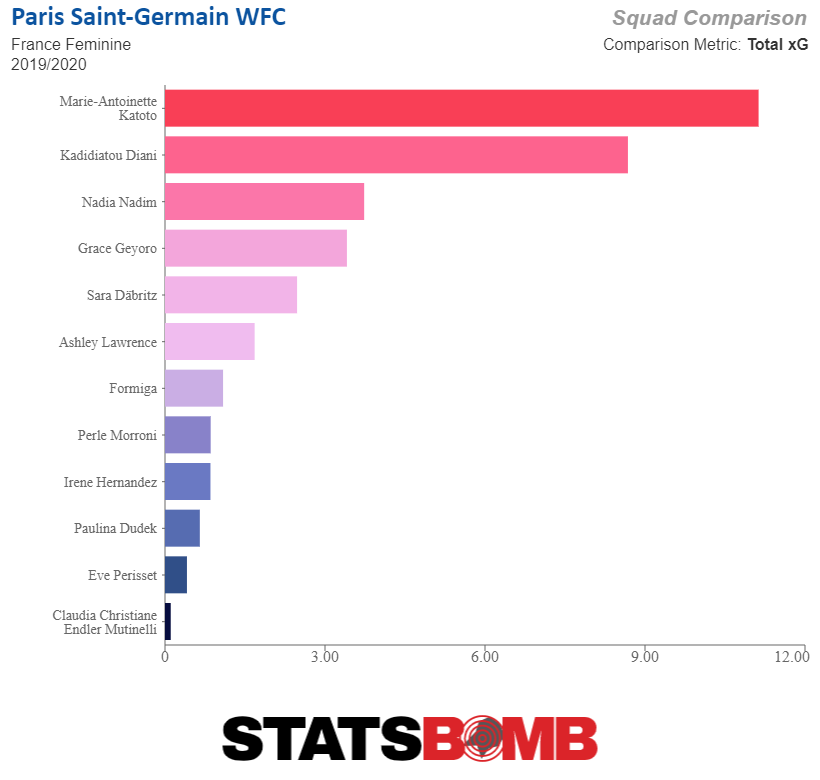
No more, no less
The pattern in France has always been two or three at the top with one or two nipping at the heels of the title chasers, and although teams have come and gone, that trend has remained a constant. A team who’ve been in both packs over the years, Montpellier, are struggling to really find their footing after coming off the boil last campaign, yet the team from the Mediterranean coast still have enough to rise above the also-rans. While the side is uniformly talented, without any notable weak links, a lack of consistency causes problems for Montpellier and the team also struggles for a stand-out player who might rescue them when they wobble, having lost a number of starters over the last few years. However, the acquisition of Lena Peterman from Turbine Potsdam remains an astute one; the striker is in good form and quite menacing in the box. 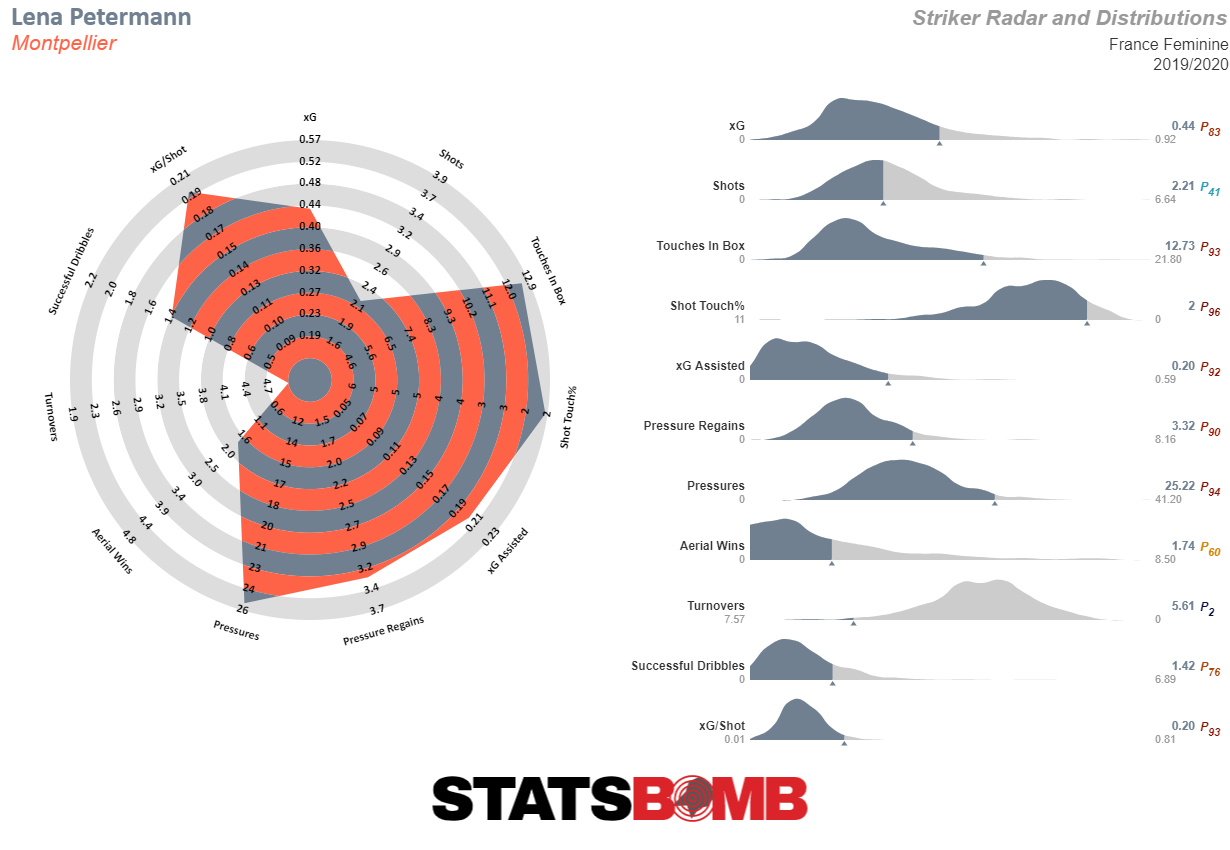 She’s undeniably excellent at poaching goals by taking shots of the absolute highest quality.
She’s undeniably excellent at poaching goals by taking shots of the absolute highest quality. 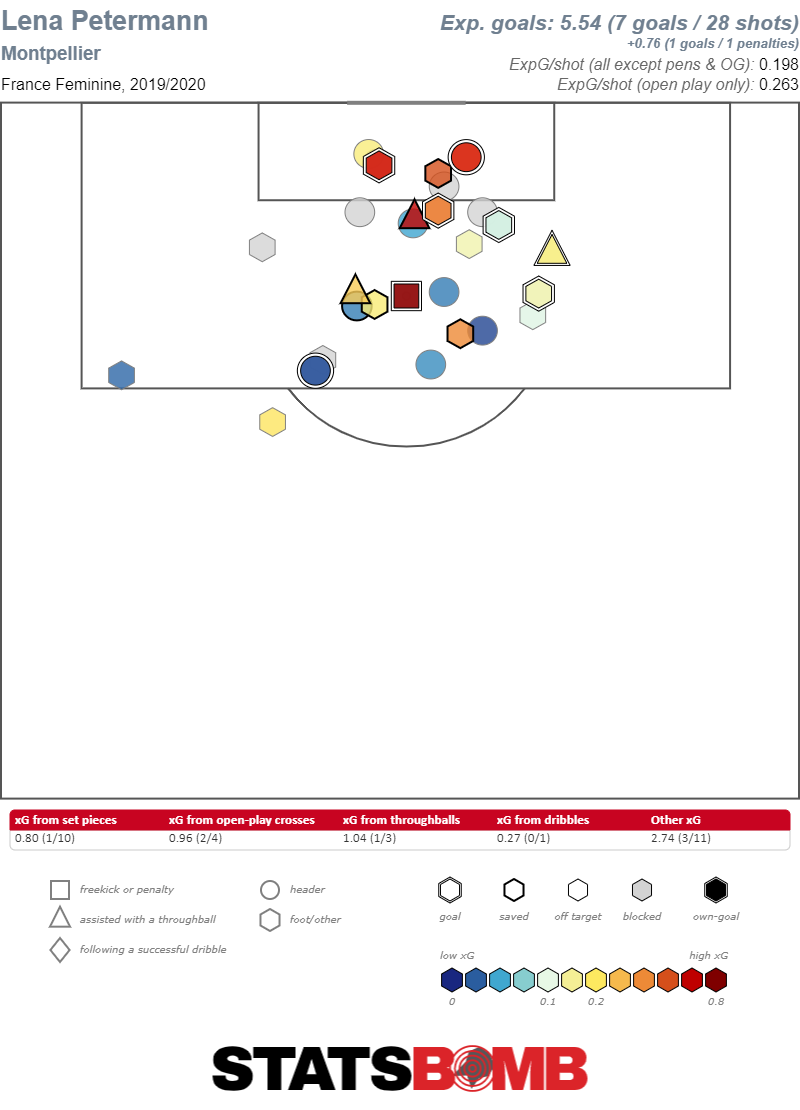 The team that have all but usurped Montpellier, Bordeaux are the current bronze medal contenders, and having spent their last four seasons in the league steadily rising, should easily be the neutral’s choice for the year. Managed by Pedro Martínez Losa, there is a sense of something blossoming in the region known for its wine production – and it’s not a fruit forward red with a robust finish. The team, like many that challenge for something in France, lead from the front. Whilst the signing of highly rated Jamaican international Khadija “Bunny” Shaw is what had people talking before the season started, it’s been homegrown Viviane Asseyi that’s set the team alight this term. With an exceptional turn of pace and composed touch, Asseyi has dragged Bordeaux forward from the front, bulking out her goal tally and partnering well with both Shaw and up and comer Ouleymata Sarr.
The team that have all but usurped Montpellier, Bordeaux are the current bronze medal contenders, and having spent their last four seasons in the league steadily rising, should easily be the neutral’s choice for the year. Managed by Pedro Martínez Losa, there is a sense of something blossoming in the region known for its wine production – and it’s not a fruit forward red with a robust finish. The team, like many that challenge for something in France, lead from the front. Whilst the signing of highly rated Jamaican international Khadija “Bunny” Shaw is what had people talking before the season started, it’s been homegrown Viviane Asseyi that’s set the team alight this term. With an exceptional turn of pace and composed touch, Asseyi has dragged Bordeaux forward from the front, bulking out her goal tally and partnering well with both Shaw and up and comer Ouleymata Sarr. 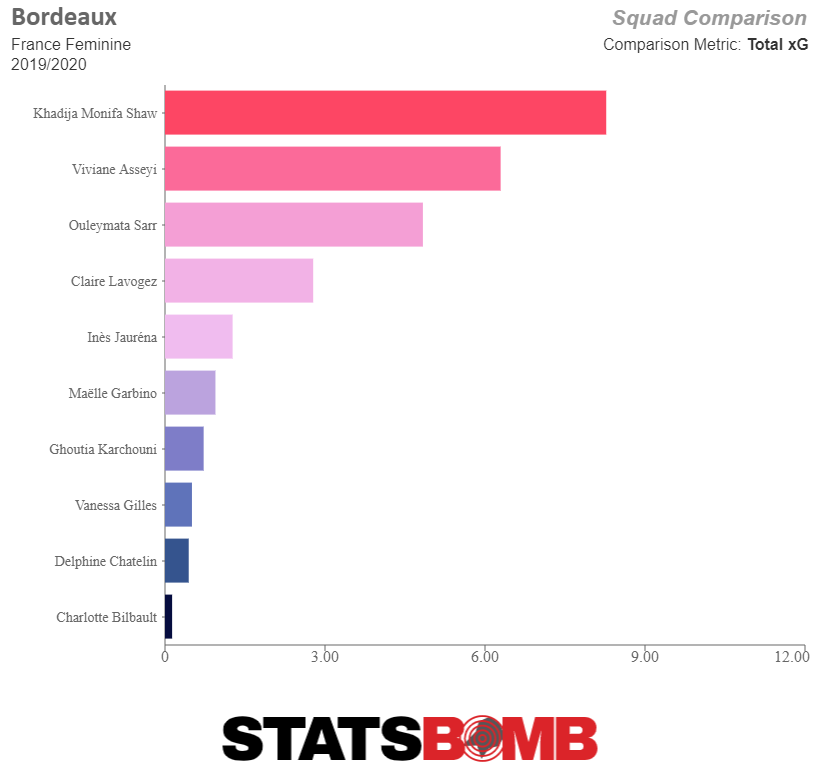
The background characters
In D1F, fifth to tenth is a wash of similar teams all trying to better themselves, bouncing from a promising season to a disappointing one and back again, with players drifting in and out of teams as they look to better themselves.. These are the teams most likely to cause a few upsets along the way – like Dijon’s surprising, and extremely unlikely, 0–0 at home to Lyon – but are also likely to get battered by the teams at the top. 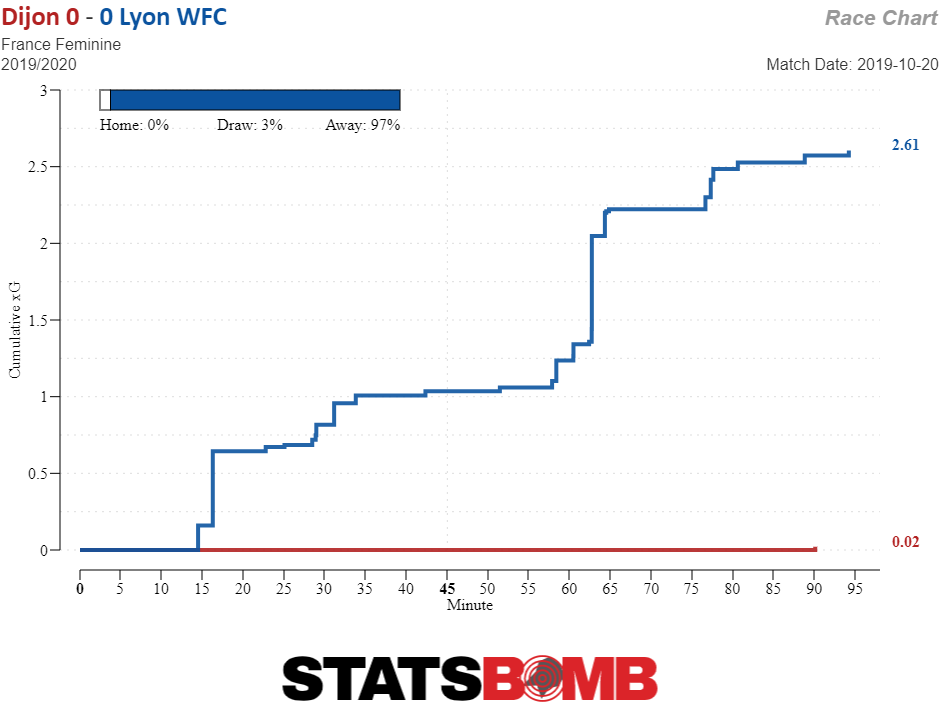 Paris FC have failed to keep pace with the changing times in the league. The side, formerly from Juvisy, used to be Champions League regulars,, but after being integrated into the Ligue 2 club in 2017 have failed to recapture any former glory. Still boasting a lot of the same players from years past, this team has more experience than it has quality. It also has a habit of zapping the potential out of players, leaving the club a study in mediocrity. A team that tends to huff and puff more than it blows your house down, En Avant Guingamp remain one of the teams in France that could yet ascend to the coveted (if not frustrating) category of no more, no less. Despite being unable to find her 2016–17 season form, her best yet, Desire Oparanozie still offers an out in attack, but her role is fast being overtaken by Louise Fleury, who has a growing knack for popping up in the right place at the right time. The team is boosted by having Solène Durand between the sticks, the would-be French number one with a keen ability to throw her body in front of anything goal-bound.
Paris FC have failed to keep pace with the changing times in the league. The side, formerly from Juvisy, used to be Champions League regulars,, but after being integrated into the Ligue 2 club in 2017 have failed to recapture any former glory. Still boasting a lot of the same players from years past, this team has more experience than it has quality. It also has a habit of zapping the potential out of players, leaving the club a study in mediocrity. A team that tends to huff and puff more than it blows your house down, En Avant Guingamp remain one of the teams in France that could yet ascend to the coveted (if not frustrating) category of no more, no less. Despite being unable to find her 2016–17 season form, her best yet, Desire Oparanozie still offers an out in attack, but her role is fast being overtaken by Louise Fleury, who has a growing knack for popping up in the right place at the right time. The team is boosted by having Solène Durand between the sticks, the would-be French number one with a keen ability to throw her body in front of anything goal-bound. 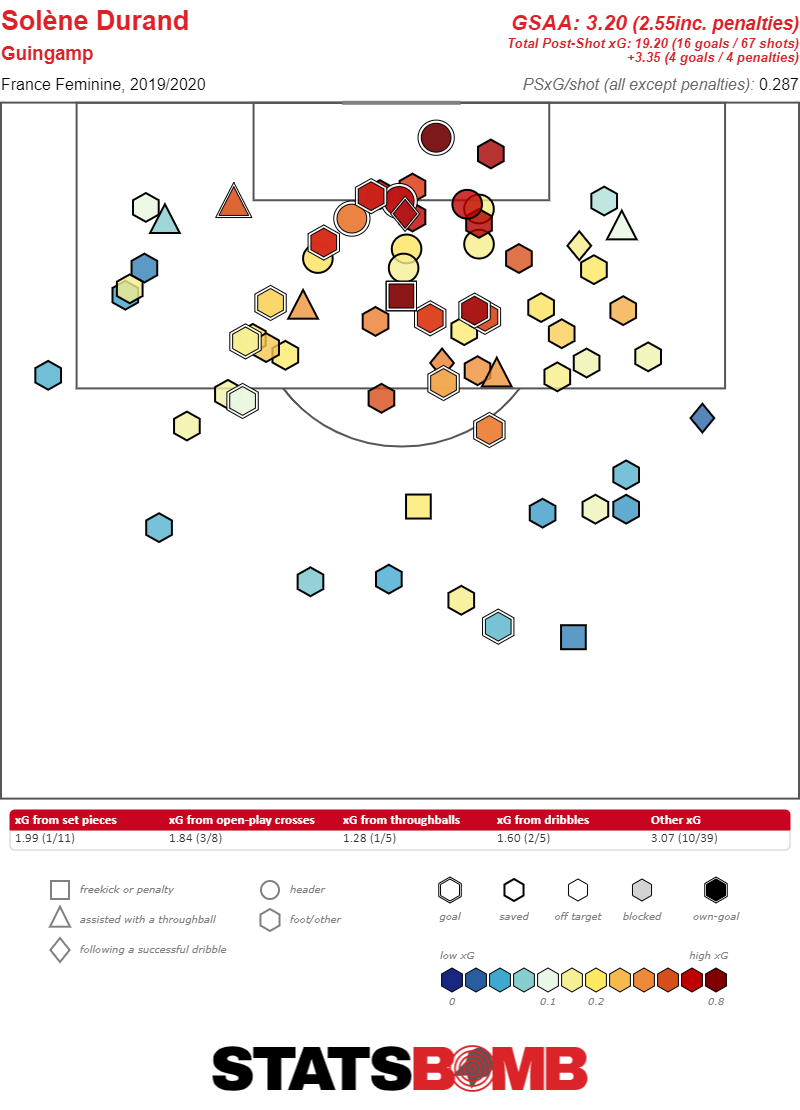 A side that could yet go tumbling down the well in future seasons, Fleury 91 started life out in the division promisingly enough but have slowed to a near-halt in recent times. With talented yet underperforming players, the increasingly porous team may yet benefit from moving away from their current first choice goalkeeper, Laëtitia Philippe..
A side that could yet go tumbling down the well in future seasons, Fleury 91 started life out in the division promisingly enough but have slowed to a near-halt in recent times. With talented yet underperforming players, the increasingly porous team may yet benefit from moving away from their current first choice goalkeeper, Laëtitia Philippe.. 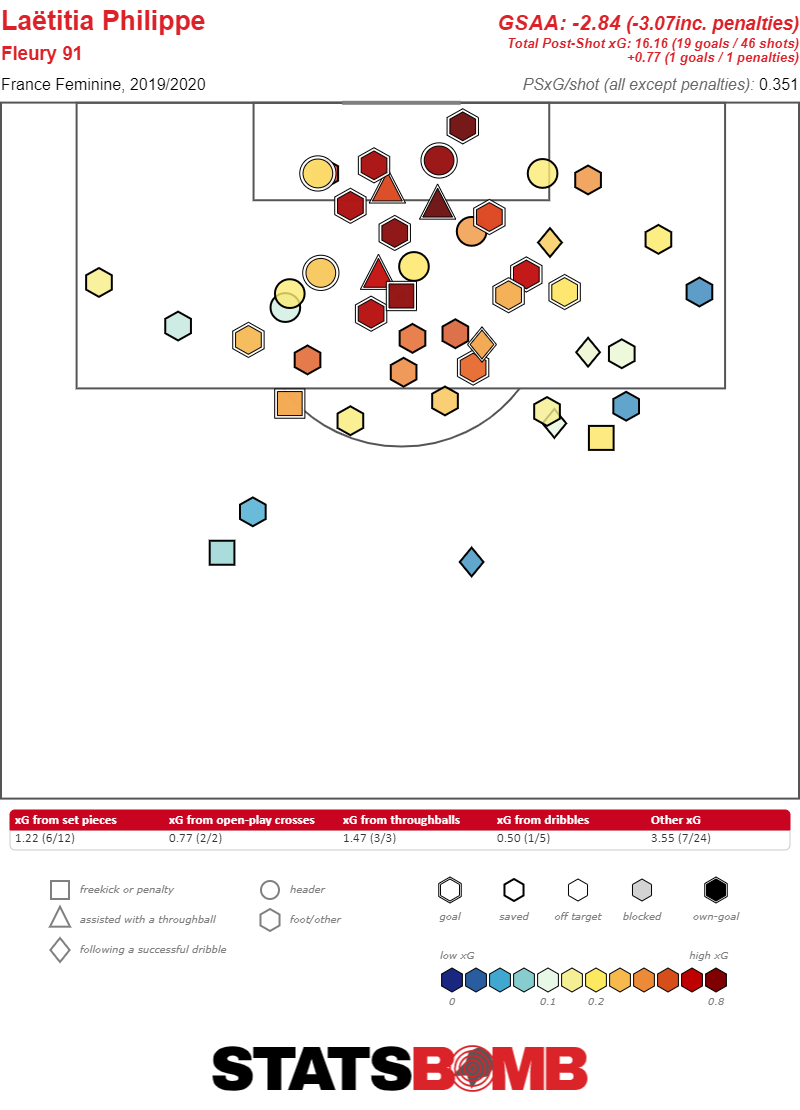 Like Fleury, ASJ Soyaux’s days (or seasons) in D1F seem numbered. In their seventh consecutive season in the league, Soyaux are on track to record their lowest points tally since promotion in 2012-13. Except for an early season win over Guingamp, Soyaux have failed to beat a team placed above them in the table, the side seemingly having peaked before Christmas and struggling more and more with each passing game. Having not changed personnelle (on the pitch, or in the dugout) from last season, there is no logic to the decline; the team one that looks equally laborious in and out of possession. Just about treading water this season, thanks in part to Sarah Cambot’s handful of goals – including a sublime bicycle kick against Dijon – the future for Soyaux seems a bleak one.
Like Fleury, ASJ Soyaux’s days (or seasons) in D1F seem numbered. In their seventh consecutive season in the league, Soyaux are on track to record their lowest points tally since promotion in 2012-13. Except for an early season win over Guingamp, Soyaux have failed to beat a team placed above them in the table, the side seemingly having peaked before Christmas and struggling more and more with each passing game. Having not changed personnelle (on the pitch, or in the dugout) from last season, there is no logic to the decline; the team one that looks equally laborious in and out of possession. Just about treading water this season, thanks in part to Sarah Cambot’s handful of goals – including a sublime bicycle kick against Dijon – the future for Soyaux seems a bleak one. 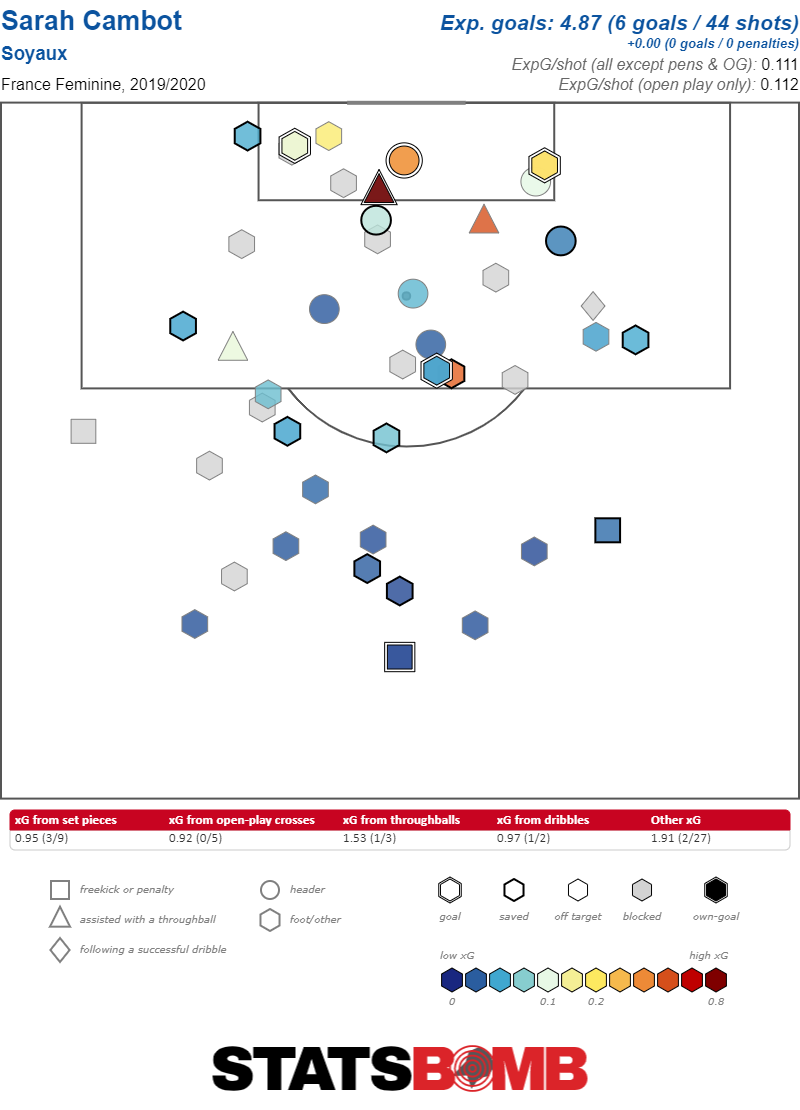 The newest addition to the league, Stade de Reims, have had the customary bumpy welcome but often have good ideas when they’re on the ball. Still acclimatising to the tempo of the top tier, Reims’ naivete in defence has led to them conceding from four penalties – only Marseille and Metz have conceded from more. The good news for the team is that those penalties overshadow a defense that otherwise would rank a respectable seventh in the league, just barely below average. Cut out the penalties and they might be able to hang around.
The newest addition to the league, Stade de Reims, have had the customary bumpy welcome but often have good ideas when they’re on the ball. Still acclimatising to the tempo of the top tier, Reims’ naivete in defence has led to them conceding from four penalties – only Marseille and Metz have conceded from more. The good news for the team is that those penalties overshadow a defense that otherwise would rank a respectable seventh in the league, just barely below average. Cut out the penalties and they might be able to hang around. 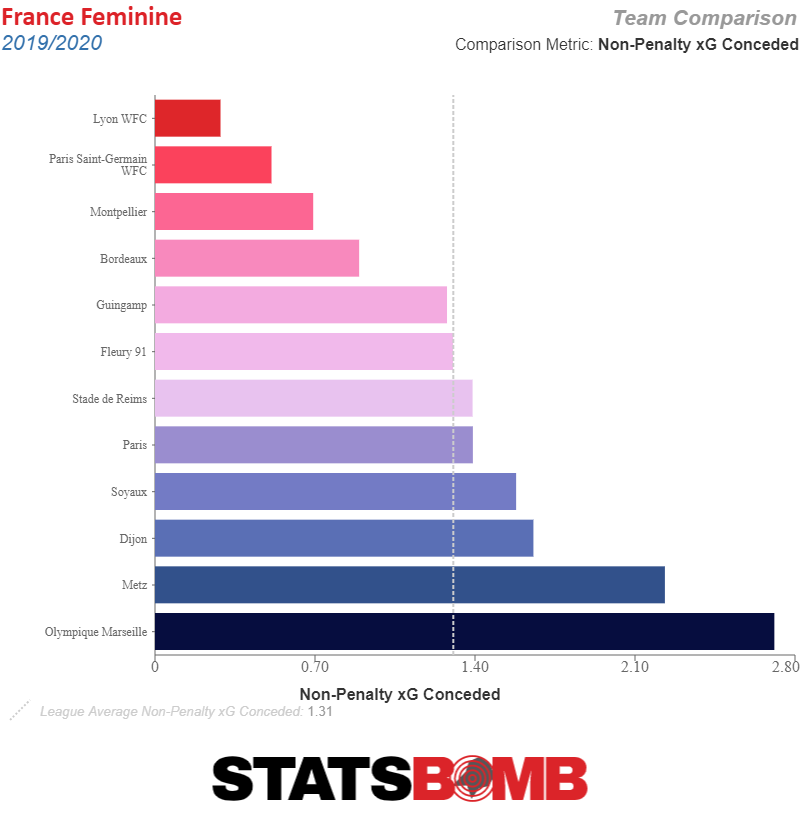 The final side that should be safe this year, Dijon consistently struggle to impress and have issues with creating chances from open play while remaining leaky at the back. Not one of the youngest teams in the league, the supposed experience of the side seems to amount to very little. Even though Dijon have one of the worst concession numbers in the league, they do boast a goalkeeper, Emmeline Mainguy, who is a dab hand at claiming crosses. Yet the goalkeeper is too often let down by the defence in front of her. She is, in fact, the most aggressive keeper in the league attempting claims on 12.5% more balls into her area than an average keeper would, the largest such gap in France’s first division. Who knows where the side would be without her commanding presence.
The final side that should be safe this year, Dijon consistently struggle to impress and have issues with creating chances from open play while remaining leaky at the back. Not one of the youngest teams in the league, the supposed experience of the side seems to amount to very little. Even though Dijon have one of the worst concession numbers in the league, they do boast a goalkeeper, Emmeline Mainguy, who is a dab hand at claiming crosses. Yet the goalkeeper is too often let down by the defence in front of her. She is, in fact, the most aggressive keeper in the league attempting claims on 12.5% more balls into her area than an average keeper would, the largest such gap in France’s first division. Who knows where the side would be without her commanding presence. 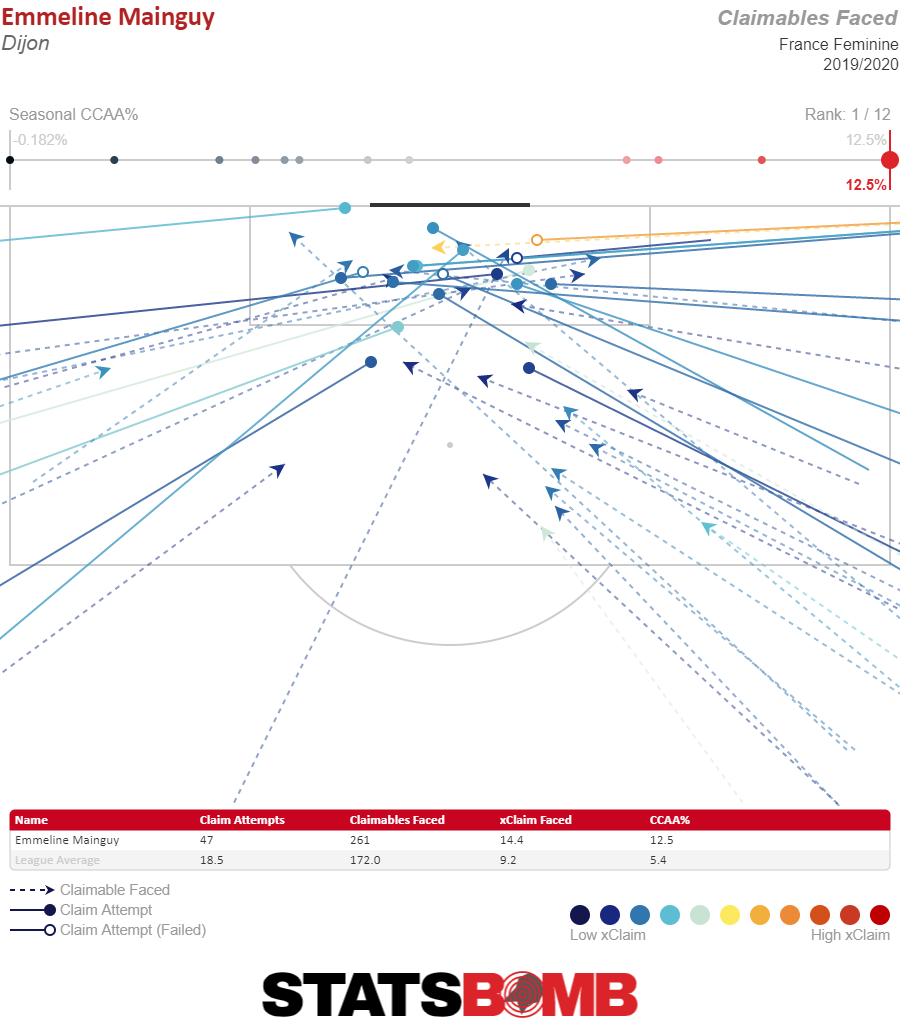
Au revoir
For Olympique Marseille, this season has been quite the disappointment. There’s not one particular thing the side has failed at, but rather they appear just below par across the pitch, looking every part a D2F team.. Having been inflicted with the heaviest defeats the league has seen this season, the team have frequently looked static especially in defence, slow to close down threats. A major problem for a team that does almost all of its defending in and around its own penalty area. 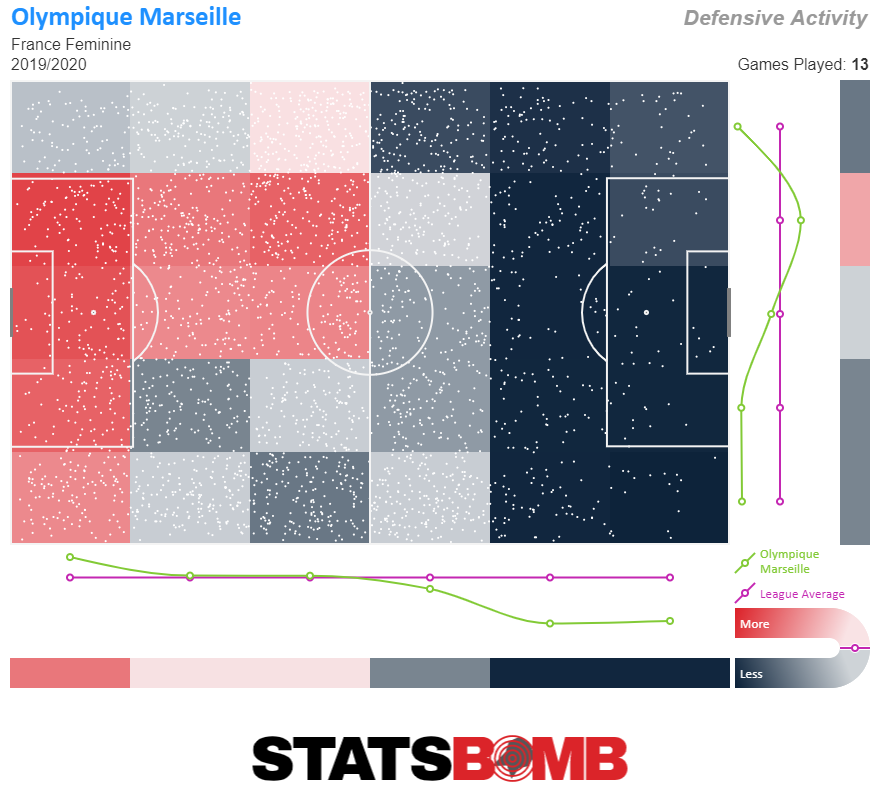 OM’s inability to act quickly enough in defence is all too obvious when you consider just how often they’ve conceded from set pieces this season. Although, with ten goals conceded from only 6.5 expected, it’s quite possible that they’re getting unlucky in addition to not being good enough.
OM’s inability to act quickly enough in defence is all too obvious when you consider just how often they’ve conceded from set pieces this season. Although, with ten goals conceded from only 6.5 expected, it’s quite possible that they’re getting unlucky in addition to not being good enough. 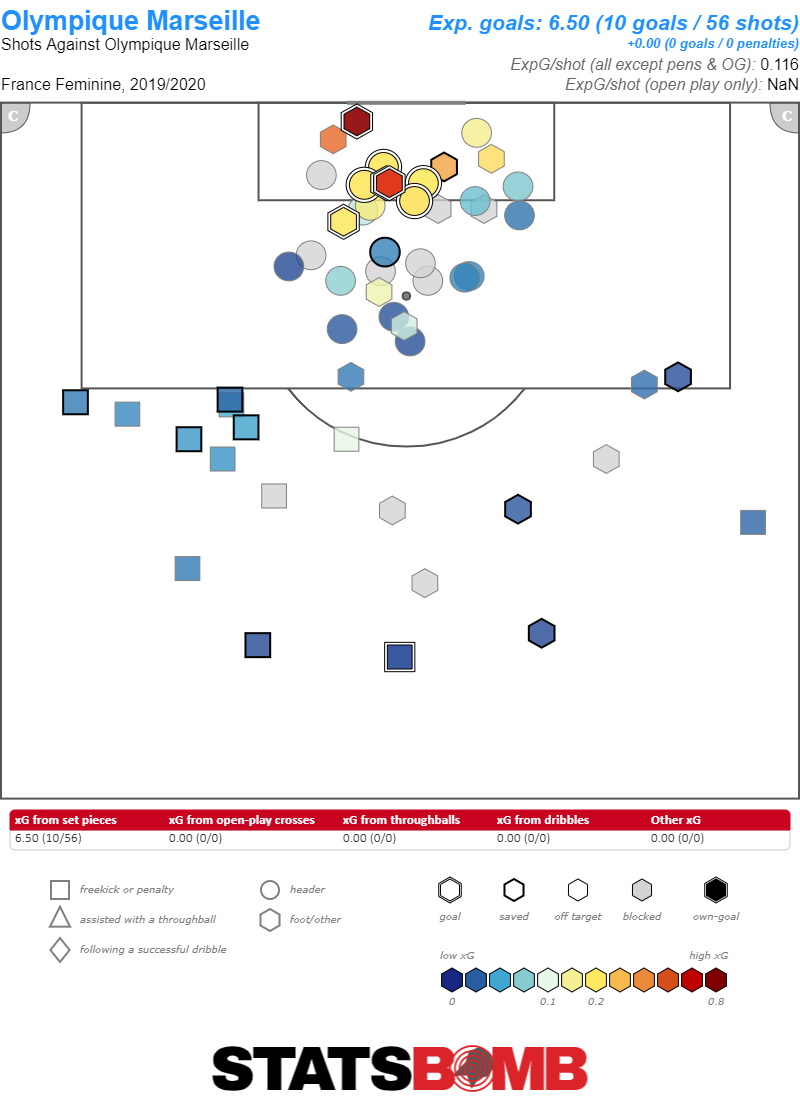 Another team that have looked like girls against women from the off this season, Metz have only found the back of the net 7 times in 16 outings this term, a number that looks even worse when you strip out a penalty and an own goal. For a team that looks destined to go down, it will be a cold comfort that xG suggests they were somewhat unlucky not to have scored a few more.
Another team that have looked like girls against women from the off this season, Metz have only found the back of the net 7 times in 16 outings this term, a number that looks even worse when you strip out a penalty and an own goal. For a team that looks destined to go down, it will be a cold comfort that xG suggests they were somewhat unlucky not to have scored a few more. 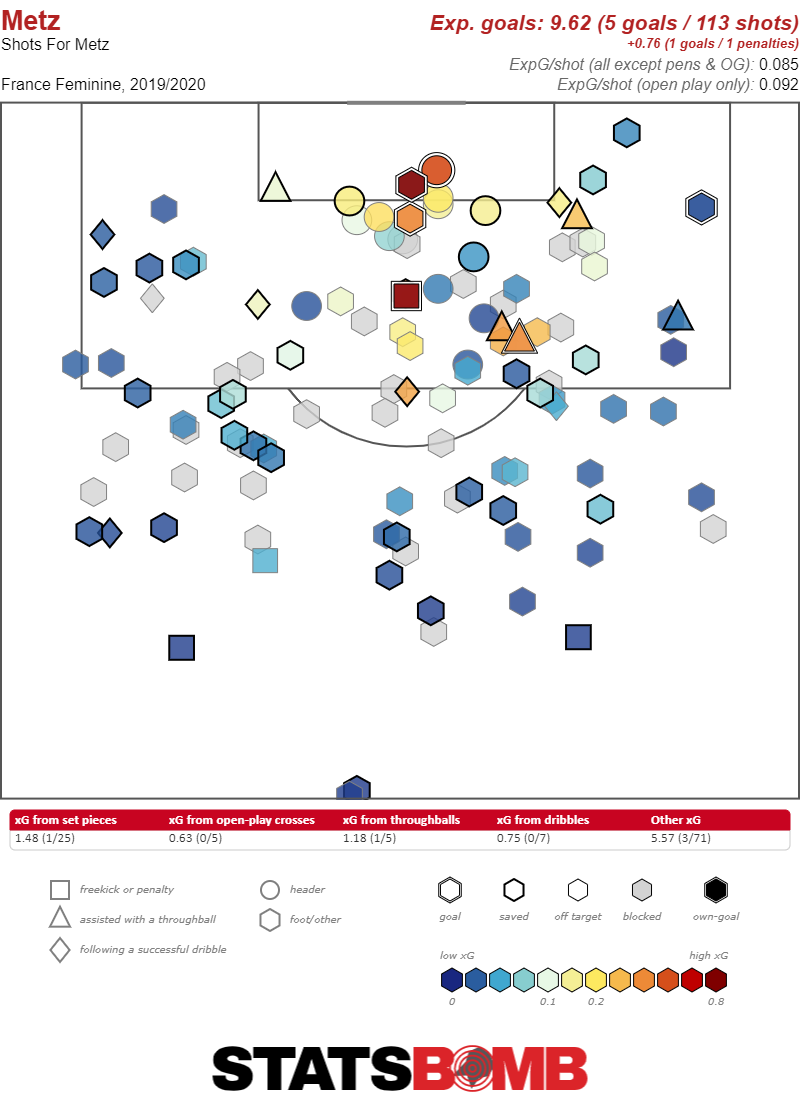 It’s all been far too insipid across the pitch. The team is quick to give possession away and far too flimsy when it comes to trying to win the ball back. Susceptible from range as well as in their own six-yard box, there is little hope left for Metz who — like many before them — seem destined for [at best] yo-yoing between the second and first tiers, never able to make any meaningful progress.
It’s all been far too insipid across the pitch. The team is quick to give possession away and far too flimsy when it comes to trying to win the ball back. Susceptible from range as well as in their own six-yard box, there is little hope left for Metz who — like many before them — seem destined for [at best] yo-yoing between the second and first tiers, never able to make any meaningful progress.
France: Women’s Data Announcement
An equal playing field is important to StatsBomb. We continue to look for new ways to support the acceleration of the Women’s game globally and as part of our commitment to International Women’s Day, we are opening up access to our 2019-20 and 2020-21 French Féminine data and analytics for FREE to all the teams in that league. Back in 2018, we wanted to propel knowledge of the Women’s game and offered our industry leading, quality data specification for a selection of Women’s leagues for free. This was alongside tuition resources, support and advice to help boost the application of data analysis in the Women’s game. It is exciting to see analysts, bloggers and fans creating analysis, data visualisations and gifs all entirely focused on Women’s football, especially where StatsBomb’s detailed data spec provides unique insight into pass footedness and defensive pressure activity that is not available in the public domain for the Men’s game. However, we recognised there was more we could do to remove barriers in the Women’s game and help the clubs themselves use data and analytics to enhance performance. As our quality data and insight can help drive improvements on the pitch, we needed to address barriers around cost and expertise experienced by Women’s teams. So in 2019, all FAWSL Women’s teams were offered free access to our analytics platform, StatsBomb IQ, along with all the detailed statistical modelling for the FAWSL 2019-20 season. Most of the teams have taken up the offer and have integrated data analysis into their internal processes across tactical match analysis and opposition analysis. We have also been working more closely with English Women’s teams in applying data and insight to develop coaching practices. This year, our ambitions are to increase inclusion in other European leagues, so we are excited to announce that we are offering FREE 2019-20 and 2020-21 data to all France Féminine teams. This includes completely free access to our industry leading analytics platform, StatsBomb IQ and training in using the platform. The platform is designed to be intuitive, easy to navigate and enables real practical insight. Whether comparing overall team performance on key metrics, evaluating players or reviewing matches, StatsBomb IQ enables a complete, one-stop solution for use from the pitch to the boardroom. We are hoping that by making our platform available from now through the 2020-21 season and giving free training from our highly experienced analysts, France Féminine teams can enhance their pre- and post-match analysis workflow. Continuing our ambitions to ensure that Women’s football does not miss out on the data revolution that is happening in the Men’s game.
Bundesliga roundup: Bayern without Lewandowski, Timo Werner's slump, and more
Usually, this weekly StatsBomb Bundesliga Digest focuses on one subject. But there’s a lot to talk about this week, so let’s hit four talking points today. Off we go.
Remplacement needed for injured Robert Lewandowski
So, yeah. Bayern were amazing in midweek. Sure, the thorough beating of Chelsea in London was somewhat expected for those who follow the Bundesliga and Premier League on a detailed, weekly basis. But the fashion in which Der Rekordmeister put aside manager Frank Lampard’s squad, was downright impressive. Shortly after the game, Raphael Honigstein reported that Bayern chairman Karl-Heinz Rummenigge strongly hinted at the post-match banquet that interim manager Hansi Flick will get the nod as the permanent hire. Which, in all fairness, is something he has deserved with the sound turnaround of Bayern under his guidance. There was one bit of bad news to be reported post-Chelsea as well. Striker Robert Lewandowski will be sidelined for a couple of weeks due to a shinbone injury. So Bayern will have to replace a god-level frontman in the upcoming weeks. 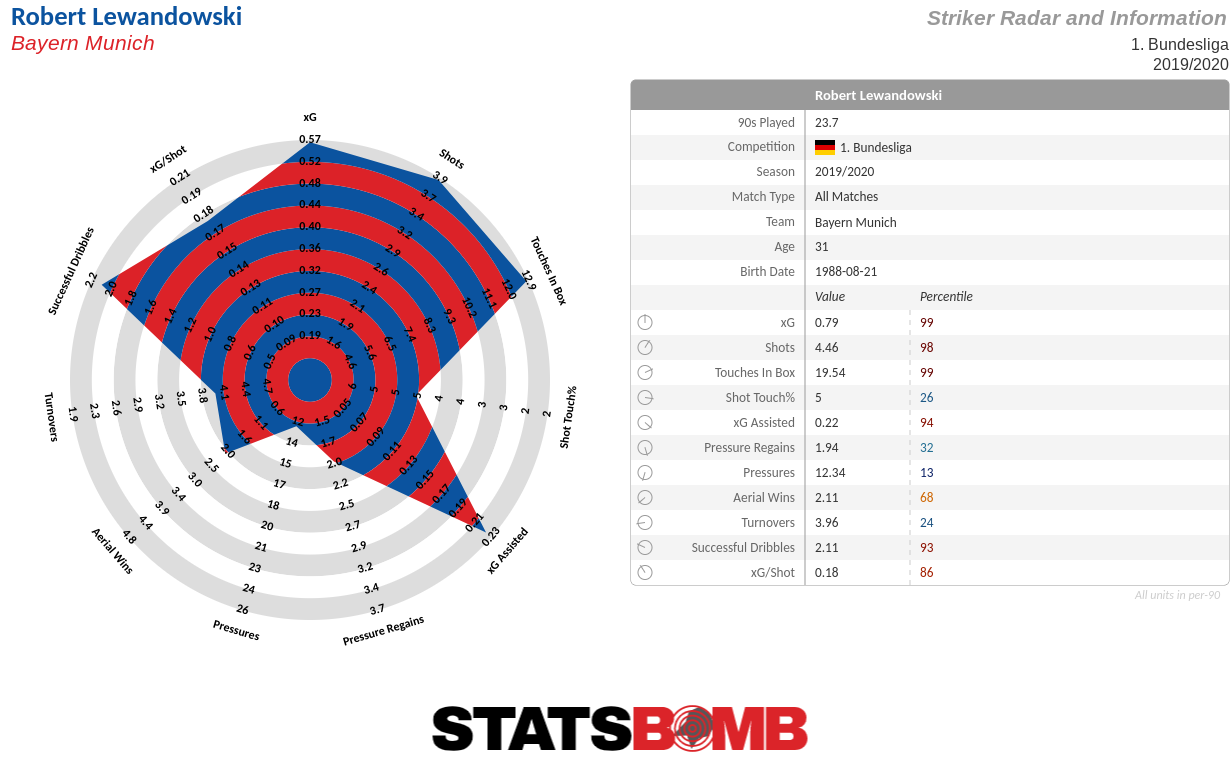 While Dutch teenager Joshua Zirkzee has shown promise in Bayern’s second squad and the youth teams - and has scored twice in his first ten minutes of Bundesliga football this season as a ‘Joker’ from the bench during hectic finishes - it does not likely that the hard-pressing squad of Flick will give the striker keys to an unproven 18-year old. The logical solution to Lewandowski’s absence seems to be giving Thomas Müller a different role. The veteran energizer bunny dominated Chelsea with his off-ball runs and smart positioning as Bayern’s central attacking midfielder, but still has an excellent knack of getting good shots in a semi-striker-like role.
While Dutch teenager Joshua Zirkzee has shown promise in Bayern’s second squad and the youth teams - and has scored twice in his first ten minutes of Bundesliga football this season as a ‘Joker’ from the bench during hectic finishes - it does not likely that the hard-pressing squad of Flick will give the striker keys to an unproven 18-year old. The logical solution to Lewandowski’s absence seems to be giving Thomas Müller a different role. The veteran energizer bunny dominated Chelsea with his off-ball runs and smart positioning as Bayern’s central attacking midfielder, but still has an excellent knack of getting good shots in a semi-striker-like role. 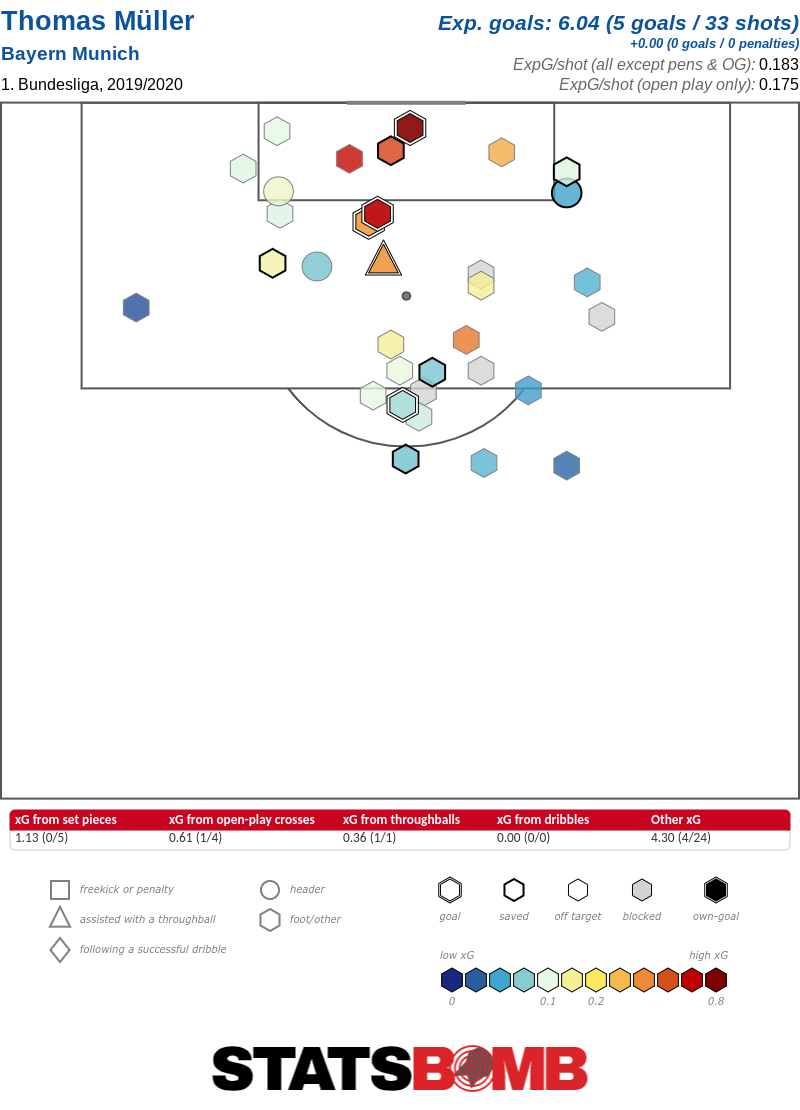 Shifting Müller up top will open up the 10 position in Flick’s formation. Lewandowski’s absence seems to be an ideal time for Leon Goretzka to definitively prove that he should be a day-in and day-out starter for Bayern.
Shifting Müller up top will open up the 10 position in Flick’s formation. Lewandowski’s absence seems to be an ideal time for Leon Goretzka to definitively prove that he should be a day-in and day-out starter for Bayern. 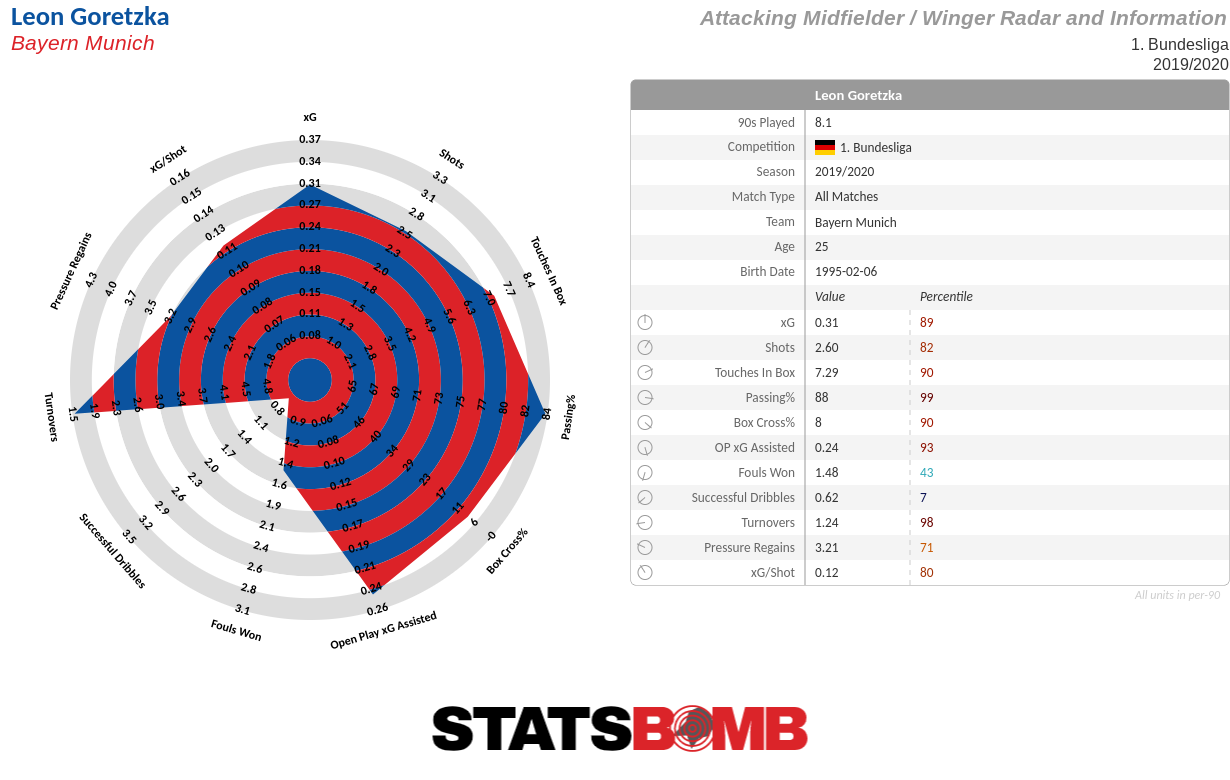 Giving more minutes to Barça loanee Philippe Coutinho in the upcoming weeks is also a possibility in case Müller does play as the central striker. The Brazilian will probably get his minutes as an inverted left-winger in the next game or two, with Ivan Perisic still out injured and Kingsley Coman picking up his umteenth knock in London in midweek.
Giving more minutes to Barça loanee Philippe Coutinho in the upcoming weeks is also a possibility in case Müller does play as the central striker. The Brazilian will probably get his minutes as an inverted left-winger in the next game or two, with Ivan Perisic still out injured and Kingsley Coman picking up his umteenth knock in London in midweek. 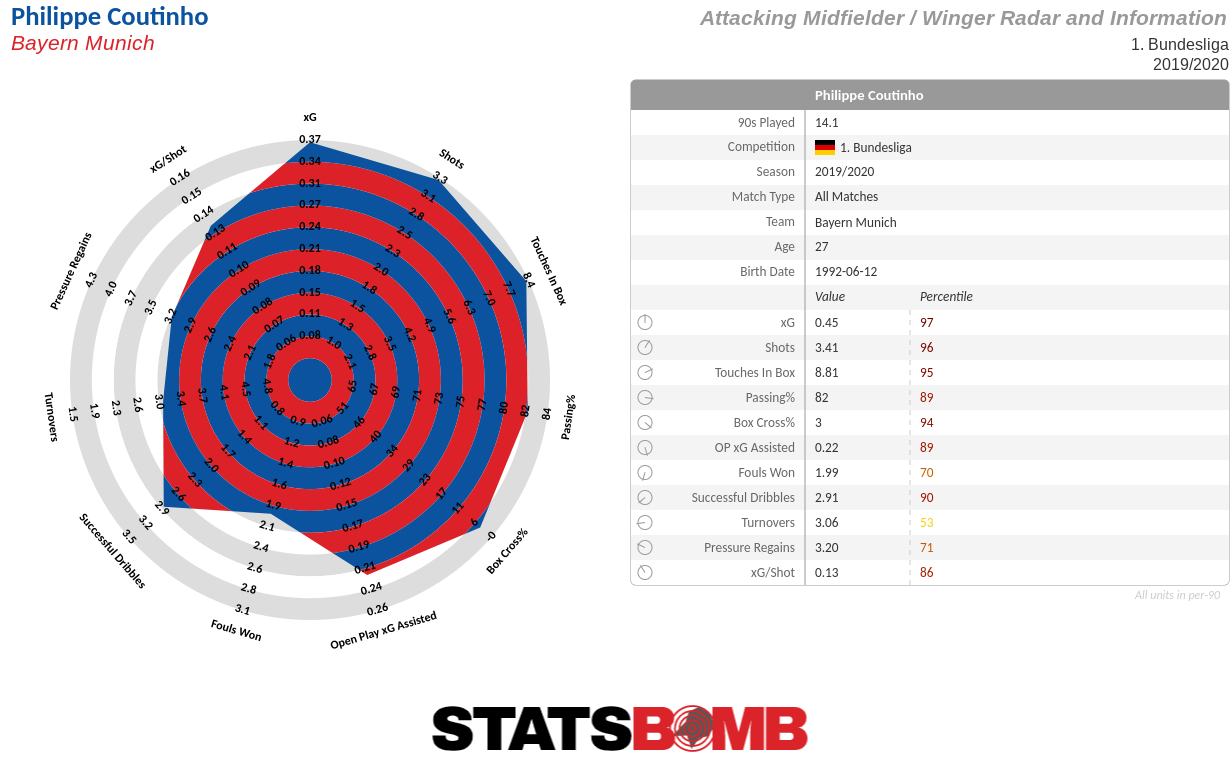 Although Bayern do not seem all too willing to pay up the big bucks required to definitively buy Coutinho from the Catalans next summer, we shouldn’t get too caught up in the narrative that the technically very gifted Brazilian’s career is in a sharp downward spiral. Yes, Coutinho has been inconsistent in Munich as well, but his peaks are still very high.
Although Bayern do not seem all too willing to pay up the big bucks required to definitively buy Coutinho from the Catalans next summer, we shouldn’t get too caught up in the narrative that the technically very gifted Brazilian’s career is in a sharp downward spiral. Yes, Coutinho has been inconsistent in Munich as well, but his peaks are still very high.
Timo Werner in 2020: slump or nah?
This should come as no surprise to anyone who slightly follows German football, but Werner was on an absolute tear before the winter break. 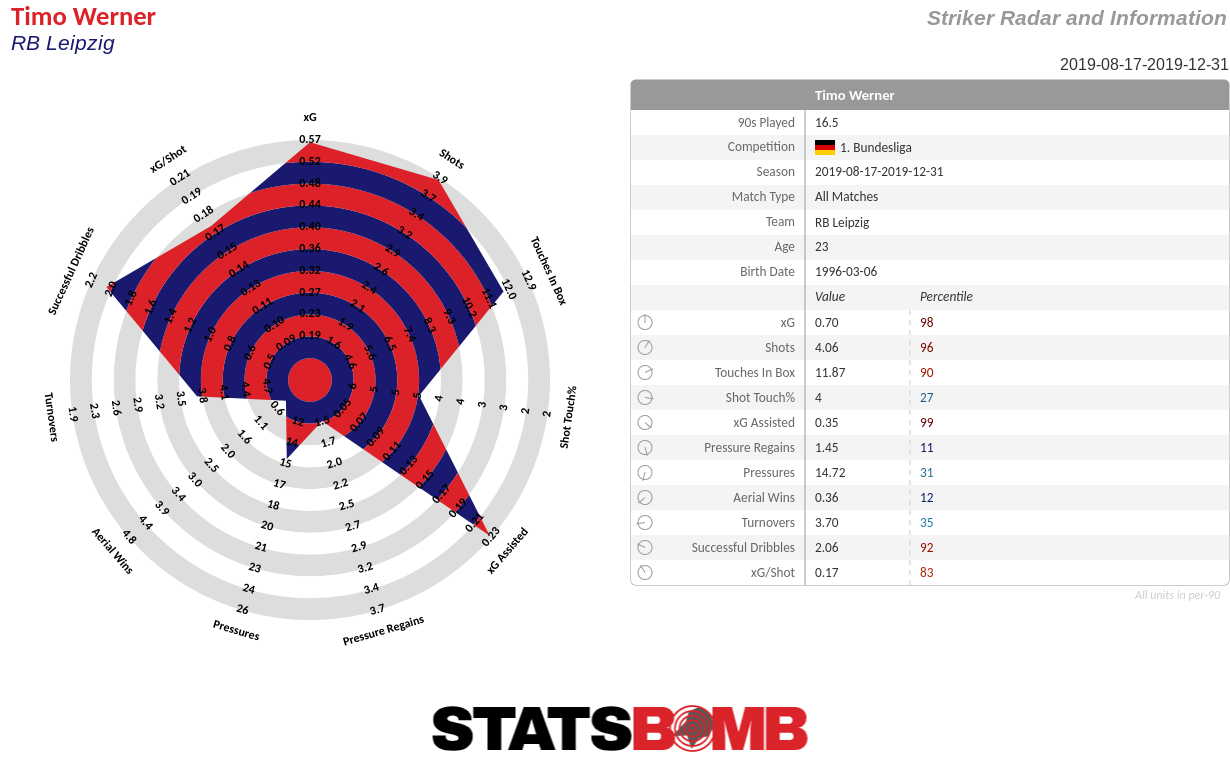 But in a four week period in 2020, Werner went on a five game stretch with no goal or assist. His underlying numbers in the new year also seem to suggest something was up with the RB Leipzig superstar.
But in a four week period in 2020, Werner went on a five game stretch with no goal or assist. His underlying numbers in the new year also seem to suggest something was up with the RB Leipzig superstar. 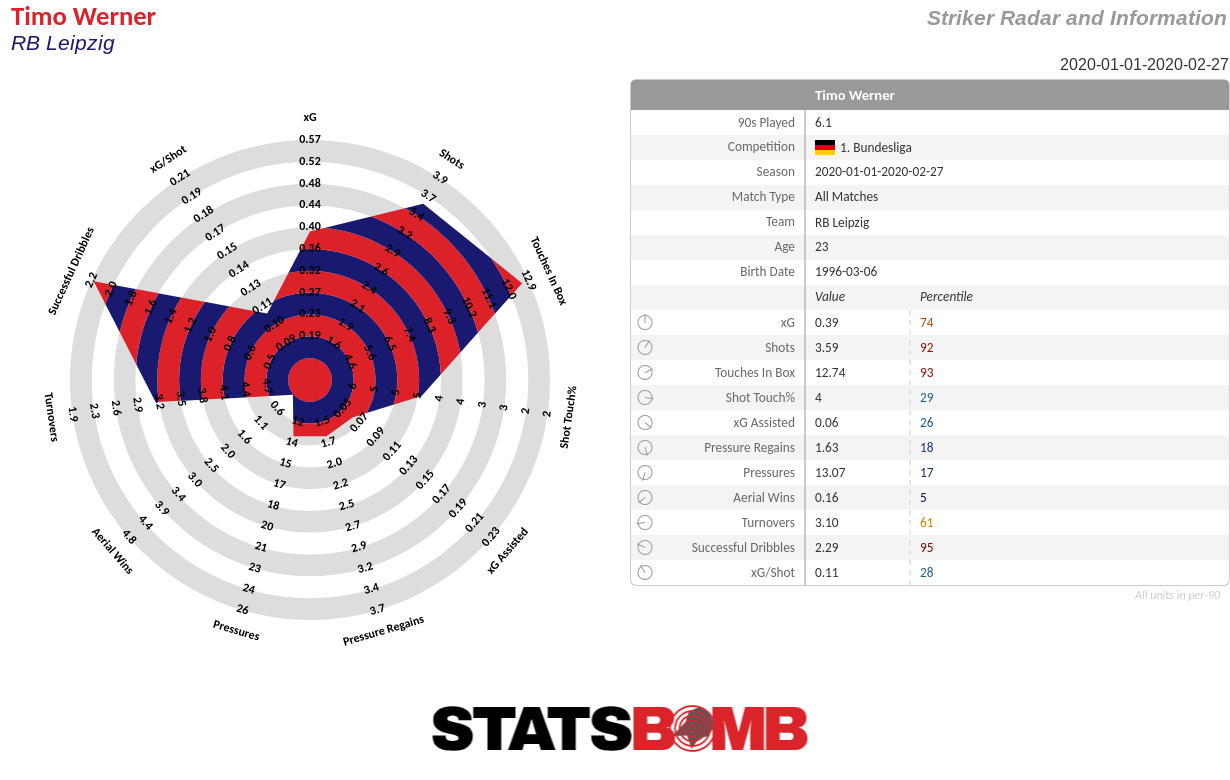 With two goals and an assist in his last two games (against Tottenham and Schalke), Werner seems to have regained his form. But whatever was bothering him in the weeks before - be it a fitness issue, fatigue, a case of ‘transfer fever’ (with Liverpool explicitly in the market for him) or just a spell of poor form - was something real, and not just a dose of bad luck.
With two goals and an assist in his last two games (against Tottenham and Schalke), Werner seems to have regained his form. But whatever was bothering him in the weeks before - be it a fitness issue, fatigue, a case of ‘transfer fever’ (with Liverpool explicitly in the market for him) or just a spell of poor form - was something real, and not just a dose of bad luck.
Why Bayer Leverkusen are the ‘not-so-fast-my-friend’ team of the Bundesliga
When looking at the current Bundesliga league table, maybe the biggest surprise is Bayer Leverkusen. No, not the fact that they’re in fifth place. That’s a pretty Leverkusen-y place to be in the table. The fact that Peter Bosz’ squad is just six points behind league-leaders Bayern München is surprising though, given the up-and-down nature of Leverkusen’s form when you look at the team from an ‘eye-test’ point of view. Life seems to be good - like good-good - for Die Werkself at the moment. The squad has won six of its last seven league games, and is still active in both the DFB Pokal and Europa League. But not so fast there, my friend. Before you point to Leverkusen as a dark horse title contender, let’s have a little look at their underlying numbers. If we look at the rolling xG trendline, we actually see that this squad - who were quite unlucky, finishing-wise, in the opening months - is benefiting from some hot shooting and not-too-accurate opposition. 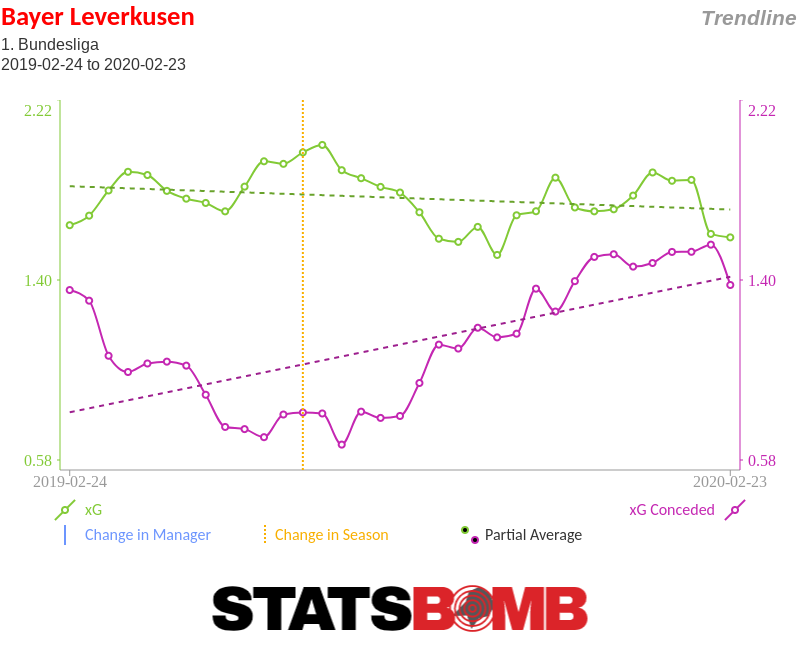 During Leverkusen’s period of six wins in seven league games, they’ve faced five teams from the bottom half of the league table (including three of the bottom four teams). That Leverkusen’s winning streak does not seem likely to extend much further, seems to come down to their defensive intensity. Bosz prefers a high-octane full-press as his team’s playing style, but Leverkusen have actually struggled somewhat this season when it comes to pressuring the opposing build-up.
During Leverkusen’s period of six wins in seven league games, they’ve faced five teams from the bottom half of the league table (including three of the bottom four teams). That Leverkusen’s winning streak does not seem likely to extend much further, seems to come down to their defensive intensity. Bosz prefers a high-octane full-press as his team’s playing style, but Leverkusen have actually struggled somewhat this season when it comes to pressuring the opposing build-up. 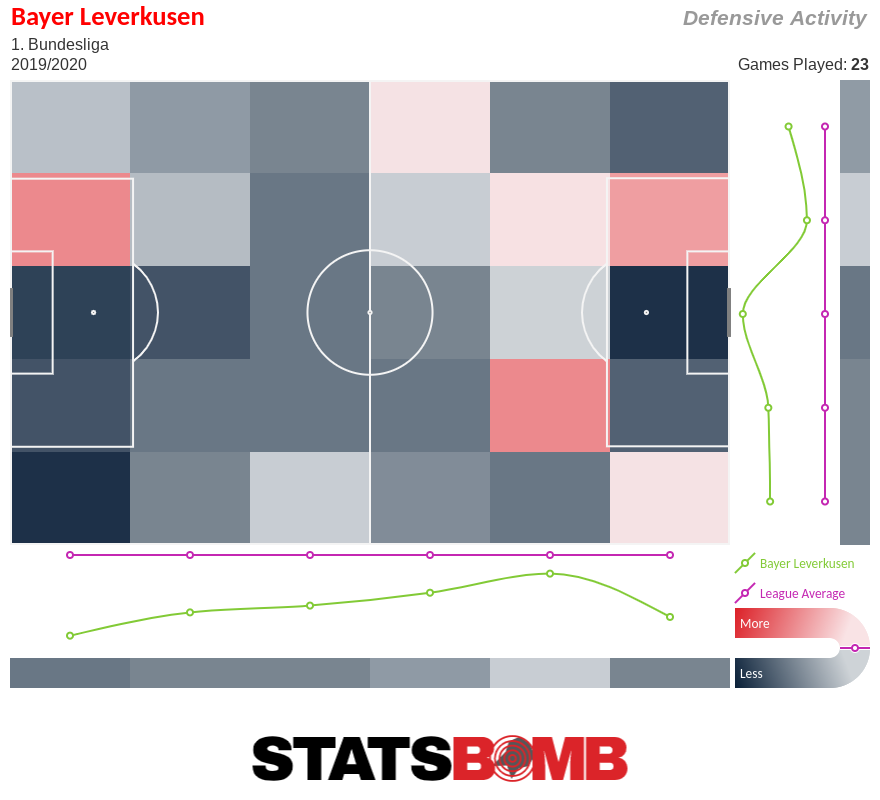
Schalke 04 should brace themselves for a hefty drop
Schalke were the big over-performers in the Bundesliga before the winter break. Manager David Wagner manufactured a lot of patchwork offensive efficiency with some smart lineups and tactical tweaks. But in 2020, the lack of actually good players in the squad has cost Schalke 04. Big time. Three disappointing draws were bookended by 5-0 losses against the two big cats of the league (Bayern and Leipzig) in the last stretch of games. 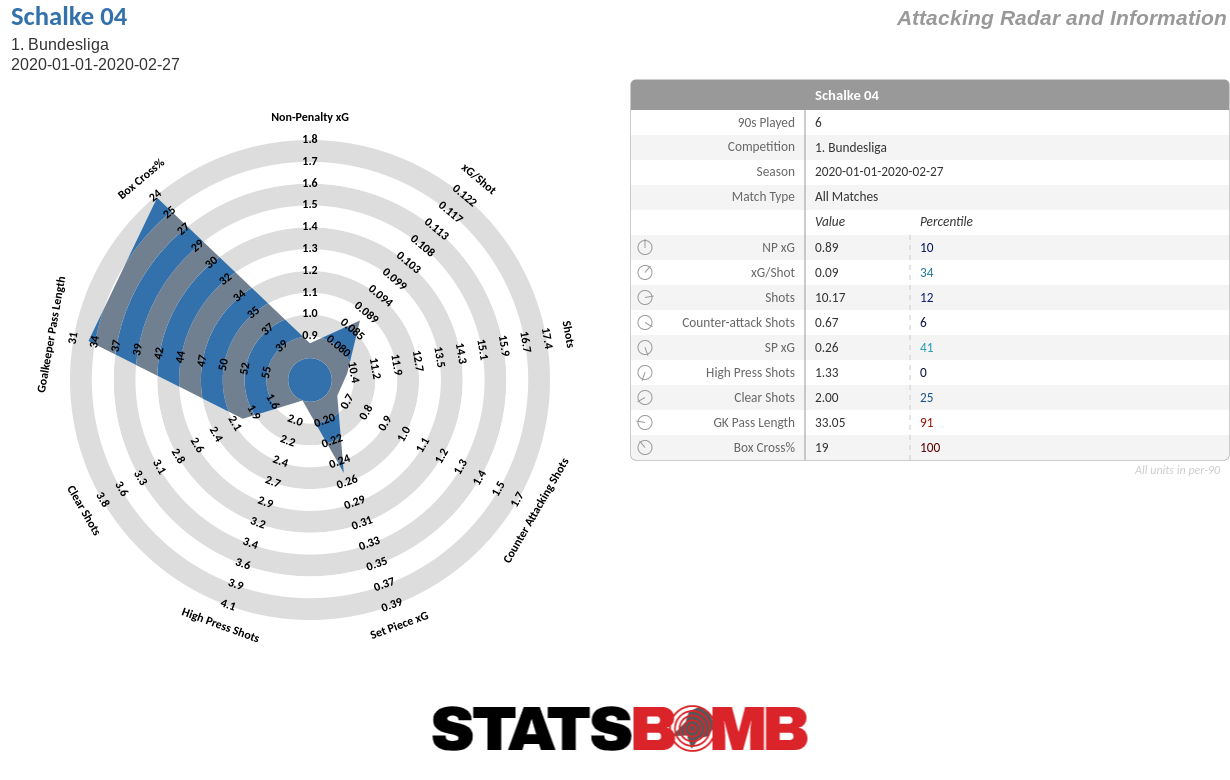 Schalke are still in sixth place, which would qualify them for next year’s Europa League at season’s end. But Die Königsblauen should probably aim for a league finish in the top half of the table when being somewhat realistic. Their attacking output has been really bad since the break. And a defensive skid is expected with the injury-caused absences of veteran defenders Benjamin Stambouli and Salif Sané.
Schalke are still in sixth place, which would qualify them for next year’s Europa League at season’s end. But Die Königsblauen should probably aim for a league finish in the top half of the table when being somewhat realistic. Their attacking output has been really bad since the break. And a defensive skid is expected with the injury-caused absences of veteran defenders Benjamin Stambouli and Salif Sané. 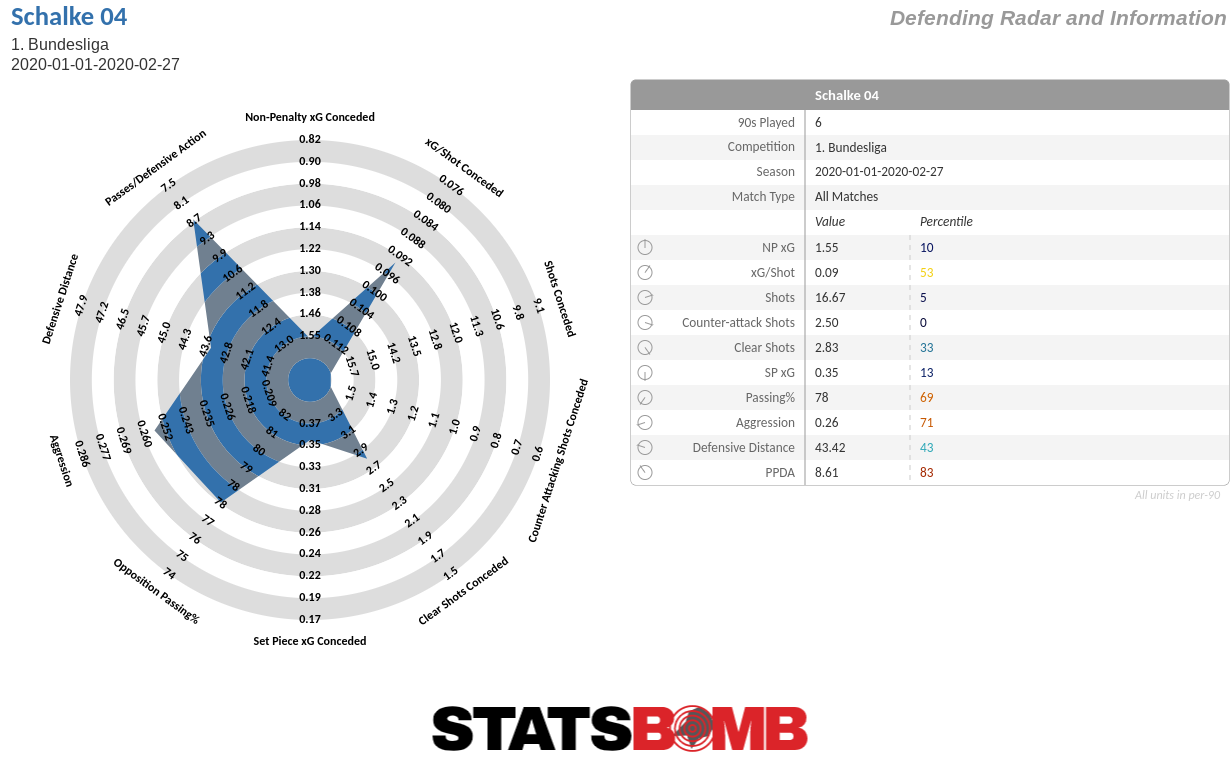
Weekly La Liga Roundup: Ángel Correa shines, Celta Vigo improves and more
It’s time for this week’s roundup of the action in La Liga: Celta Vigo’s improvement under Óscar García, Levante’s contrary approach, and Ángel Correa’s impressive season.
Improved Celta Vigo
There were valid concerns about off-pitch issues when Celta Vigo brought in Óscar García to replace head coach Fran Escribá in November, but it was always clear that García’s approach would be better suited to the squad than the reactive football of his predecessor. So it has proved. Celta have improved significantly in attack. 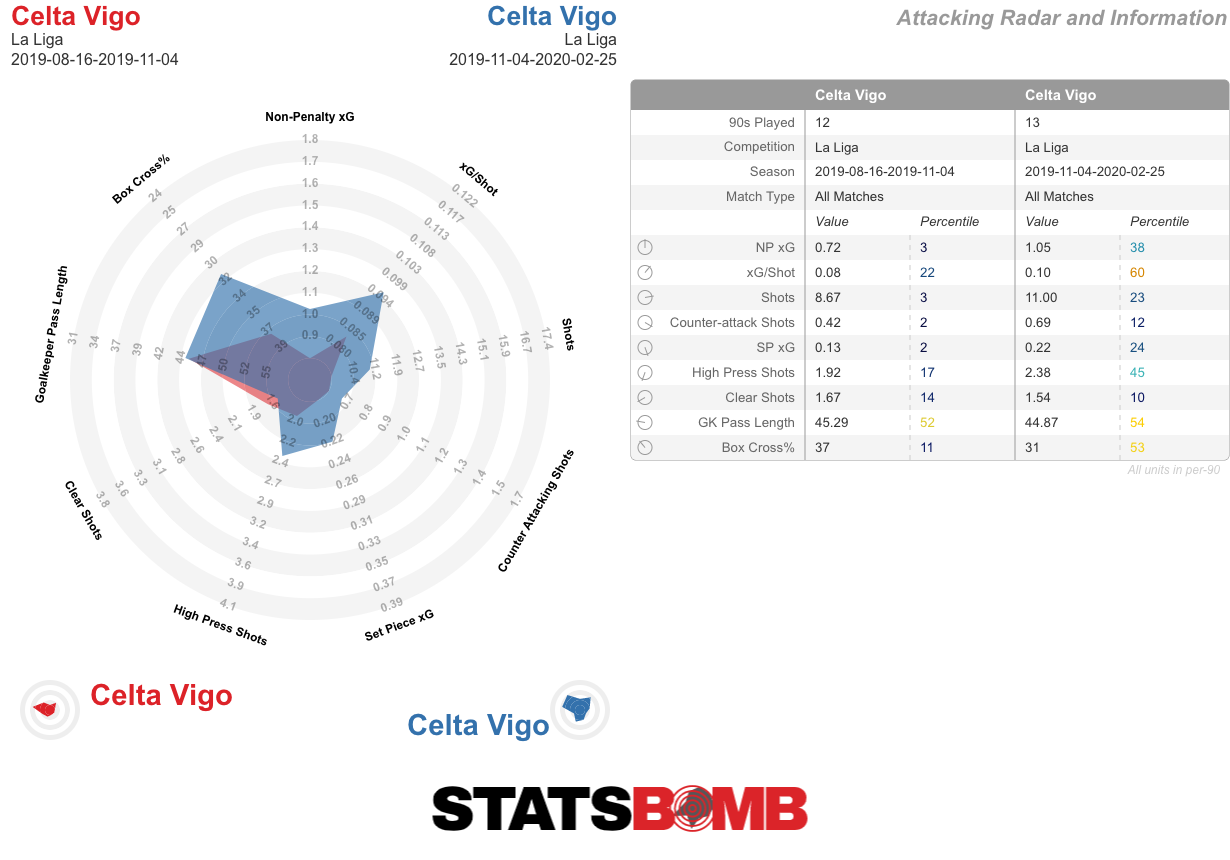 And marginally in defence.
And marginally in defence. 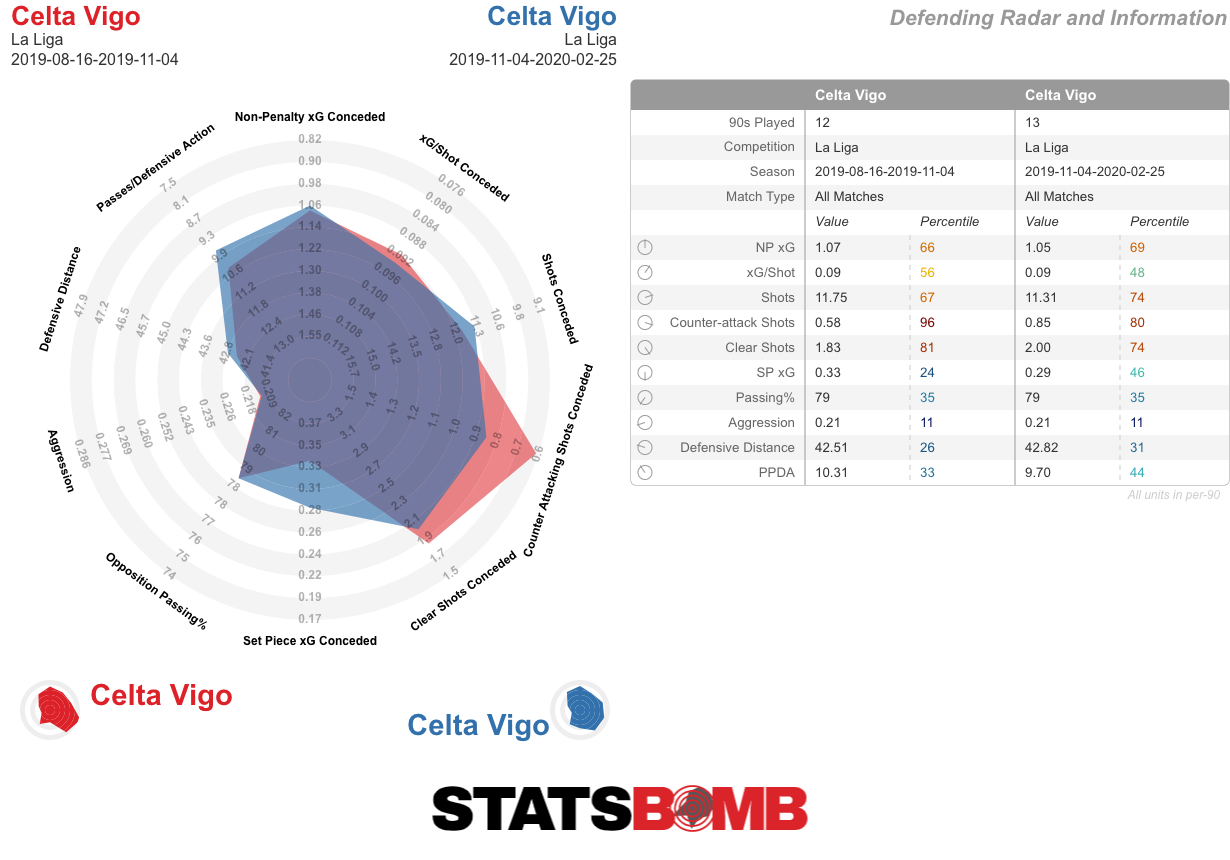 The end result is that a team that posted the league’s fifth-worst expected goal difference during their 12 matches under Escribá have since moved up to the eleventh-worst team in the league by that measure — six places higher from a run of 13 fixtures that included trips to both Barcelona and Real Madrid.
The end result is that a team that posted the league’s fifth-worst expected goal difference during their 12 matches under Escribá have since moved up to the eleventh-worst team in the league by that measure — six places higher from a run of 13 fixtures that included trips to both Barcelona and Real Madrid. 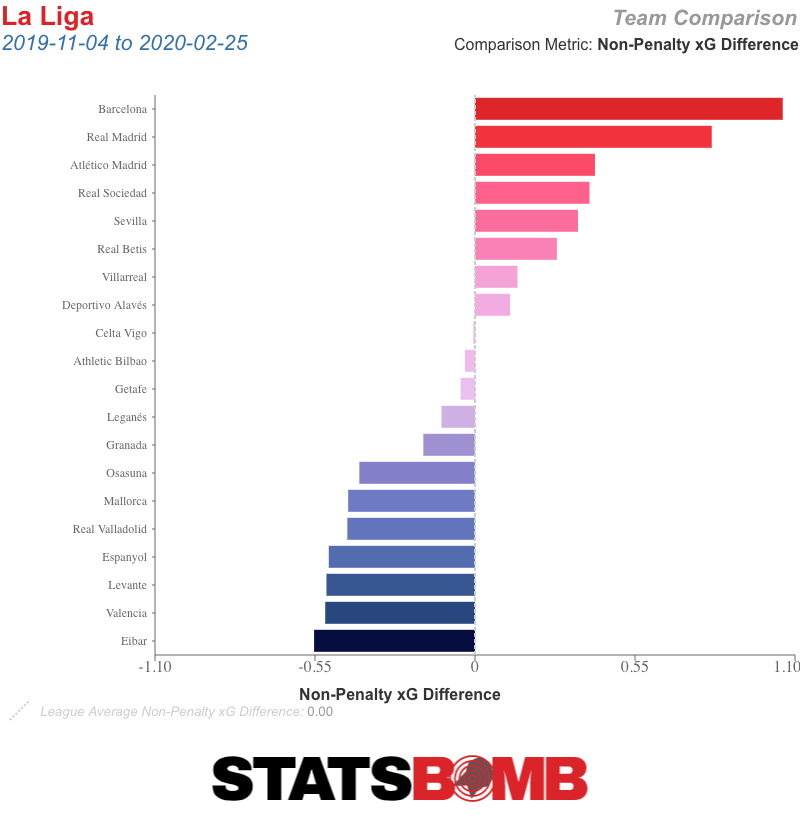 It took a little while for the results to catch up, but a win over Sevilla, a draw away at Madrid and Saturday’s 1–0 victory at home to direct rivals Leganés have lifted Celta out of the drop zone. Things down there could still go almost anywhere. Espanyol, Leganés, Mallorca, Celta and now Eibar are all scrapping it out to avoid filling the three relegation places. But Celta’s change in style, along with their January reinforcements, has given them a good foundation to help them avoid the drop.
It took a little while for the results to catch up, but a win over Sevilla, a draw away at Madrid and Saturday’s 1–0 victory at home to direct rivals Leganés have lifted Celta out of the drop zone. Things down there could still go almost anywhere. Espanyol, Leganés, Mallorca, Celta and now Eibar are all scrapping it out to avoid filling the three relegation places. But Celta’s change in style, along with their January reinforcements, has given them a good foundation to help them avoid the drop.
Levante, the Model Beaters
Levante produced the shock of the weekend with a 1–0 home win over Real Madrid, although perhaps it shouldn’t have been quite so unexpected given they'd already defeated Barcelona at the Estadio Ciudad de Valencia earlier this season. Paco López’s side are 10th in the league, closer on points to the top six than the bottom three, and comfortably on course for a fourth consecutive campaign of top-flight football. Which is all well and good, but their underlying numbers are horrible — the worst in La Liga. 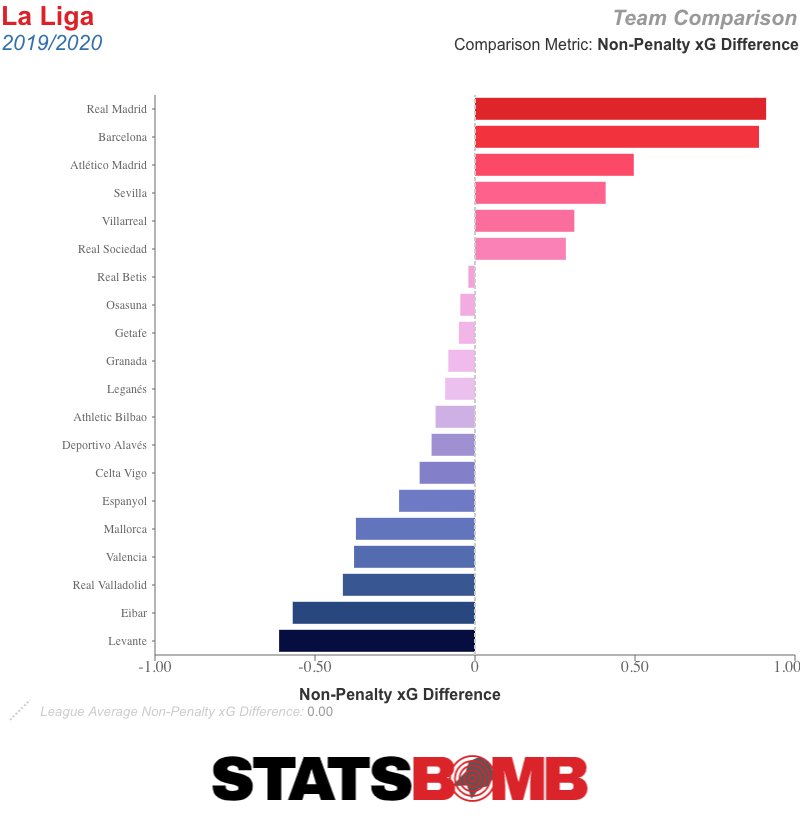 And last season, when they finished 15th, but a full seven points clear of the bottom three? Yep, same thing.
And last season, when they finished 15th, but a full seven points clear of the bottom three? Yep, same thing. 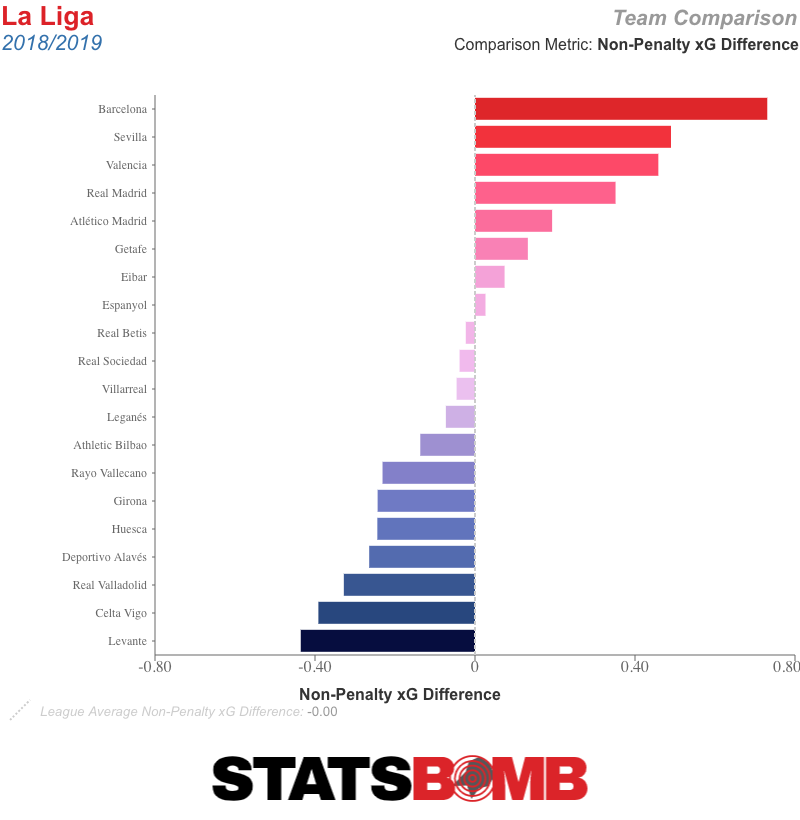 This has been a thing ever since López took charge in March 2018. The chart compares xG difference to actual goal difference (both excluding penalties) over time, using a 15-match rolling average. The green zone represents over-performance of the underlying numbers. The vertical blue line is when López replaced Juan Ramón Muñiz as head coach.
This has been a thing ever since López took charge in March 2018. The chart compares xG difference to actual goal difference (both excluding penalties) over time, using a 15-match rolling average. The green zone represents over-performance of the underlying numbers. The vertical blue line is when López replaced Juan Ramón Muñiz as head coach. 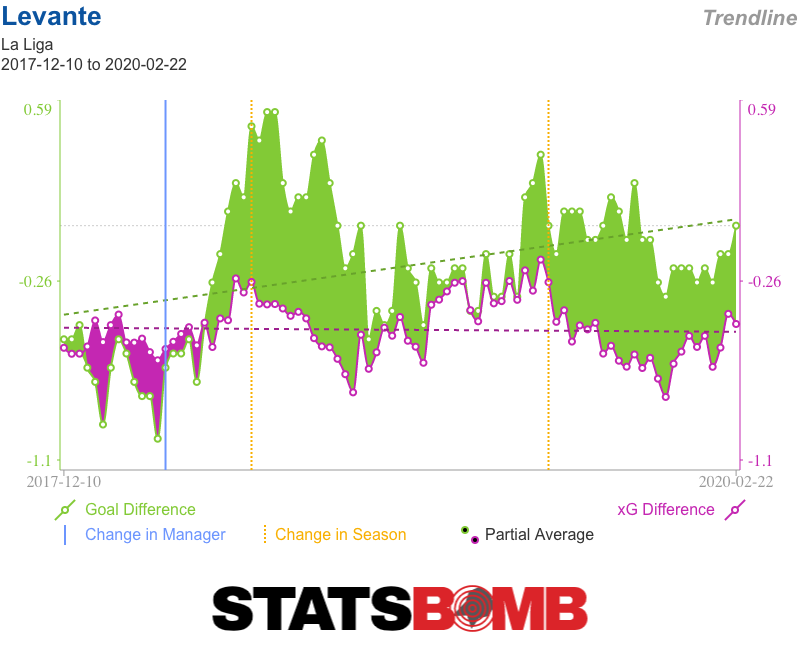 López’s Levante have consistently and fairly significantly out-performed their xG difference. They did so by 9 goals across his 11 matches in charge at the back end of 2017–18, by 12.5 goals in 2018–19, and they're doing it by over 10 goals this season. Only Barcelona, with Lionel Messi, are further ahead of their underlying numbers. The team is unusual because López’s approach is contrary to the prevailing style in Spain. In general, matches in La Liga feature low shot counts, while high defensive lines and strong pressure on the ball are becoming defining traits of the league. Levante, meanwhile, defend deep and passively, and involve themselves in back-and-forth shot-fests.
López’s Levante have consistently and fairly significantly out-performed their xG difference. They did so by 9 goals across his 11 matches in charge at the back end of 2017–18, by 12.5 goals in 2018–19, and they're doing it by over 10 goals this season. Only Barcelona, with Lionel Messi, are further ahead of their underlying numbers. The team is unusual because López’s approach is contrary to the prevailing style in Spain. In general, matches in La Liga feature low shot counts, while high defensive lines and strong pressure on the ball are becoming defining traits of the league. Levante, meanwhile, defend deep and passively, and involve themselves in back-and-forth shot-fests. 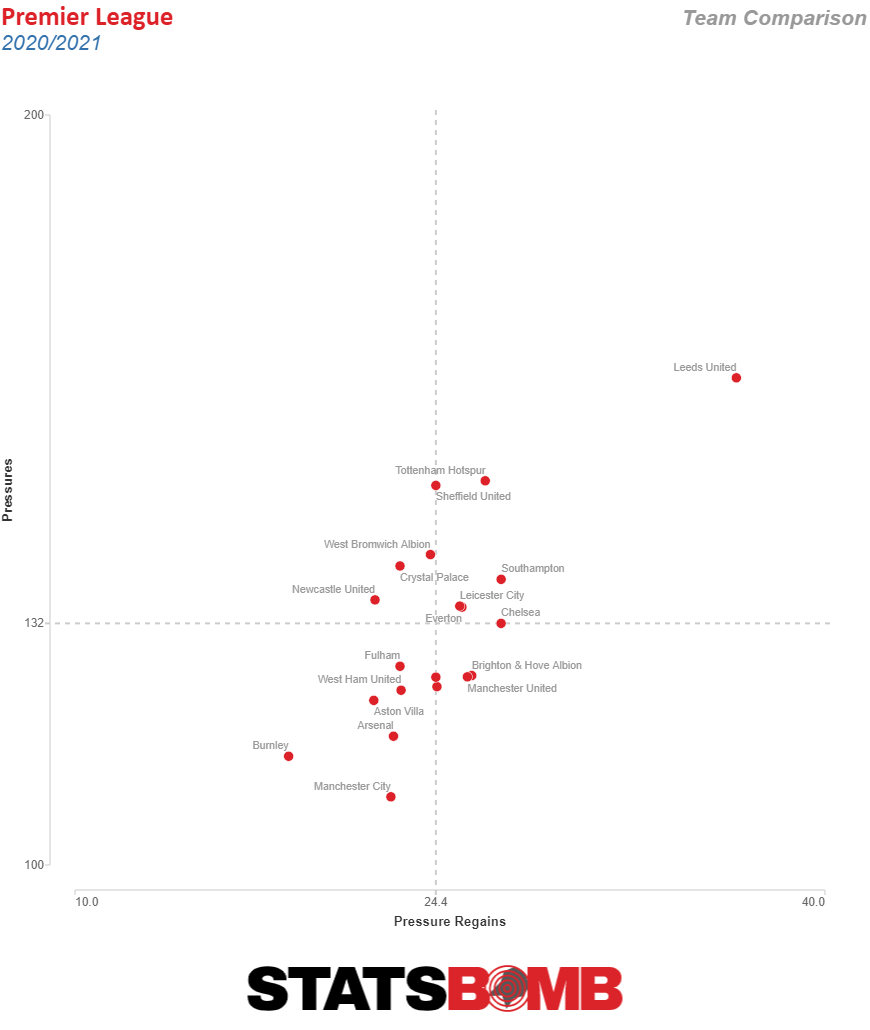 Levante’s matches feature a league-high average of 27.24 shots. Only Villarreal, at 26.76, are anywhere near them. After those two, the next highest average is under 24 shots per match. Unsurprisingly, Levante’s matches also feature more xG than those of any other side. Could it be that by going so obviously against the grain, they’ve slipped into some hole in the model? Interestingly, how Levante are beating their xG difference had changed this season. In both 2017–18 and 2018–19, the attack contributed around 70% of the over-performance; this season, the defensive side accounts for 88% of it. Much of that appears to be to the credit of goalkeeper Aitor Fernández, who has prevented over 12 more goals than the average goalkeeper would have been expected to given the quality of the shots faced. (Attentive readers will note that this is higher than the team’s total over-performance, a disparity accounted for by the fact that the placement of the shots Fernández has faced, the additional element that goes into the post-shot xG model, have produced a higher xG total than the sum of all shots faced by Levante on the standard xG model).
Levante’s matches feature a league-high average of 27.24 shots. Only Villarreal, at 26.76, are anywhere near them. After those two, the next highest average is under 24 shots per match. Unsurprisingly, Levante’s matches also feature more xG than those of any other side. Could it be that by going so obviously against the grain, they’ve slipped into some hole in the model? Interestingly, how Levante are beating their xG difference had changed this season. In both 2017–18 and 2018–19, the attack contributed around 70% of the over-performance; this season, the defensive side accounts for 88% of it. Much of that appears to be to the credit of goalkeeper Aitor Fernández, who has prevented over 12 more goals than the average goalkeeper would have been expected to given the quality of the shots faced. (Attentive readers will note that this is higher than the team’s total over-performance, a disparity accounted for by the fact that the placement of the shots Fernández has faced, the additional element that goes into the post-shot xG model, have produced a higher xG total than the sum of all shots faced by Levante on the standard xG model).  When the quantity of shots faced by each goalkeeper is accounted for, his shot-stopping performance this season is only bettered by that of Athletic Club’s Unai Simón.
When the quantity of shots faced by each goalkeeper is accounted for, his shot-stopping performance this season is only bettered by that of Athletic Club’s Unai Simón.  What does all this mean for the future? Levante are secure this season, but can they keep over-performing to the same degree next time around? Can they possibly continue to concede such a high volume of shots (16.08 this season; 17.32 last) and not eventually get themselves into trouble? Is López simply some kind of bald wizard? We’ll have to wait and see.
What does all this mean for the future? Levante are secure this season, but can they keep over-performing to the same degree next time around? Can they possibly continue to concede such a high volume of shots (16.08 this season; 17.32 last) and not eventually get themselves into trouble? Is López simply some kind of bald wizard? We’ll have to wait and see.
Correa’s Career Year
Ángel Correa seemed to be on his way out of Atlético Madrid last summer. By the back end of last season, he had pretty firmly settled into a role as an impact substitute, and the club were willing to negotiate his departure. But after talks with Milan broke down, he stayed. Correa didn’t see many minutes in the early part of the campaign, and it wasn’t until late October that he first started consecutive matches, but he has since established himself as a vital attacking contributor. In fact, this is the most productive season of his career to date.  He's provided 0.71 goals and assists per 90 minutes, a team-high and the eighth-best in La Liga. His combined xG and xG assisted is 0.52, the tenth-best in the division. This increase in output is explained by a clear change in his style of play. Correa is operating further up the pitch, dribbling and carrying the ball forward less often, and receiving the ball inside the penalty area almost twice as much as he did last season. He's particularly adept at finding space to receive toward the right side of the area.
He's provided 0.71 goals and assists per 90 minutes, a team-high and the eighth-best in La Liga. His combined xG and xG assisted is 0.52, the tenth-best in the division. This increase in output is explained by a clear change in his style of play. Correa is operating further up the pitch, dribbling and carrying the ball forward less often, and receiving the ball inside the penalty area almost twice as much as he did last season. He's particularly adept at finding space to receive toward the right side of the area.  This move has contributed to an increase in both his shot output and the quality of the chances he creates for teammates. For comparison, here's a map of the shots he assisted last season.
This move has contributed to an increase in both his shot output and the quality of the chances he creates for teammates. For comparison, here's a map of the shots he assisted last season.  And those he's assisted this season.
And those he's assisted this season.  Statistically, the average xG value of his shots assisted has gone from 0.13 to 0.17 — a fairly significant increase. All of these changes were evident on Sunday, when Correa produced a decisive performance in Atlético’s 3–1 win at home to Villarreal. He sneaked across the front of a defender to equalise with a low finish late into the first half, and then received a pass into the area from Kieran Trippier (who has found him there more than twice as often as any other Atlético player this season) and crossed for Koke to head them into the lead. Injuries to the front line gave Correa his opportunity, and he took full advantage of it, making himself a key component of the Atlético attack. There is unlikely to be much talk of a departure once the summer rolls around.
Statistically, the average xG value of his shots assisted has gone from 0.13 to 0.17 — a fairly significant increase. All of these changes were evident on Sunday, when Correa produced a decisive performance in Atlético’s 3–1 win at home to Villarreal. He sneaked across the front of a defender to equalise with a low finish late into the first half, and then received a pass into the area from Kieran Trippier (who has found him there more than twice as often as any other Atlético player this season) and crossed for Koke to head them into the lead. Injuries to the front line gave Correa his opportunity, and he took full advantage of it, making himself a key component of the Atlético attack. There is unlikely to be much talk of a departure once the summer rolls around.
How will Liverpool ever (eventually) replace Roberto Firmino?
In recent weeks many reports have linked Liverpool’s 28-year-old attacker Roberto Firmino with a £75m move to Bayern Munich. As expected, this hasn’t gone down well with Liverpool fans. Firmino is a favorite among many Liverpool fans due to his selfless play and boundless work ethic when out of possession. He may not score as many as other number nines around the world, but the way he plays helps bring out the best in wide forwards Mohamed Salah and Sadio Mané. While it’s likely these reports are nonsense and talking about them is a waste of time, it does raise some questions about Liverpool’s front three. For four seasons Liverpool have had a high powered attacking trio — though upgrading from original member Philippe Coutinho to Salah pushed them to an entirely different level. They’ve helped the team to a 97 point Premier League season and two consecutive Champions League finals, winning the second — not to mention what they’re in the middle of accomplishing right now. The idea of breaking them up seems preposterous. However, by the end of the 2020–21 season, each of the front three will be 29 years old. There’s no need to panic — Liverpool won't just dump them all as a 29th birthday present — but the club have definitely got some thinking to do. Liverpool are in the best position to make these decisions, having more data on the players and a better idea when they might start to decline, but if the club doesn’t want to make wholesale changes to their front line, it’s hard to imagine one of the front three won’t move on in the next eighteen months. How they move on from the current attacking unit might be the biggest test for this new-model Liverpool. Replacing Firmino is arguably the most interesting angle to explore. Finding players with the same quality as Salah or Mané will be difficult, but similar goal-scoring wingers seem more common than players like Firmino. That’s not necessarily because there aren’t many players capable of doing what he does, but because not many combine his position of striker with his responsibilities on the pitch. With so few teams lining up with a forward that fits this mold, there's not a lot of obvious places for Liverpool to look. RB Leipzig’s Timo Werner has been linked to Liverpool for months now and could be a solid choice. Of players born in 1996 or later, only Kylian Mbappé has a higher non-penalty combined expected goals and expected goals assisted per 90 minutes in Europe’s top five leagues this season. Liverpool have also been linked to the Frenchmen but what could sway the decision is the approximately £50m release clause for Werner. 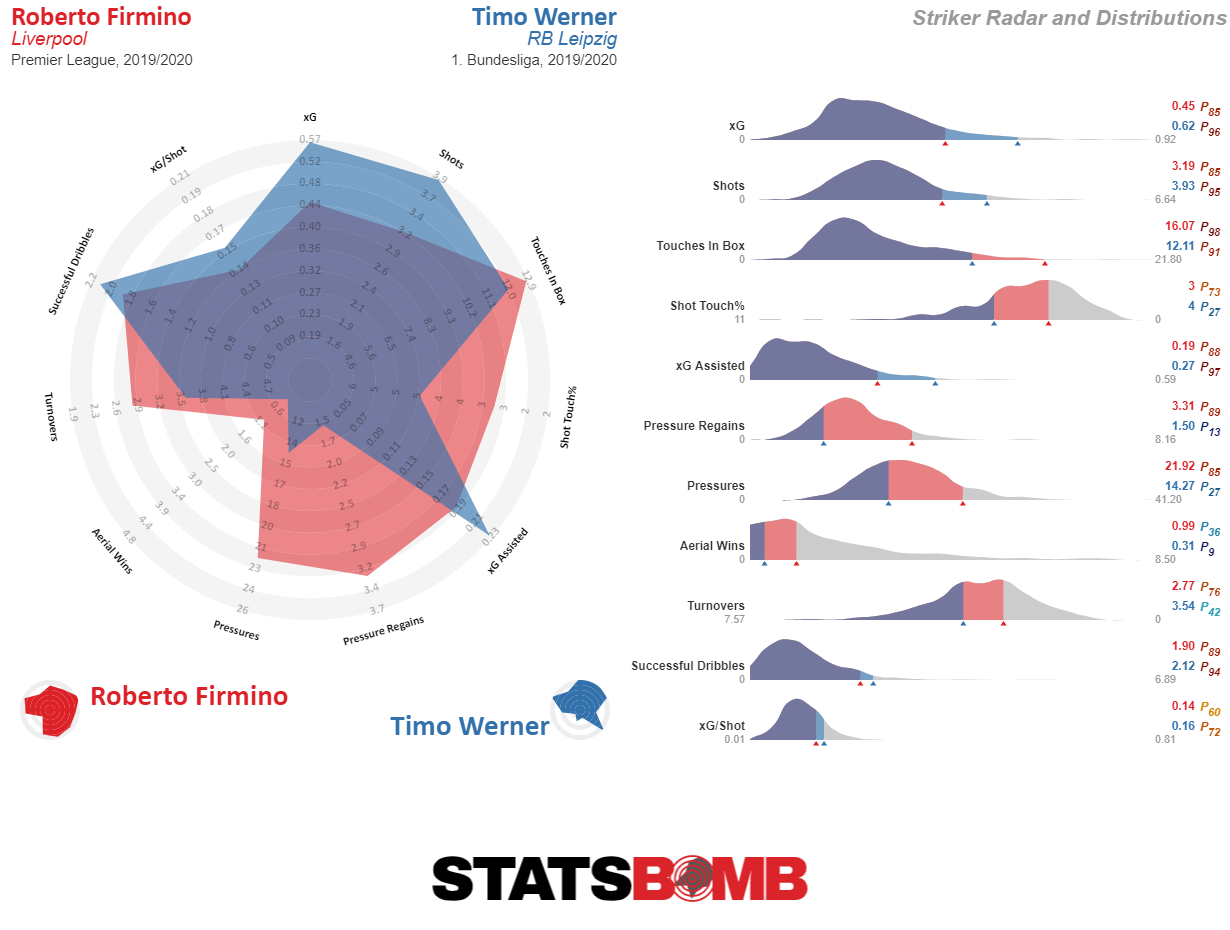 Werner’s xG output is greater than Firmino’s this season, as it was the season before. Werner’s xG numbers are consistently improving, with both his xG and xG assisted rising under Julian Nagelsmann. The forward has assisted 0.27 xG per 90 this season, while Firmino has around 0.20 per 90 for each of the last three seasons. Werner is more than just a goalscorer. The question lies in his defensive contribution. Playing under managers like Ralf Rangnick, Ralph Hasenhüttl and Julian Nagelsmann, Werner isn’t a stranger to working hard out of possession, but isn’t as active as Firmino. The diagrams show Leipzig's front-footed approach, as well as the difference in activity between the pair. Werner's defensive activity is mainly focused on the wing, where he is asked to contribute, and to his credit he delivers.
Werner’s xG output is greater than Firmino’s this season, as it was the season before. Werner’s xG numbers are consistently improving, with both his xG and xG assisted rising under Julian Nagelsmann. The forward has assisted 0.27 xG per 90 this season, while Firmino has around 0.20 per 90 for each of the last three seasons. Werner is more than just a goalscorer. The question lies in his defensive contribution. Playing under managers like Ralf Rangnick, Ralph Hasenhüttl and Julian Nagelsmann, Werner isn’t a stranger to working hard out of possession, but isn’t as active as Firmino. The diagrams show Leipzig's front-footed approach, as well as the difference in activity between the pair. Werner's defensive activity is mainly focused on the wing, where he is asked to contribute, and to his credit he delivers. 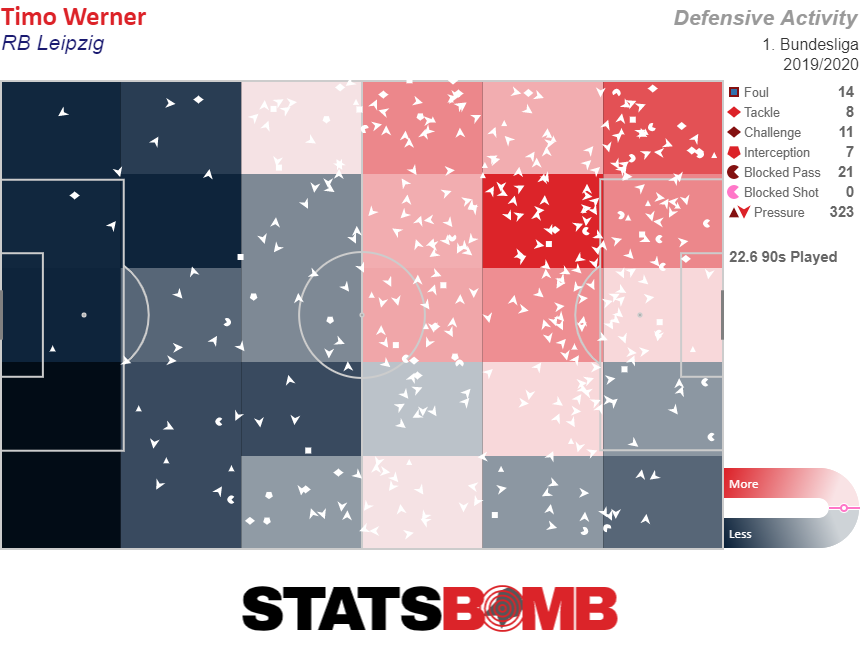 Firmino, on the other hand, is everywhere.
Firmino, on the other hand, is everywhere. 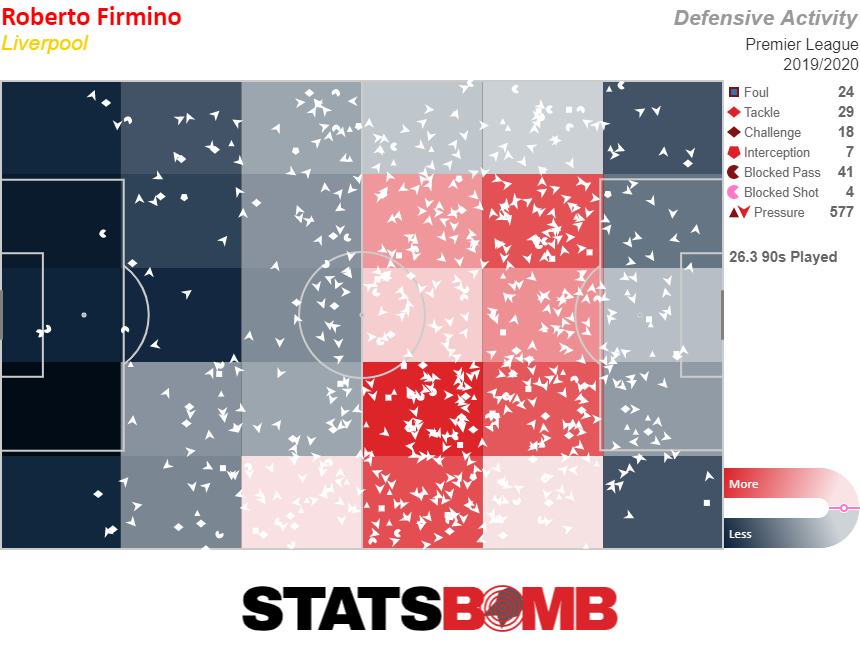 It’s not to say that Werner couldn’t adapt, but despite his qualities, replacing Firmino with Werner will likely not result in a seamless transition. Werner might be a player who would benefit more from playing alongside Firmino than replacing him. A front three of Werner, Mané and Salah would be strong, but it would also be different — though this wouldn't necessarily be a bad thing. Setting aside the Bundesliga rumours, Liverpool have to replace Firmino someday. Going out and signing one of the most talented young forwards in Europe for a decent fee certainly wouldn’t be bad, but maybe there’s a player flying under the radar. After all, Firmino rarely played the role he does now at Hoffenheim. Liverpool just need to find a player with the skillset to play Firmino’s role and provide good value for the price. Rather than go in-depth and look at different players, there's just one player I'd like to examine, and that's 23-year-old Emi Buendía from Norwich. No, he's not some obscure gem. He’s a player putting up strong numbers in the Premier League and attracting lots of attention. Given Liverpool’s well-documented success signing players from freshly relegated clubs, it’s quite easy to imagine Buendía at Liverpool. He’s played mostly from the right this season, but evaluating his past positions is necessary to determine if Buendía has the skillset to be a Firmino replacement.
It’s not to say that Werner couldn’t adapt, but despite his qualities, replacing Firmino with Werner will likely not result in a seamless transition. Werner might be a player who would benefit more from playing alongside Firmino than replacing him. A front three of Werner, Mané and Salah would be strong, but it would also be different — though this wouldn't necessarily be a bad thing. Setting aside the Bundesliga rumours, Liverpool have to replace Firmino someday. Going out and signing one of the most talented young forwards in Europe for a decent fee certainly wouldn’t be bad, but maybe there’s a player flying under the radar. After all, Firmino rarely played the role he does now at Hoffenheim. Liverpool just need to find a player with the skillset to play Firmino’s role and provide good value for the price. Rather than go in-depth and look at different players, there's just one player I'd like to examine, and that's 23-year-old Emi Buendía from Norwich. No, he's not some obscure gem. He’s a player putting up strong numbers in the Premier League and attracting lots of attention. Given Liverpool’s well-documented success signing players from freshly relegated clubs, it’s quite easy to imagine Buendía at Liverpool. He’s played mostly from the right this season, but evaluating his past positions is necessary to determine if Buendía has the skillset to be a Firmino replacement. 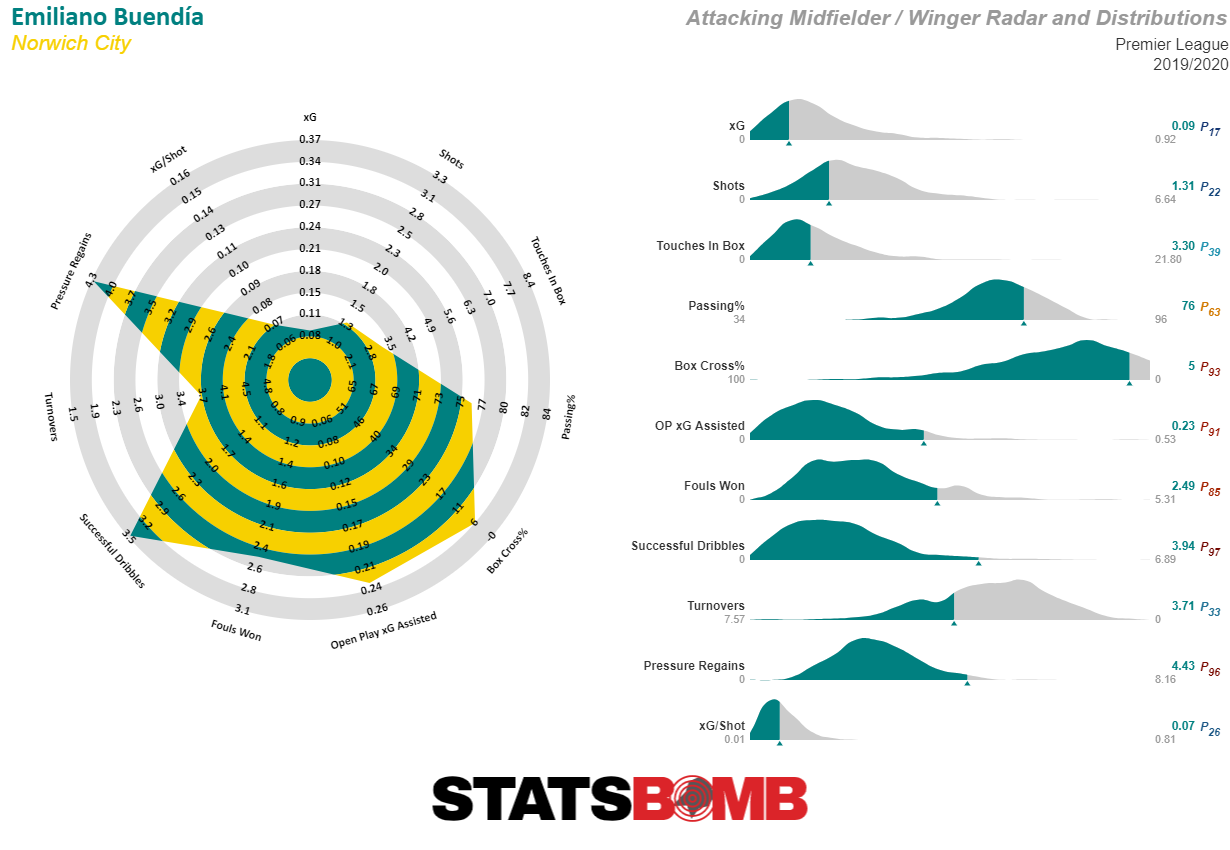 Creativity stats are where Buendía shines most. His xG assisted per 90 is the third-best in the Premier League this season and the best for those born in 1996 or later — which is no mean feat given he’s playing for the league's bottom side. Across Europe’s top five leagues, he’s 7th for those born in 1996 or later. The impressive xG assisted doesn’t come in isolation. In the same age group, Buendía is second in the Premier League for both passes into the penalty area per 90 and through balls per 90. These numbers seem perfect for a player who will drop deep when the likes of Salah and Mané are running ahead of him. The Norwich man is even a high volume dribbler. He completes 4.1 dribbles per 90 with a success rate of 73.9%. For reference, constant dribbling outlier Adama Traoré completes 5.2 per 90 with a 74.7% success rate. His off the ball numbers are encouraging but come with a few caveats. He's active, but mostly from a deeper right position. He makes more pressures and pressure regains than Firmino, but plays for a less dominant side and in a deeper role.
Creativity stats are where Buendía shines most. His xG assisted per 90 is the third-best in the Premier League this season and the best for those born in 1996 or later — which is no mean feat given he’s playing for the league's bottom side. Across Europe’s top five leagues, he’s 7th for those born in 1996 or later. The impressive xG assisted doesn’t come in isolation. In the same age group, Buendía is second in the Premier League for both passes into the penalty area per 90 and through balls per 90. These numbers seem perfect for a player who will drop deep when the likes of Salah and Mané are running ahead of him. The Norwich man is even a high volume dribbler. He completes 4.1 dribbles per 90 with a success rate of 73.9%. For reference, constant dribbling outlier Adama Traoré completes 5.2 per 90 with a 74.7% success rate. His off the ball numbers are encouraging but come with a few caveats. He's active, but mostly from a deeper right position. He makes more pressures and pressure regains than Firmino, but plays for a less dominant side and in a deeper role. 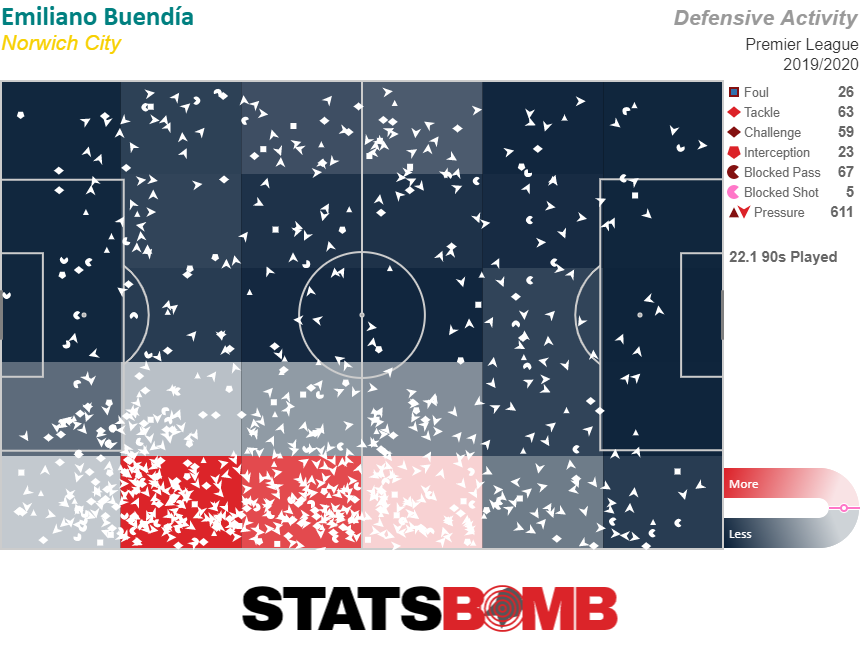 His defensive activity reveals several positives, however. He makes a similar number of counter pressures as Firmino, suggesting his pressures don’t just come from situations where Norwich have dropped back, and he makes more possession-adjusted tackles and interceptions than the Brazilian. His work ethic off the ball is there, it might just take some tweaking to utilise it in a different area of the pitch. Buendía definitely passes the eye test too. He’s not only aesthetically pleasing, but it’s easy to imagine sequences like this one if he steps into the Firmino role. He drops into a pocket of space, shows some nice footwork and plays someone in behind.
His defensive activity reveals several positives, however. He makes a similar number of counter pressures as Firmino, suggesting his pressures don’t just come from situations where Norwich have dropped back, and he makes more possession-adjusted tackles and interceptions than the Brazilian. His work ethic off the ball is there, it might just take some tweaking to utilise it in a different area of the pitch. Buendía definitely passes the eye test too. He’s not only aesthetically pleasing, but it’s easy to imagine sequences like this one if he steps into the Firmino role. He drops into a pocket of space, shows some nice footwork and plays someone in behind.  The same can be said about his pass against Aston Villa, where he plays Teemu Pukki in on goal rather than making the easy pass out wide.
The same can be said about his pass against Aston Villa, where he plays Teemu Pukki in on goal rather than making the easy pass out wide. 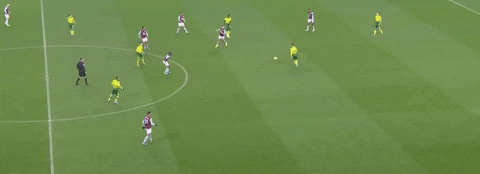 Then, while Nicolás Otamendi didn’t do much to help himself, what feels more Firmino than winning the ball back high up, going through on goal, only to be unselfish and find his teammate in a better position?
Then, while Nicolás Otamendi didn’t do much to help himself, what feels more Firmino than winning the ball back high up, going through on goal, only to be unselfish and find his teammate in a better position? 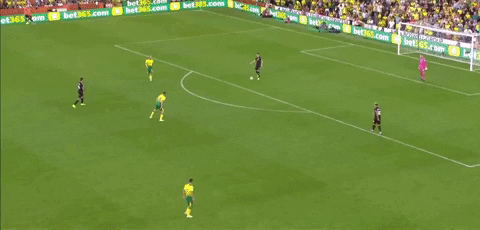 The biggest question mark over Buendía is his goalscoring — the area of Firmino’s game that's been criticized the most during his time at Liverpool. Firmino currently has a non-penalty xG of 0.45 per 90, his highest value across the last three seasons. Buendía’s 0.09 per 90 just doesn’t come close. There’s a possibility that getting into better goal scoring positions is something that could be coached into his game, while playing for a more dominant side may also see his numbers increase. Scoring is just not his job in this Norwich side; with Pukki ahead of him, his main priority is to supply his teammate rather than find goal-scoring positions himself. On the other hand, this could just be a weakness in his game.
The biggest question mark over Buendía is his goalscoring — the area of Firmino’s game that's been criticized the most during his time at Liverpool. Firmino currently has a non-penalty xG of 0.45 per 90, his highest value across the last three seasons. Buendía’s 0.09 per 90 just doesn’t come close. There’s a possibility that getting into better goal scoring positions is something that could be coached into his game, while playing for a more dominant side may also see his numbers increase. Scoring is just not his job in this Norwich side; with Pukki ahead of him, his main priority is to supply his teammate rather than find goal-scoring positions himself. On the other hand, this could just be a weakness in his game. 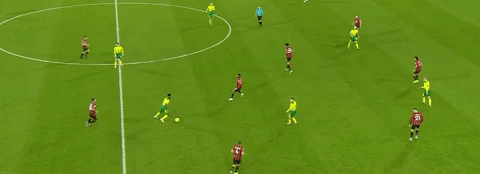 Buendía would likely make a good signing for Liverpool, though he’d probably be better received first as a rotation option for the front three than an outright replacement for Firmino. He looks to have the attributes to play the role, given his creativity, ability to find pockets of space and hard work when out of possession, but there are question marks over his goalscoring and whether he would adapt to the new role. If Liverpool opt for a more orthodox striker than Firmino for the future of their attack, it’s hard to look past Werner. His strong numbers seem to be only improving, his release clause makes him a good value and he will likely have over 15,000 minutes of Bundesliga football under his belt by the end of the season at just 24 years old. He may take a bit of time to adapt to Liverpool, but given how he’s improved over recent seasons, it should come rather quickly. Of course, Liverpool could just go get both. While Buendía doesn’t fit into the wide forward role, if Liverpool do have more of an orthodox forward, having a wide creator like Buendía may be a nice option to have. While considering any offers for the front three may seem crazy, it surely won’t be long until Liverpool break up the trio that’s brought them so much joy in recent years. However, they are no longer in a position where they need to sell to buy. Their small net spend combined with their success across recent seasons means they should have a lot of financial power, and they could raise this summer selling fringe players like Xherdan Shaqiri and Harry Wilson. It’s a tricky situation for Liverpool to navigate. On the one hand, they can afford to spend on players like Werner, Buendía or even Jadon Sancho, knowing they can recoup the outlay later. But it’s unlikely that these players (with the exception of Buendía) will accept a non-starting role. On the other hand, it’ll be difficult for Liverpool to break up such a dominant side. They’re in the middle of an absolutely historic season. No one wants to conclude a Premier League title-winning, record-points-haul, possibly invincible season by saying, “So long and thanks for all the memories,” even if it’s the right thing to do. But after the past three seasons, it’s hard to imagine the club getting more out of the front three than they currently have. If Liverpool can sign an elite younger player to replace one of their attacking trio, they likely won't see a significant drop off. It seems more beneficial in the long-term to be proactive and begin to shore up the future of the attack than to sit back and think "one more’"— particularly when reinforcements will likely be needed to replace aging players in midfield as well. It’s a devilishly difficult problem to solve. Of course, “How do we best kick on from one of the best seasons in history” is exactly the kind of problem everyone in the footballing world is desperate for.
Buendía would likely make a good signing for Liverpool, though he’d probably be better received first as a rotation option for the front three than an outright replacement for Firmino. He looks to have the attributes to play the role, given his creativity, ability to find pockets of space and hard work when out of possession, but there are question marks over his goalscoring and whether he would adapt to the new role. If Liverpool opt for a more orthodox striker than Firmino for the future of their attack, it’s hard to look past Werner. His strong numbers seem to be only improving, his release clause makes him a good value and he will likely have over 15,000 minutes of Bundesliga football under his belt by the end of the season at just 24 years old. He may take a bit of time to adapt to Liverpool, but given how he’s improved over recent seasons, it should come rather quickly. Of course, Liverpool could just go get both. While Buendía doesn’t fit into the wide forward role, if Liverpool do have more of an orthodox forward, having a wide creator like Buendía may be a nice option to have. While considering any offers for the front three may seem crazy, it surely won’t be long until Liverpool break up the trio that’s brought them so much joy in recent years. However, they are no longer in a position where they need to sell to buy. Their small net spend combined with their success across recent seasons means they should have a lot of financial power, and they could raise this summer selling fringe players like Xherdan Shaqiri and Harry Wilson. It’s a tricky situation for Liverpool to navigate. On the one hand, they can afford to spend on players like Werner, Buendía or even Jadon Sancho, knowing they can recoup the outlay later. But it’s unlikely that these players (with the exception of Buendía) will accept a non-starting role. On the other hand, it’ll be difficult for Liverpool to break up such a dominant side. They’re in the middle of an absolutely historic season. No one wants to conclude a Premier League title-winning, record-points-haul, possibly invincible season by saying, “So long and thanks for all the memories,” even if it’s the right thing to do. But after the past three seasons, it’s hard to imagine the club getting more out of the front three than they currently have. If Liverpool can sign an elite younger player to replace one of their attacking trio, they likely won't see a significant drop off. It seems more beneficial in the long-term to be proactive and begin to shore up the future of the attack than to sit back and think "one more’"— particularly when reinforcements will likely be needed to replace aging players in midfield as well. It’s a devilishly difficult problem to solve. Of course, “How do we best kick on from one of the best seasons in history” is exactly the kind of problem everyone in the footballing world is desperate for.
StatsBomb Champions League Primer: Lyon vs Juventus and Real Madrid vs Manchester City
Why yes, you can have a little more Champions League as a treat.
Lyon vs Juventus
There are questions about exactly how good Juventus are this season, but they won’t get answered in their Round of 16 match against Lyon. The French side are comfortably the worst team remaining in the tournament and sit in seventh place in Ligue 1. It’s true that their position slightly underrates their underlying numbers, which are the fourth-best in France, but only slightly. There’s nothing wrong with being a pretty good team in Ligue 1 having a slightly down season, but it’s not going to do much for you in the Champions League knockout stages. And it’s not only that they’re not all that good, it’s also that they aren’t all that interesting. For a team that until this year had been tremendous fun, the outgoing transfers are taking their toll. Tanguy Ndombele is no longer running the midfield. Ferland Mendy has been replaced at left back, and Nabil Fekir is gone in attack. There’s only so much attacking talent a team can lose before they start to look like, well, like this. 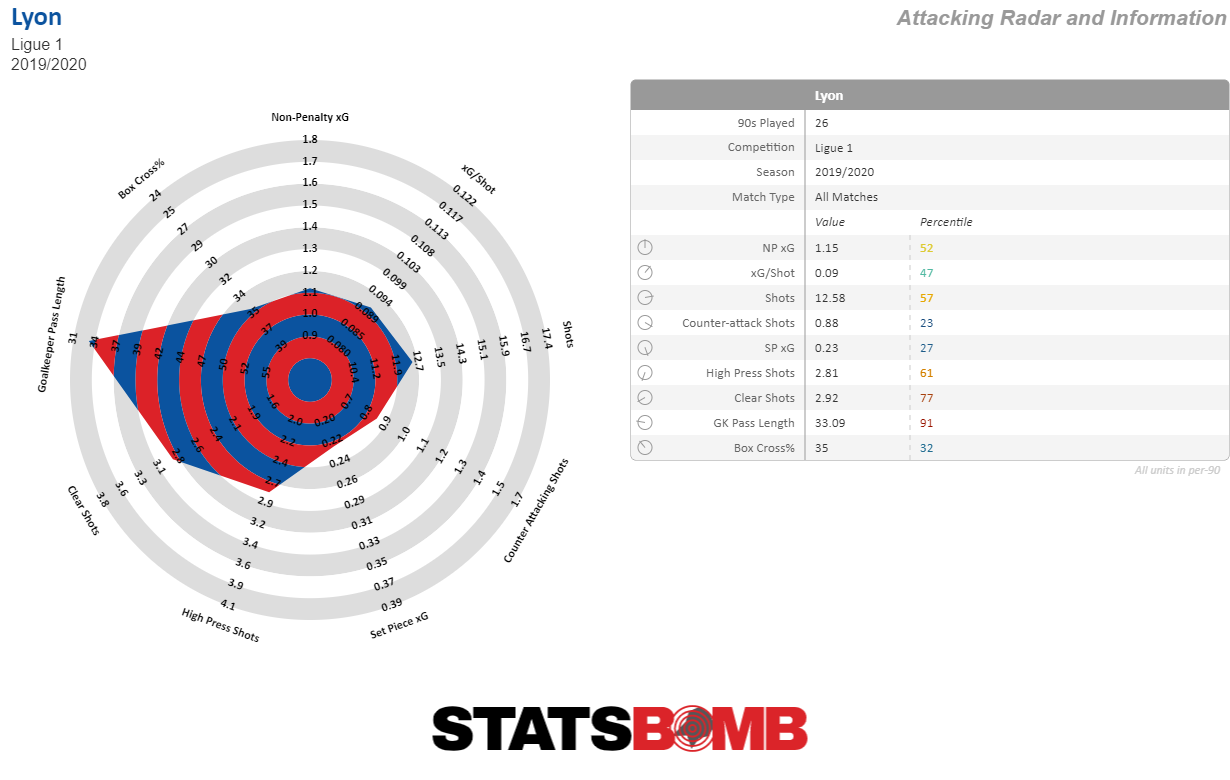 Defensively the side is stable and dependable. They concede only 0.88 expected goals per match, the third-best in the league. They’re admittedly very tough to break down, and they remain steady in a fairly unique way. They counterpress high when they lose the ball deep in enemy territory, and otherwise defend very deep, leaving the entire middle of the field to their opponent's control.
Defensively the side is stable and dependable. They concede only 0.88 expected goals per match, the third-best in the league. They’re admittedly very tough to break down, and they remain steady in a fairly unique way. They counterpress high when they lose the ball deep in enemy territory, and otherwise defend very deep, leaving the entire middle of the field to their opponent's control. 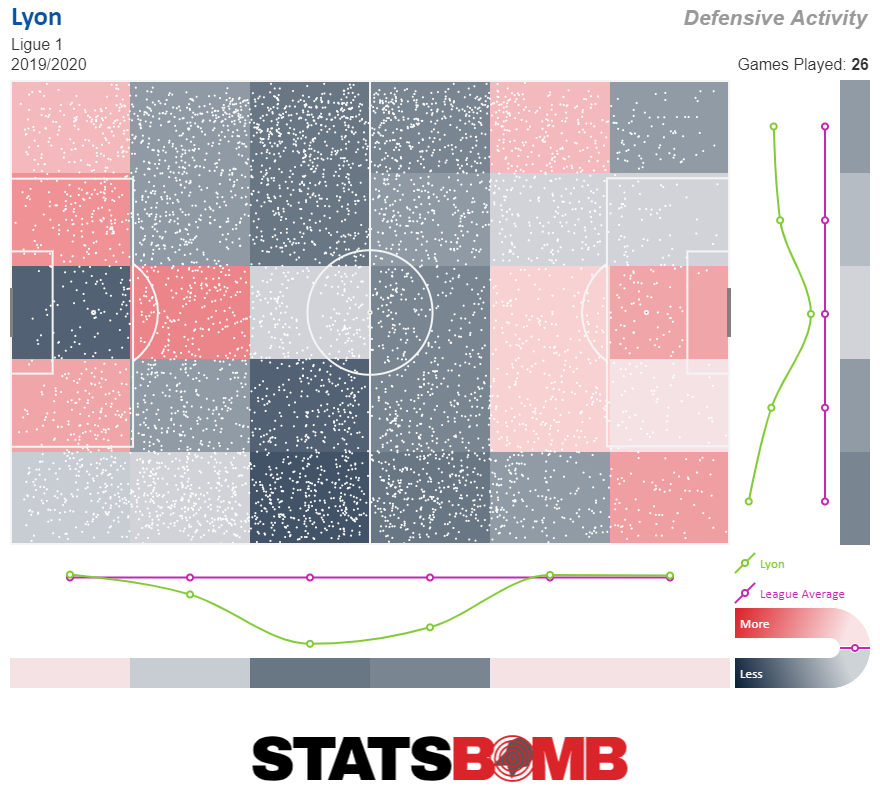 Overall there’s nothing precisely wrong with this team, it’s just that there’s nothing about them that suggests they’re going to be difficult for a team like Juventus to handle. Specifically, a team that cedes the midfield is going to be music to Maurizio Sarri’s very Italian ears. Juventus is perfectly happy to simply keep the ball. They have the highest pass percentage in Serie A at 87% and they virtually never play long; only Napoli play the ball shorter on average than Juventus’s average keeper pass length of 30.28. But, despite the fact that they're comfortable keeping the ball, they aren’t particularly aggressive at moving it into the penalty area. Six teams in Serie A play more passes into the box per match than Juventus, and Atalanta, Roma and Lazio all complete more passes per match within 20 yards of their opponent’s goal as well.
Overall there’s nothing precisely wrong with this team, it’s just that there’s nothing about them that suggests they’re going to be difficult for a team like Juventus to handle. Specifically, a team that cedes the midfield is going to be music to Maurizio Sarri’s very Italian ears. Juventus is perfectly happy to simply keep the ball. They have the highest pass percentage in Serie A at 87% and they virtually never play long; only Napoli play the ball shorter on average than Juventus’s average keeper pass length of 30.28. But, despite the fact that they're comfortable keeping the ball, they aren’t particularly aggressive at moving it into the penalty area. Six teams in Serie A play more passes into the box per match than Juventus, and Atalanta, Roma and Lazio all complete more passes per match within 20 yards of their opponent’s goal as well. 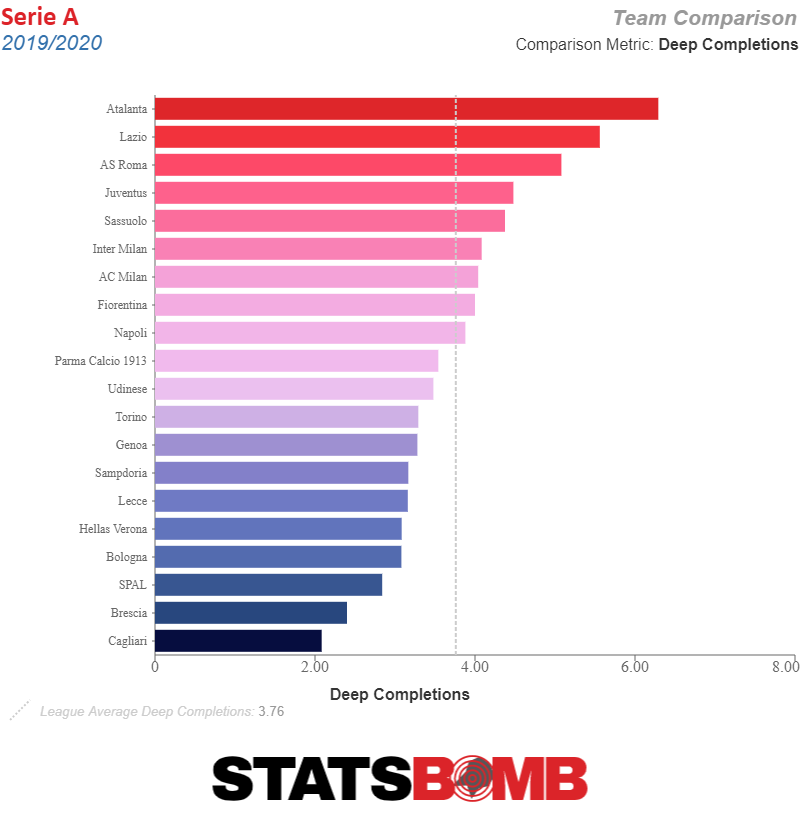 There are reasons to question whether Juventus’s approach of keeping the ball forever, taking lots of shots (their 17.36 per match is third in the league) but being relatively conservative when it comes to moving the ball into the penalty area is a solid approach against better teams. It leaves them somewhat prone to bombing away from distance with mediocre shots, and their 0.09 xG per shot in Serie A is a decidedly average eighth. But, against Lyon, who won’t bother to contest midfield or try to keep the ball, or do much of anything besides kick it long and drop back and defend, it shouldn’t be a problem.
There are reasons to question whether Juventus’s approach of keeping the ball forever, taking lots of shots (their 17.36 per match is third in the league) but being relatively conservative when it comes to moving the ball into the penalty area is a solid approach against better teams. It leaves them somewhat prone to bombing away from distance with mediocre shots, and their 0.09 xG per shot in Serie A is a decidedly average eighth. But, against Lyon, who won’t bother to contest midfield or try to keep the ball, or do much of anything besides kick it long and drop back and defend, it shouldn’t be a problem.
Real Madrid vs Manchester City
Real Madrid are good. It’s a testament to the turmoil of the last year that this is surprising. Following last season when they sold Cristiano Ronaldo and didn’t replace him, and also tried to replace Zinedine Zidane as manager and failed at that, it seemed like Madrid were going firmly in the wrong direction. But two managers and two-thirds of a season later, Zidane returned and lifted the team back to the top tier of European football. Interestingly, however, that’s not because they’ve replaced Ronaldo’s attacking production. High priced acquisitions Eden Hazard and Luka Jović have failed to make much of an impact this season. Rather Zidane has artfully mixed and matched from a deep pool of attacking wingers while featuring Karim Benzema at striker. 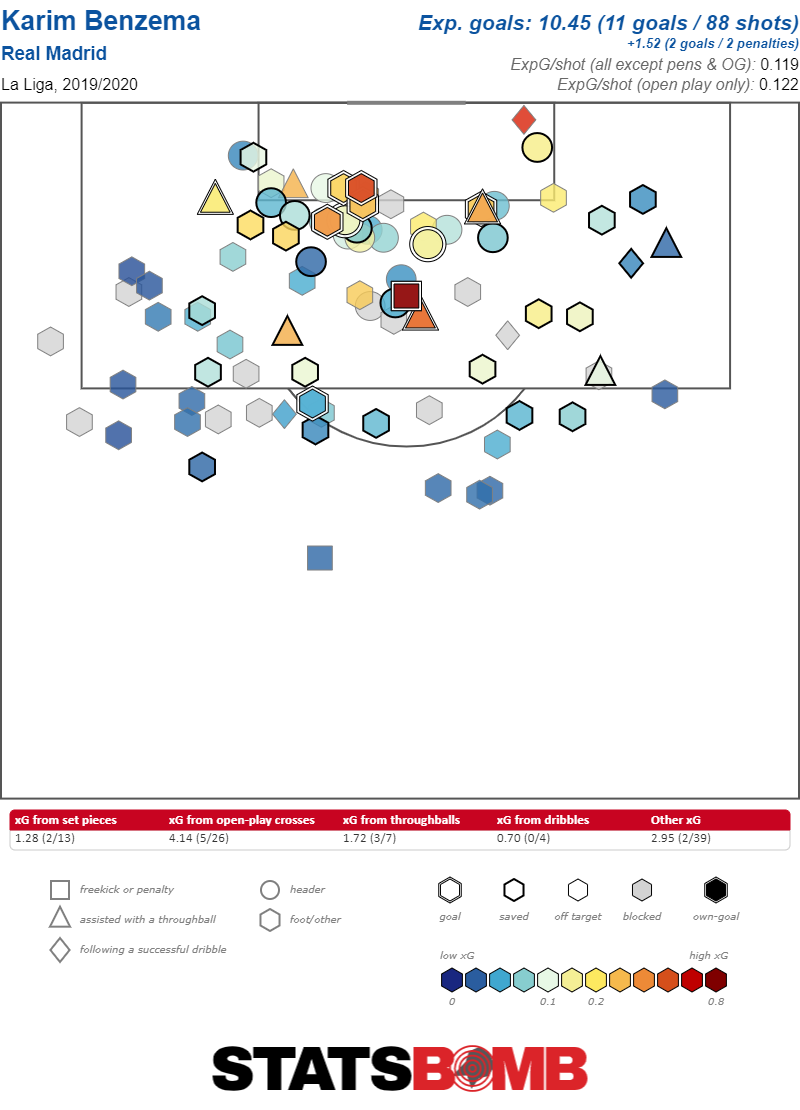 But the real master strike from Zidane was compensating for the ageing duo of Toni Kroos and Luka Modrić by easing the latter into a more limited role and featuring the younger and much more active Fede Valverde instead. Valverde’s inclusion in the squad means that, alongside Casemiro, there are now two more rugged midfielders in the side at any given time. This has turned Madrid into the best defensive team in La Liga with only 0.70 xG conceded per match. The question, however, is whether that defense can hold against a Manchester City side that is legitimately one of the best in the world. Lost in the historic nature of Liverpool’s season is the fact that City’s underlying numbers are actually better than the runaway presumed champions. They are an absurd attacking team. The side’s non-penalty xG of 2.21 is testing the outer limits of the possible and is almost an entire half goal better than their closes attacking competitor, Liverpool.
But the real master strike from Zidane was compensating for the ageing duo of Toni Kroos and Luka Modrić by easing the latter into a more limited role and featuring the younger and much more active Fede Valverde instead. Valverde’s inclusion in the squad means that, alongside Casemiro, there are now two more rugged midfielders in the side at any given time. This has turned Madrid into the best defensive team in La Liga with only 0.70 xG conceded per match. The question, however, is whether that defense can hold against a Manchester City side that is legitimately one of the best in the world. Lost in the historic nature of Liverpool’s season is the fact that City’s underlying numbers are actually better than the runaway presumed champions. They are an absurd attacking team. The side’s non-penalty xG of 2.21 is testing the outer limits of the possible and is almost an entire half goal better than their closes attacking competitor, Liverpool. 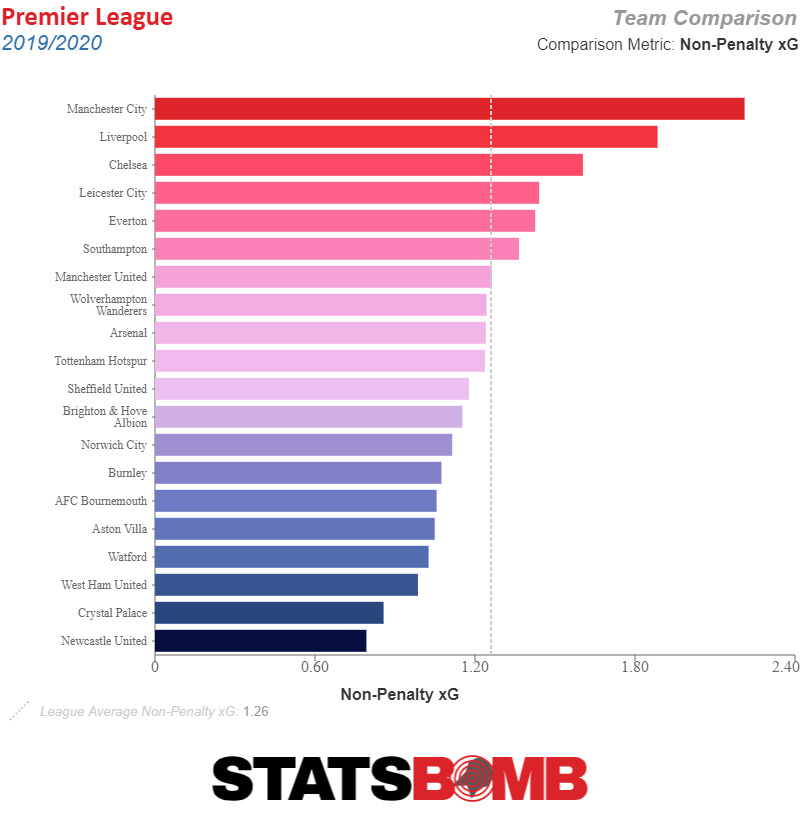 This isn’t to say City are perfect. They aren’t quite a vintage Guardiola team, and are vulnerable to the counterattack in a way that the best sides Guardiola has coached over the years have not been. Their defense is still very good; they simply have the ball so much, and are so aggressive at winning it back when they lose it that they concede very few shots. But when counterattacks do happen, they can be exposed.
This isn’t to say City are perfect. They aren’t quite a vintage Guardiola team, and are vulnerable to the counterattack in a way that the best sides Guardiola has coached over the years have not been. Their defense is still very good; they simply have the ball so much, and are so aggressive at winning it back when they lose it that they concede very few shots. But when counterattacks do happen, they can be exposed. 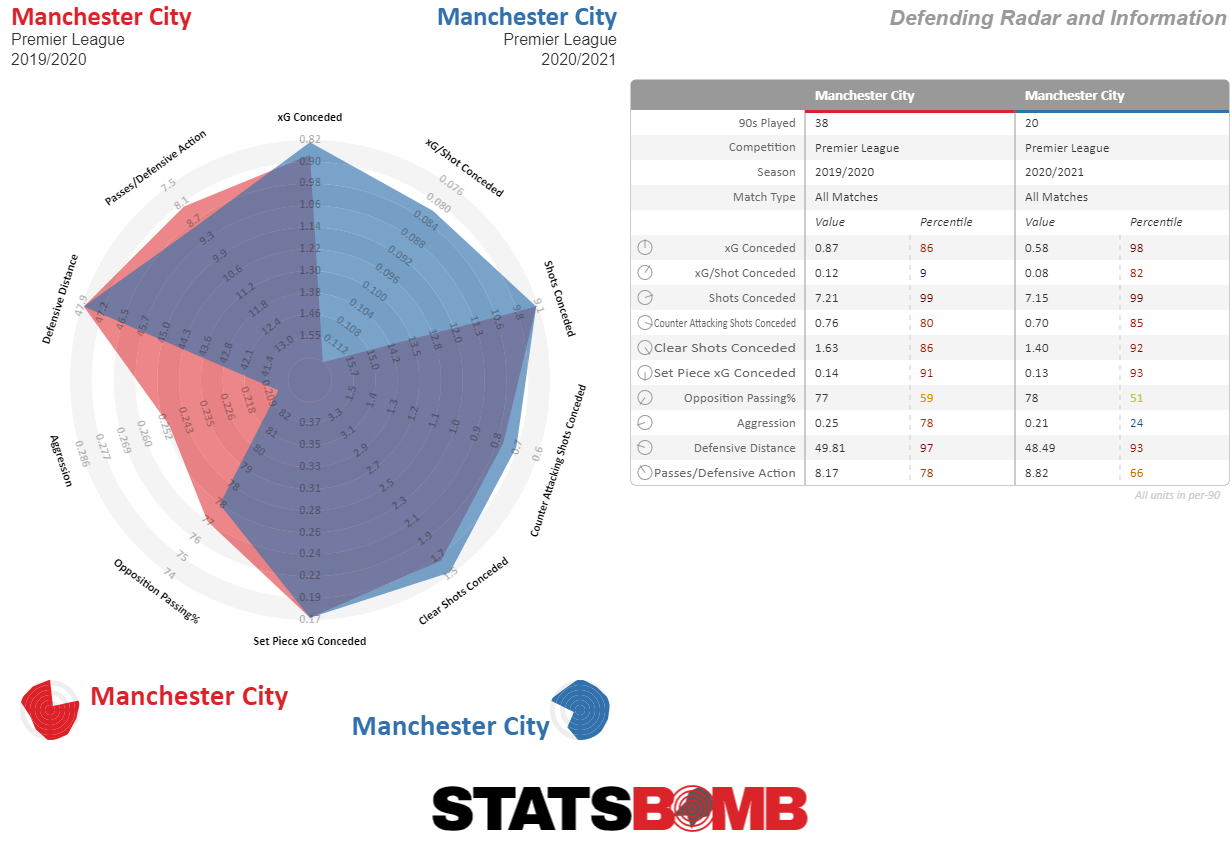 The main question of this match then is how much will Madrid cede possession. City are so high powered that going toe to toe with them is probably a losing proposition, even for a team like Madrid. But, a cagier approach, one which relies on withstanding some degree of pressure before punching back hard, well, that could conceivably work.
The main question of this match then is how much will Madrid cede possession. City are so high powered that going toe to toe with them is probably a losing proposition, even for a team like Madrid. But, a cagier approach, one which relies on withstanding some degree of pressure before punching back hard, well, that could conceivably work.
Who in the Premier League Deserves to win Player of the Year?
Let’s take a look at the numbers.
Dear Premier League footballer,
It’s the time of year when you need to select your choice for PFA Player of the Year. But you’re stuck. You know who the frontrunners are (according to SkyBet), but you just can’t differentiate between their skillsets. You probably don’t usually rely on analytics too much in your decision-making process, instead preferring the eye test and gut instinct. But maybe you’re just not sure this year, and you’re willing to try something new. Allow us to give you a stats overview of the cases for and against the current frontrunners.
Sadio Mané
The bookmakers’ favourite for the award clearly has some things going for him.
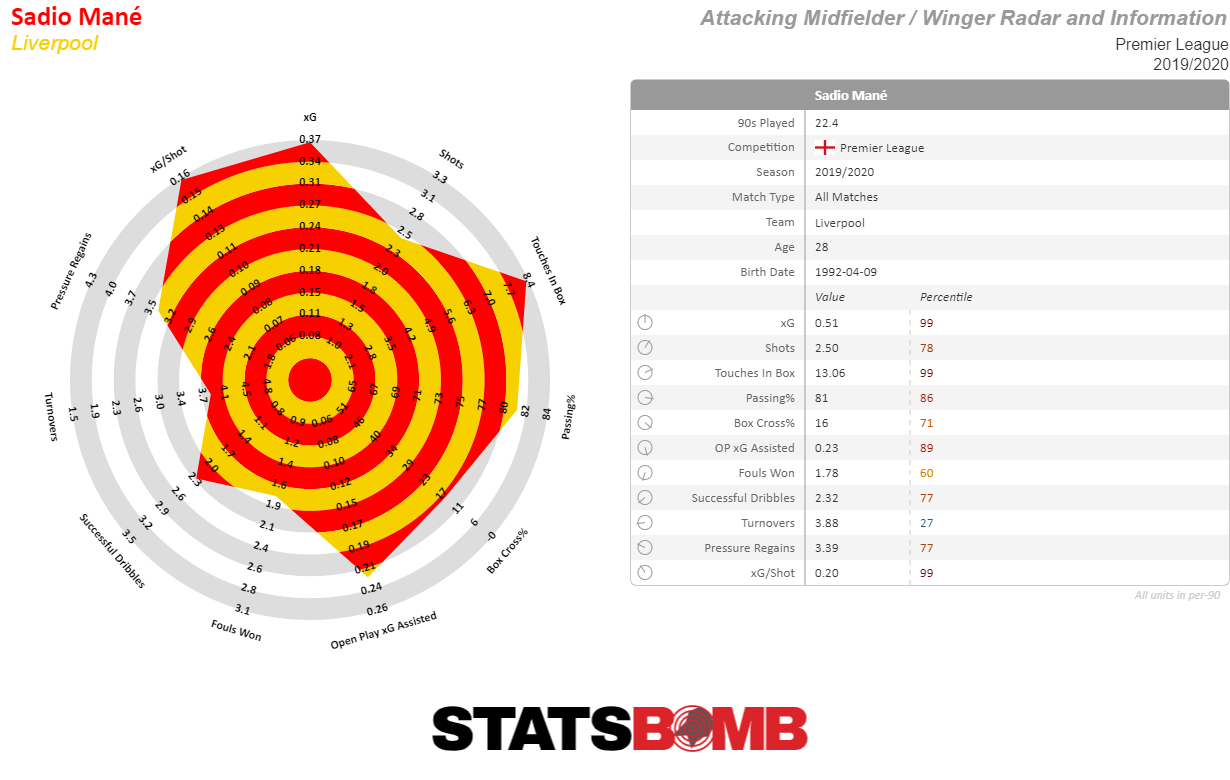
He leads Liverpool in non-penalty goals and assists this season. Player of the year awards aren’t doled out on the basis of average performance, but he leads Liverpool per 90 minutes as well. And he’s doing this without a huge overperformance of expected goals. Here at StatsBomb, we often make fun of players who've sent in too many punts from long range, so let’s be clear that this is what very good shot selection looks like for a wide forward. There’s almost no fat.

The case for Mané is pretty straightforward. Liverpool are almost certainly the title winners, and Mané is their best attacker in goals and assists. But surely there are arguments to be made; for example, while he might be top at Liverpool, he is not the most explosive scorer in the league (we’ll get to him). And the argument that you, Premier League footballer, might make is that Liverpool are not about individuals, but the collective. In which case, many are arguing for…
Jordan Henderson
The player that embodies Liverpool's team spirit. And my, what a difference a few months can make in the numbers. Jordan Henderson started the season on the right side of Liverpool’s midfield three, with Fabinho in the deeper role. His performances were well short of his best. Henderson interpreted the number eight role as one in which he would get high up the pitch, but then lacked the athleticism to recover from those positions. The numbers speak for themselves.
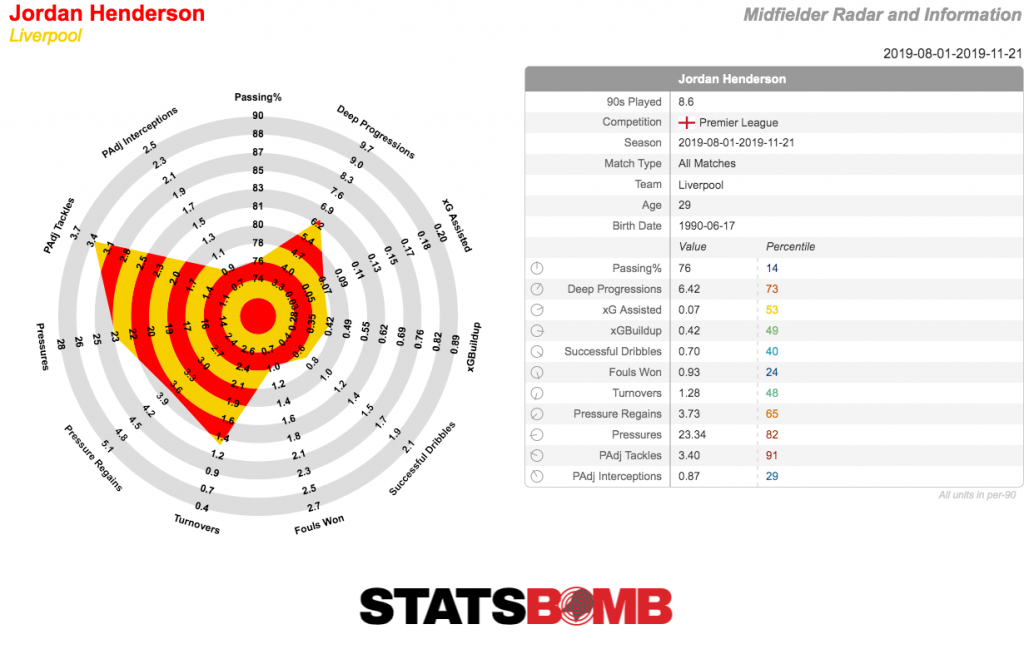
Then injury struck. Fabinho picked up a knock near the end of November that saw Henderson return to the deeper role. He’s looked better than ever since, growing into more and more of an orchestrator for the side. Liverpool’s deepest midfielder is, strangely, the one given the greatest licence for expansive passing, and Henderson has utilised that well.
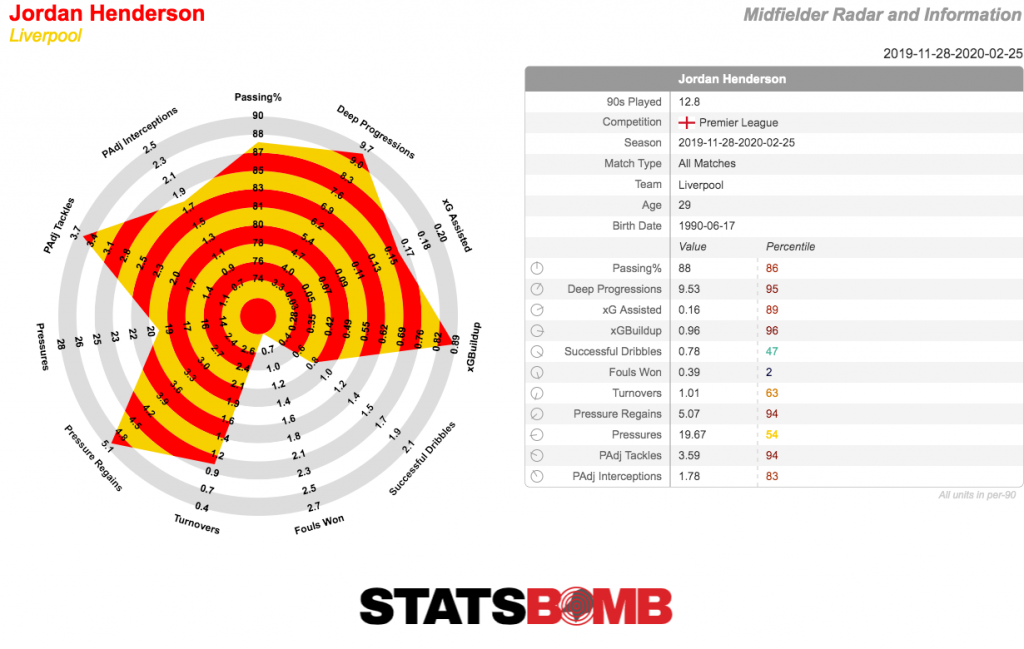
But the case people are making for Henderson isn’t really about this so much as soft factors, particularly leadership qualities. And you, Premier League footballer, probably have a sense of this that can't be shown through sats. Really, the only thing that could seriously dent Henderson’s credentials is if his injury lasts longer than the reported three weeks.
Kevin De Bruyne
If he doesn’t win it this year, you can sense it becoming one of those obscure bits of trivia everyone’s surprised by. “Wait, Kevin De Bruyne NEVER won Player of the Year!?”
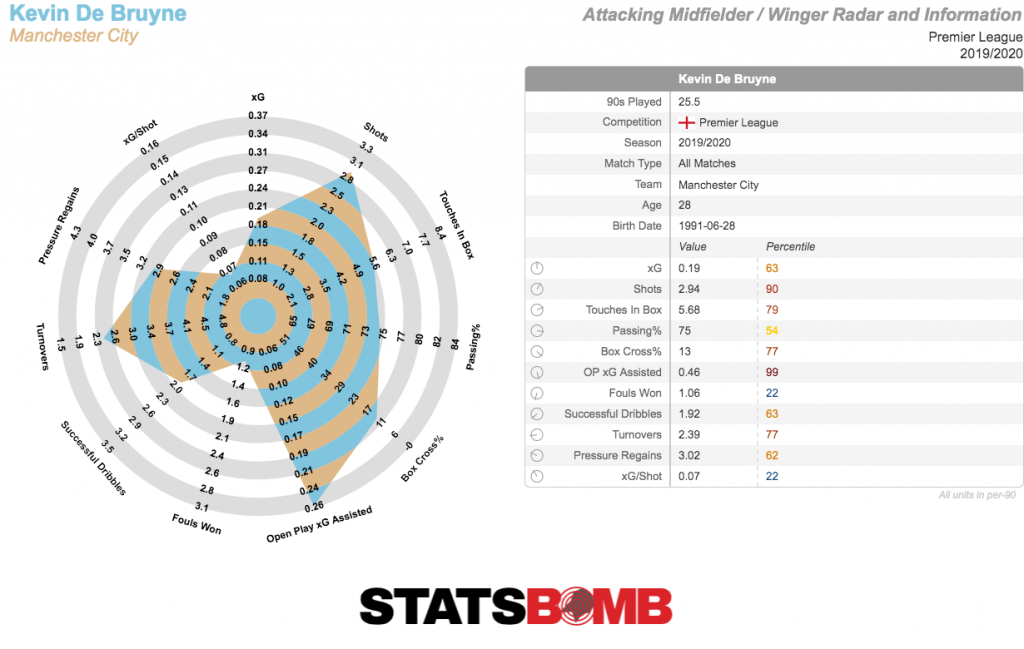
De Bruyne leads the Premier League in non-penalty goals and assists with 23. Fifteen of those have been assists, meaning he needs five more to equal Thierry Henry’s record in that department. But even if he doesn’t, we’re talking about some playmaker. Best in the league in total xG assisted (nearly double that of second-placed Riyad Mahrez). Best in the league in total open play passes into the box. Best in the league in total deep progressions. If a player dominates the scoring metrics like this, there should be little doubt to his being the frontrunner. The main case for De Bruyne is that if you think creating is as important as scoring, he should be your man.
Virgil van Dijk
Well, he won it last year when Liverpool didn’t win the league, and with the Reds actually about to get over the line this time, why not again?
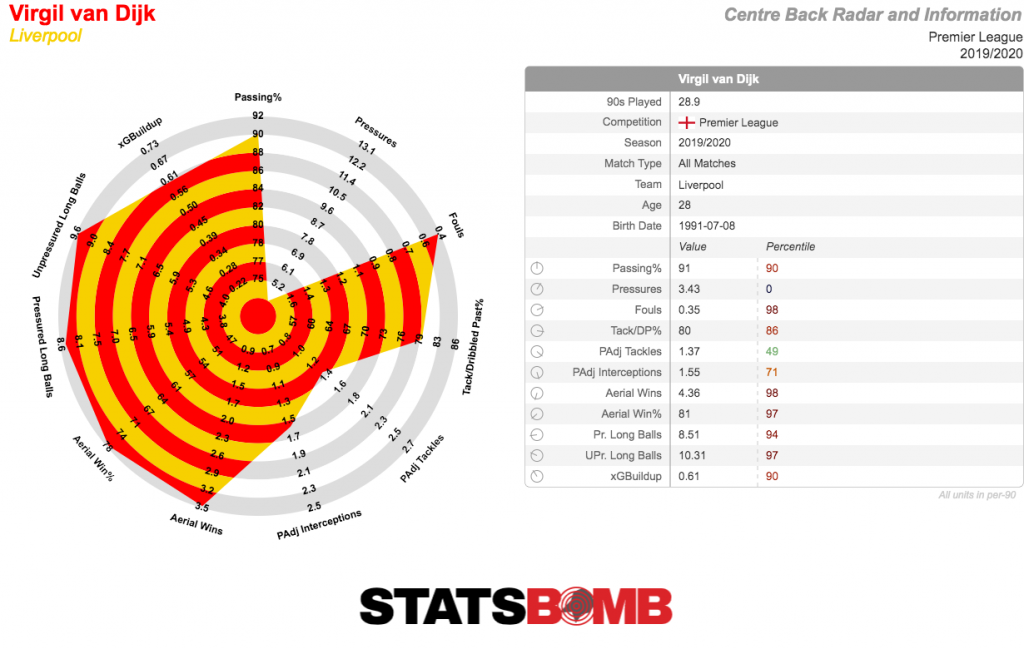
In truth there isn’t a great statistical case for the Netherlands captain. Liverpool look a worse side defensively than their numbers showed last year. Their xG conceded per game has risen (0.95, up from 0.77). Liverpool have relied on Alisson more than ever this year. Statistically, analysing centre backs is an infamous minefield, so it’s hard to point to a number and say “This is why Van Dijk is good”. Defending is a collective art, and individuals often have such different responsibilities that it’s hard to assign individual credit or blame. Purely to the eye, it looks like Van Dijk was a little better last year, when Liverpool sat ever so slightly deeper and he could afford to be a little less aggressive. In the understandable desire to praise Liverpool, it feels like Van Dijk would be more a pick by default than on merit.
Trent Alexander-Arnold
He’s a shoo-in for the Young Player of the Year award, but can he take both?
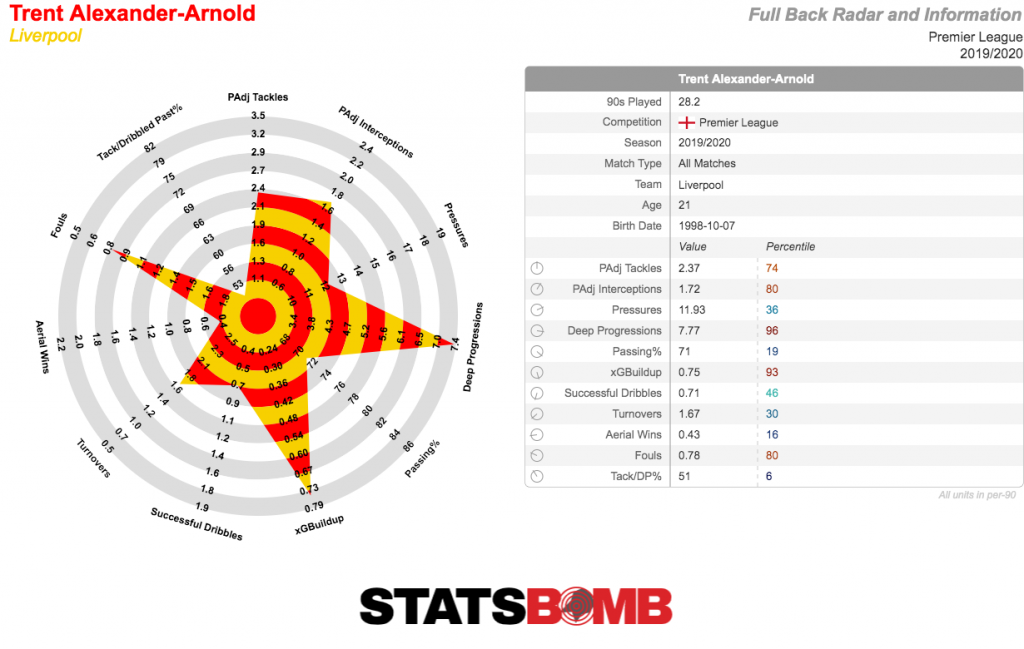
Alexander-Arnold plays such an unusual role that the radar doesn’t really do him justice. Last season, he set the record for Premier League assists from a “defender” with 12, and this year he’s already equalled that number. His underlying performance is better, too, with 0.30 xG assisted per 90, building on last campaign’s 0.22. If you want to see how much he’s doing things beyond expected from a normal full back, here are all his crossfield passes.
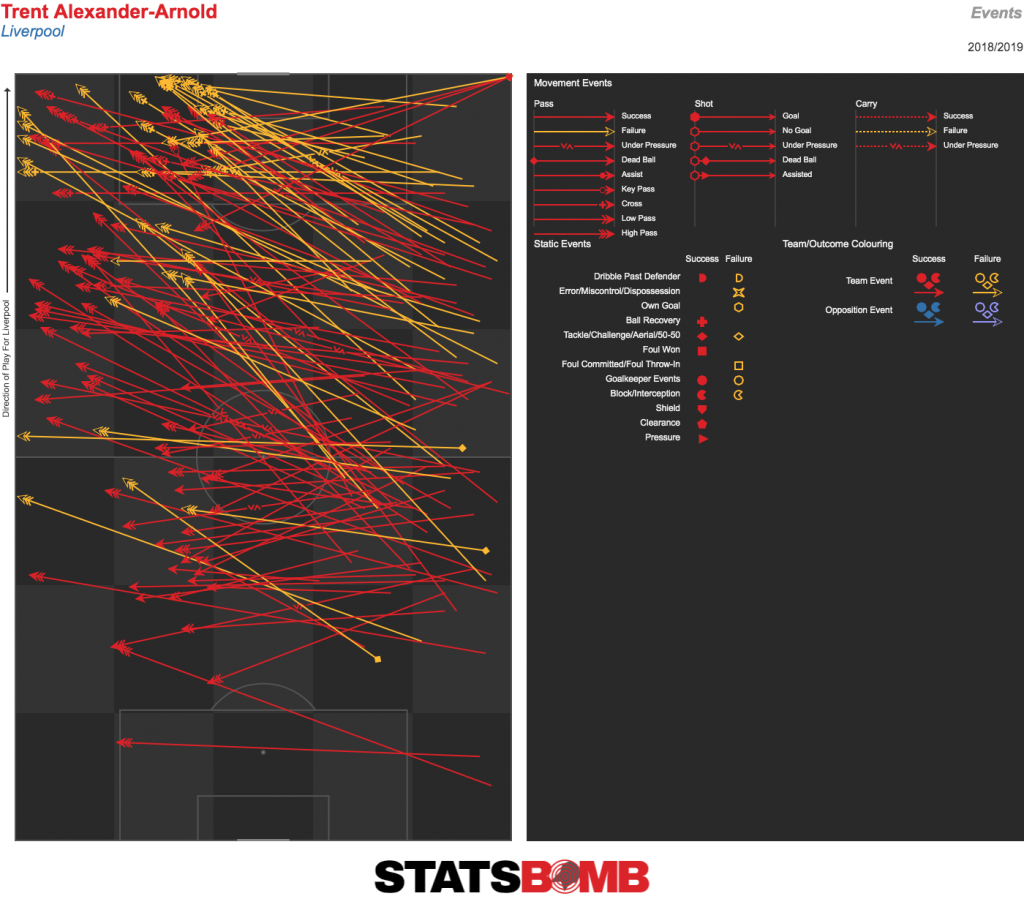
The case for Alexander-Arnold is that he’s redefining his position in a way no other Premier League player is. Of course, you can take the view that positions are social constructs and this is irrelevant to judging his abilities as a footballer, but he’s certainly in contention.
Mohamed Salah
Another one whose season can be broken into two parts. Salah legitimately looked to be in a slump at the start of this season. As Joel Wertheimer wrote for StatsBomb back in October, “He does look somewhat less explosive than he did the last couple years, not turning the corner in the box with the same gusto”.
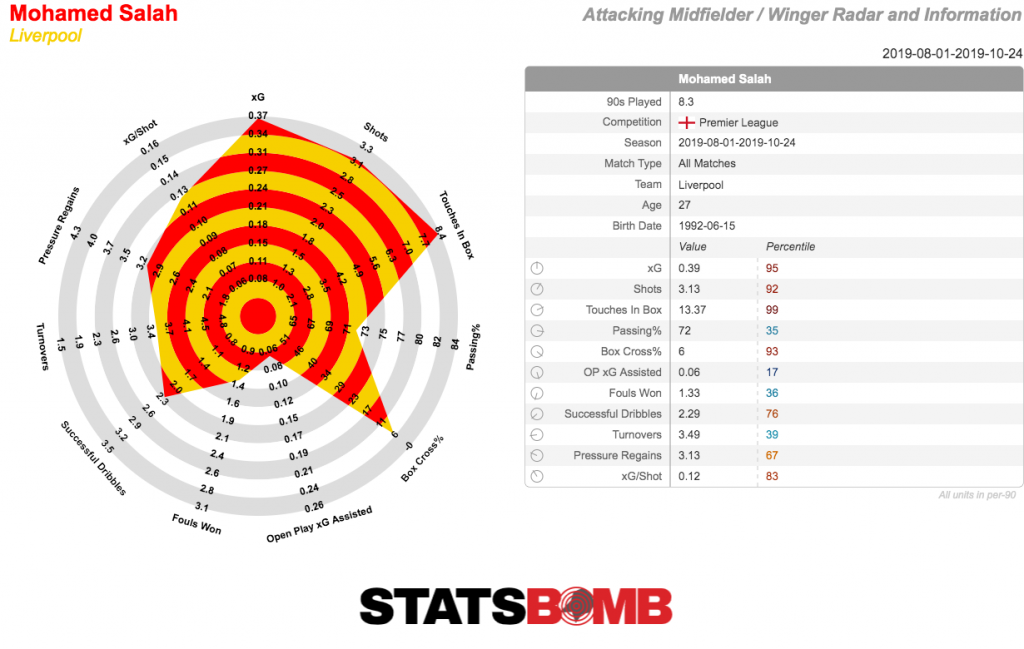
But after that? He caught fire. Since late October, he leads the Premier League in xG plus xG assisted.
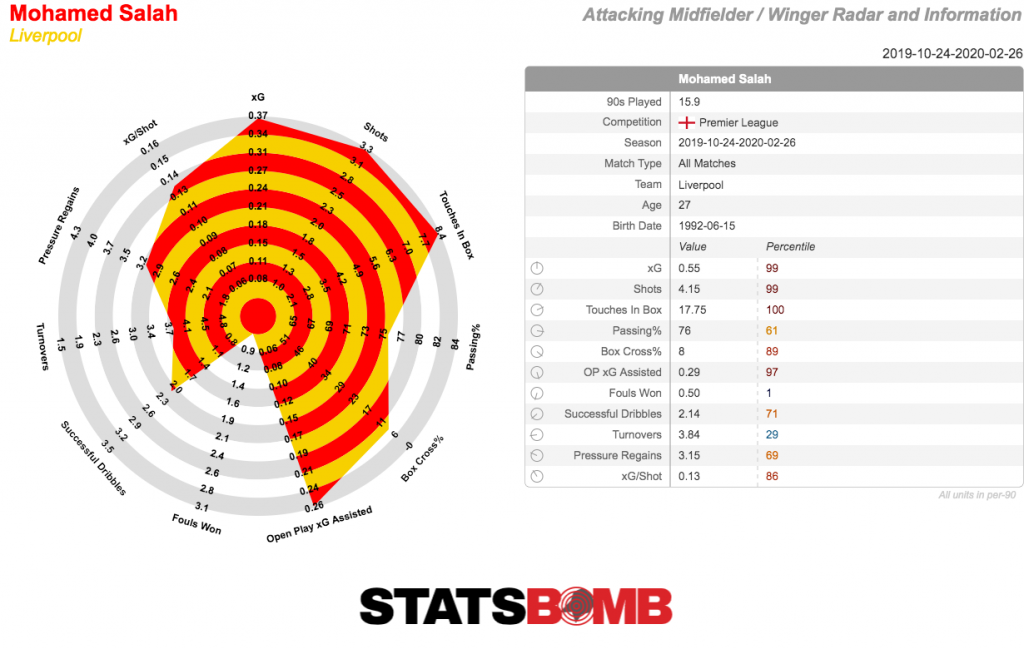
Salah likely suffers in the standings due to his 2017–18 breakout season. He holds practically every individual award for a season he’s unlikely to ever outdo. But he really is playing very well at the moment. Mané’s improvement has seen the side become a little more balanced between both flanks than in past years, when the side was overwhelmingly tilted towards the former Roma player, but that’s not a reflection on his performance.
A Proposed StatsBomb Wildcard: Sergio Agüero
Surely the best player ever to play in the Premier League and not win the individual award. Sergio Agüero has missed long stretches of this season and still sits only one goal behind Jamie Vardy and Pierre-Emerick Aubameyang in the Golden Boot race. He has more non-penalty goals and assists per 90 than anyone in the league.

If Agüero is able to stay fit between now and the end of the season, there will be a real case to be made to crown him the year’s outstanding performer. Of course, you, Premier League footballer, have to decide before then. But with Agüero expected to leave Manchester City in 2021, time is running out for him to win the award.
Stats of Interest
You know who’s been really good since the start of 2020? Like, one of the best players in the league good? Dominic Calvert Lewin.
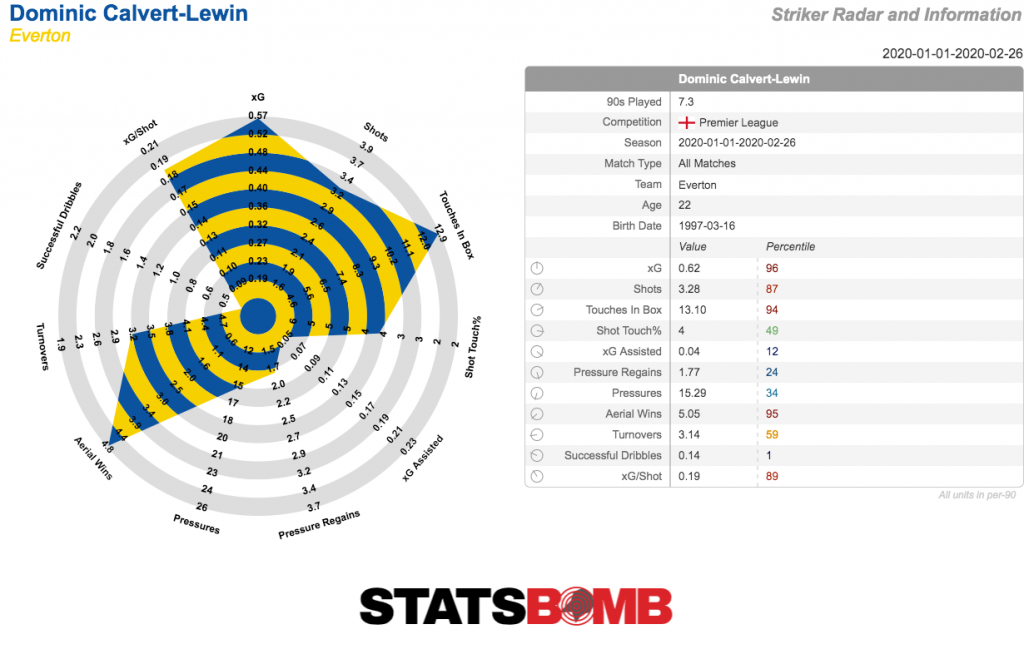
Back in November, I mentioned here that Jamie Vardy’s finishing seemed out of this world good and almost certain not to continue. And not to brag, but since then, well…
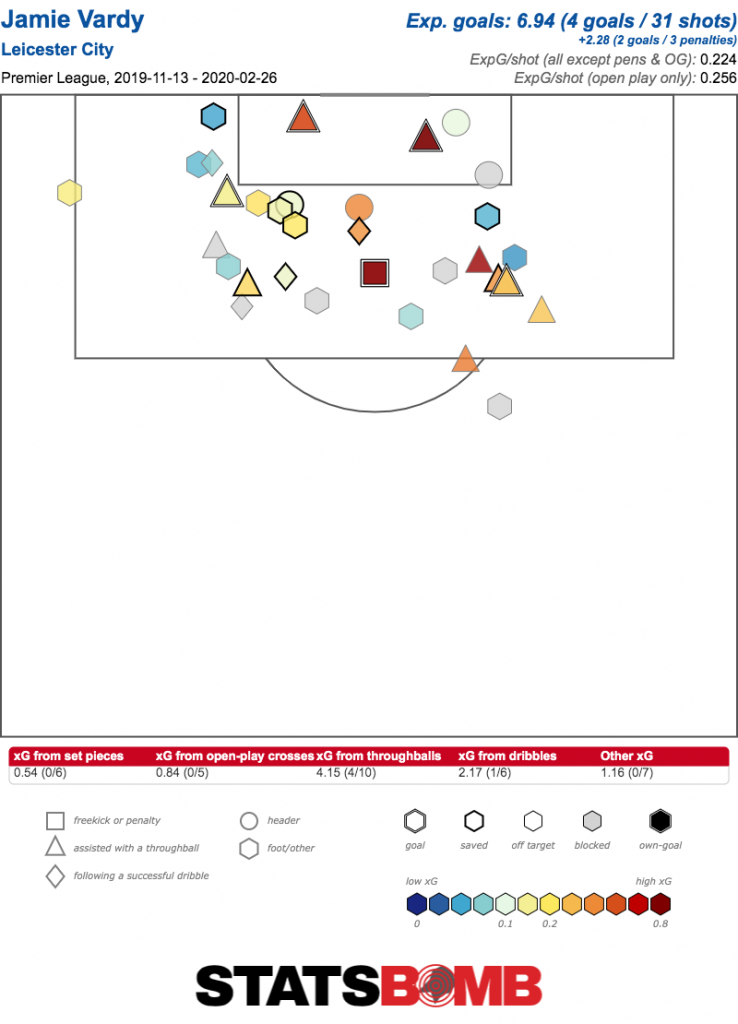
When you think of high pressing teams in England, your mind probably doesn’t go straight to Burnley. But StatsBomb’s pressure data currently has them with the third highest defensive distance in the Premier League. They continue to be fairly unique in their style.
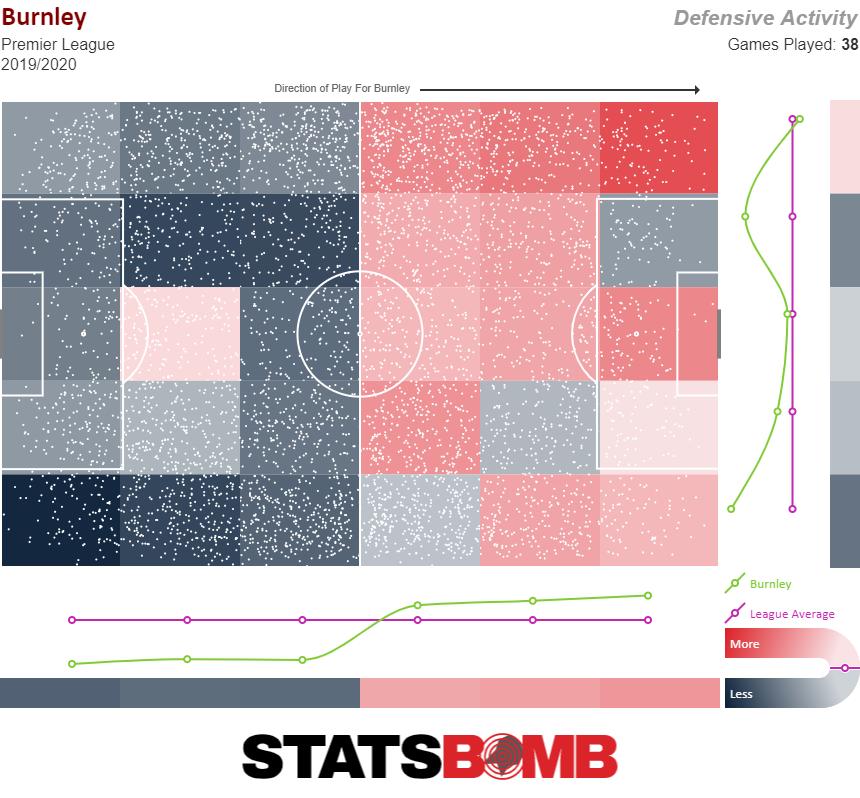
StatsBomb Podcast: February 2020 #3, Calvert Lewin, Bayern, Leicester Conference, Youth Development
Downloadable on the soundcloud link and also available on iTunes, subscribe HERE
RSS feed, if required, here
Also available on Spotify, Stitcher
Raheem Sterling leads the way by a large margin for players that carry the ball into the box:
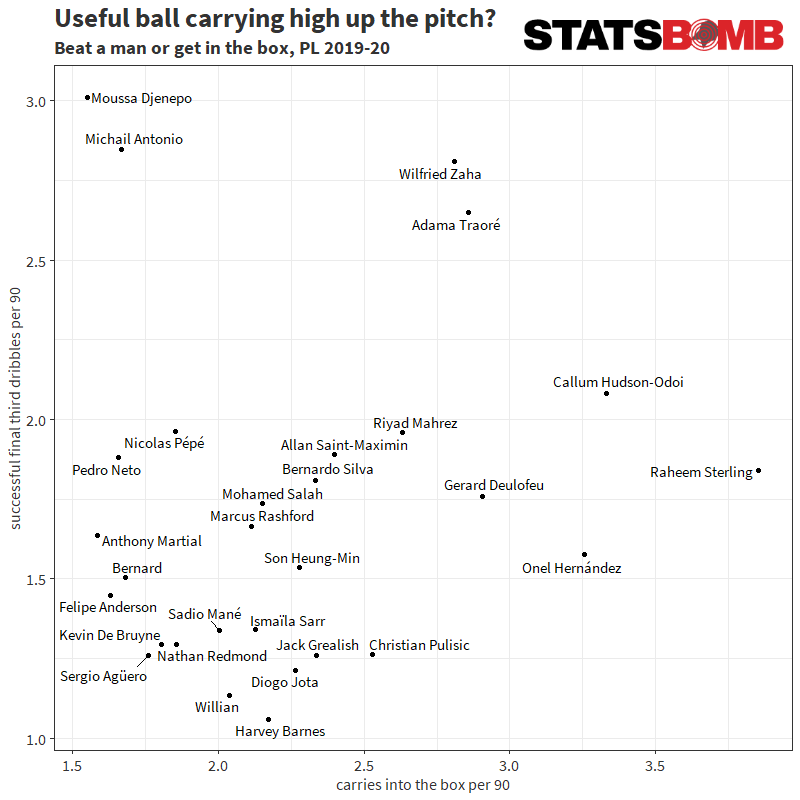
Dominic Calvert-Lewin has progressed year to year:
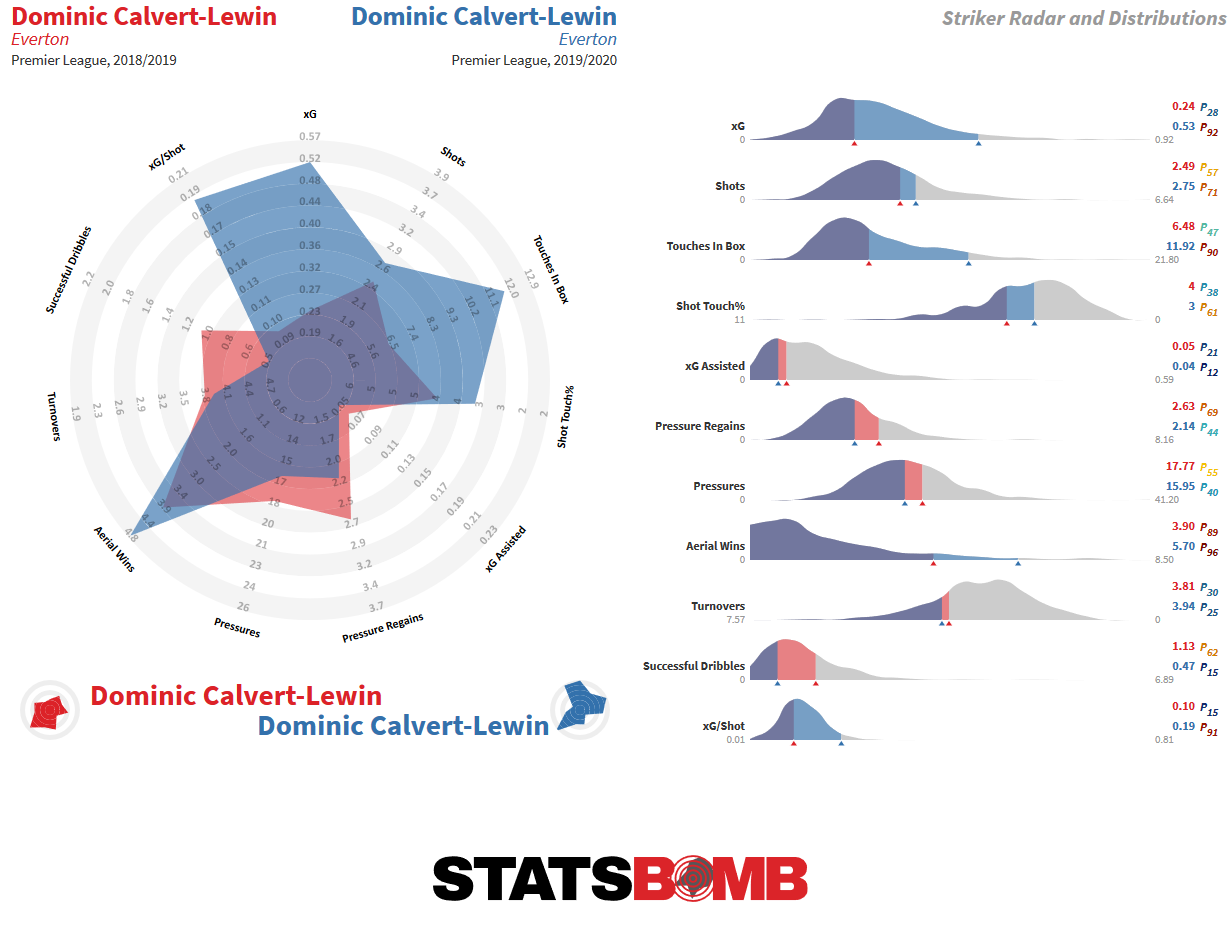 His shot map shows good locations both seasons with more inside the six yard box in 2019-20 and a large uptick in general shot quality:
His shot map shows good locations both seasons with more inside the six yard box in 2019-20 and a large uptick in general shot quality:
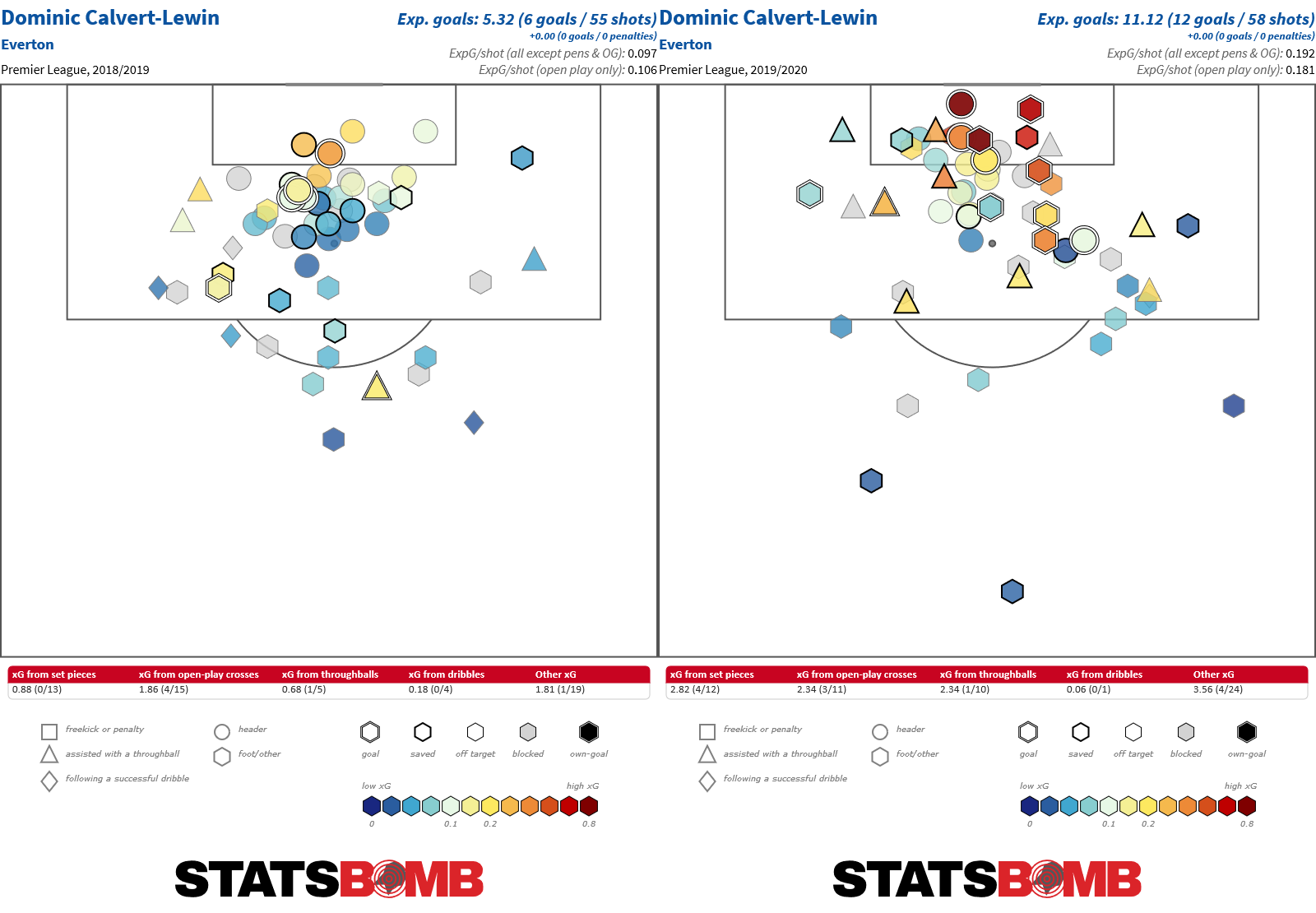
If we strip out headers, we see where the difference lies:
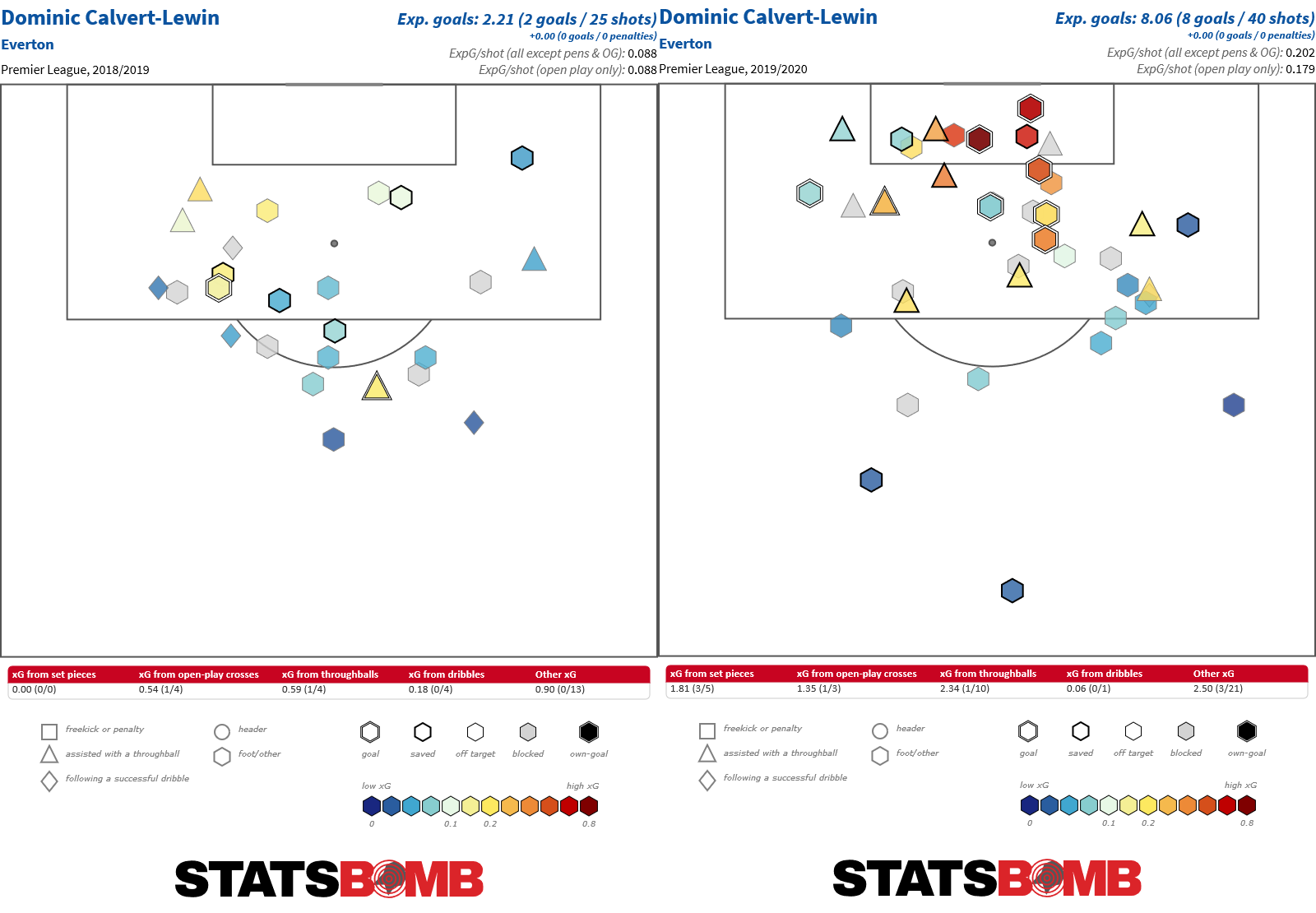
And Calvert-Lewin is a scarce player insofar as he wins a lot in the air and has great xG and goal numbers alongside, this list shows strikers that win more than 3 aerials per 90 and their goal and xG stats:
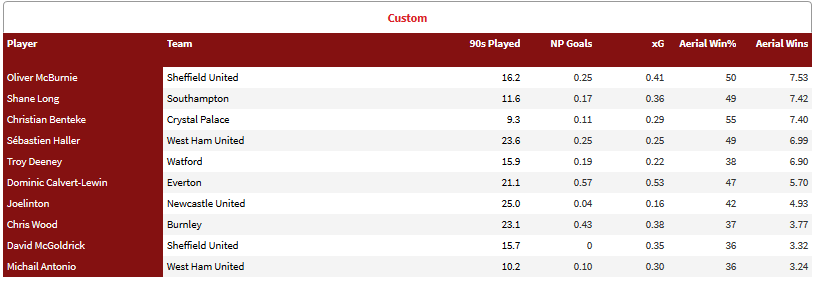
StatsBomb Champions League Primer: Napoli vs Barcelona and Chelsea vs Bayern Munich
Two more Champions League games to play today, so let’s get right to it.
Napoli vs Barcelona
Not all struggles are created equal. Barcelona are having a difficult season. They’ve changed managers, their major attacking signing, Antoine Griezmann, has failed to settle, their attacking play looks staid and boring. Things just aren’t going nearly as well as they could be at Camp Nou. Yet they’re also leading La Liga with 55 points, two ahead of Real Madrid. They’ve got the best expected goal total per match in Spain at 1.68 and the third-best xG conceded total at 0.79. So, like, there’s bad for Barcelona, and there’s actual bad, and this season clearly falls into the first category, not the second. Barcelona are the ultimate rates and levels team. The level of their play has been so high for so long, because Lionel Messi is a supernatural artifact bestowed upon us by technologically advanced soccer-loving aliens, that any drop in form seems like the end of the world. But really, they’re still a very very good team. New manager Quique Setien has helped steady the ship. And while he’s brought a somewhat unadventurous possession style to the team, the side's attacking play immediately improved, without much in the way of increased defensive problems. 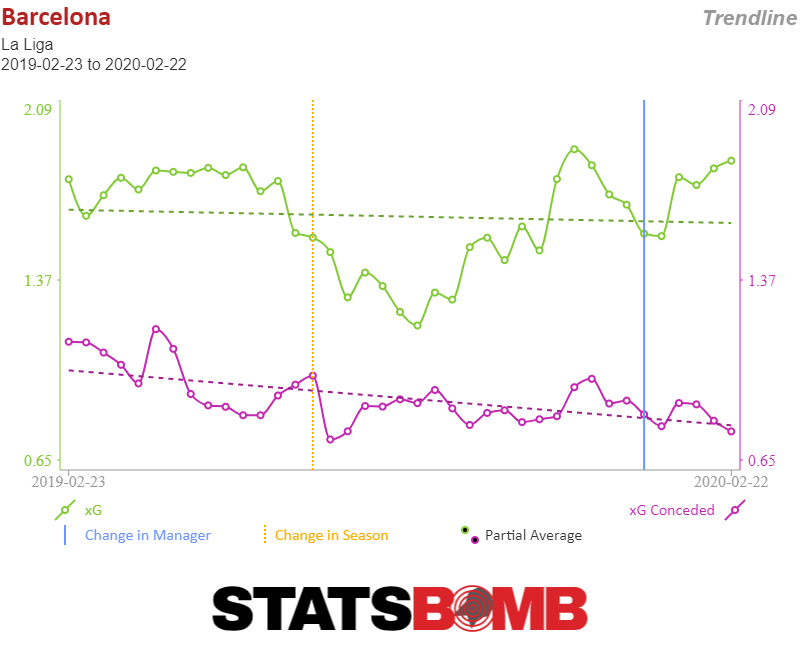 Barcelona’s main issue is still that everything runs through Messi. Five years ago their main problem was that everything ran through Messi, and the situation has only gotten more extreme since then. With Luis Suárez out, his combined goals and assists per 90 minutes are almost double anybody else’s on the team.
Barcelona’s main issue is still that everything runs through Messi. Five years ago their main problem was that everything ran through Messi, and the situation has only gotten more extreme since then. With Luis Suárez out, his combined goals and assists per 90 minutes are almost double anybody else’s on the team. 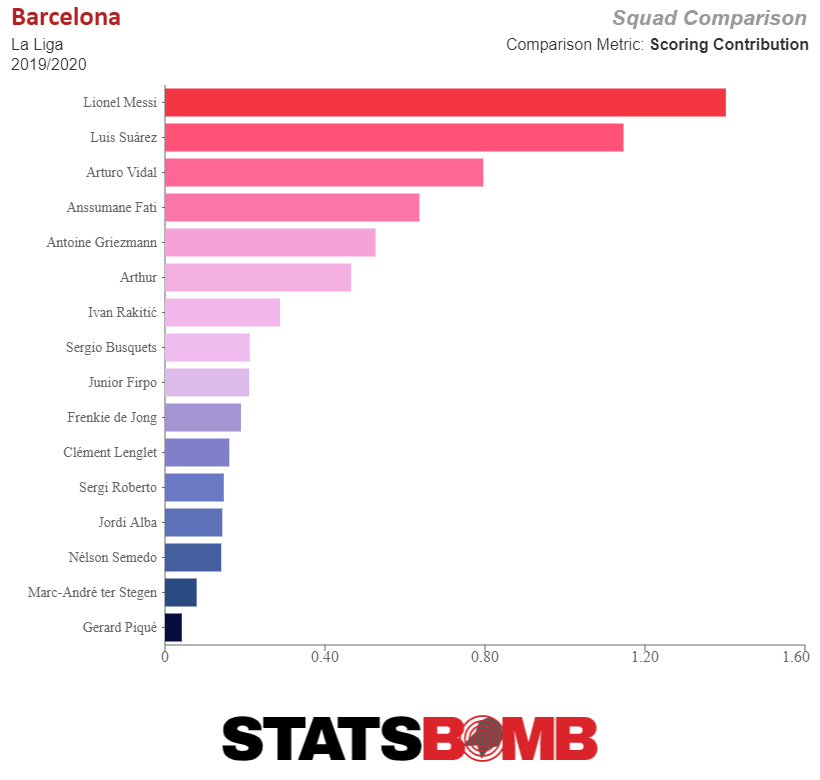 You’d be tempted to say it’s unsustainable, but, well, it’s Messi. Napoli’s situation is a little more complicated. On the one hand, they’re in sixth place with a goal difference of exactly four. That’s quite the drop for a team that spent years trailing only Juventus in Serie A. On the other hand, their xG difference of 0.55 is the fourth-best in the league and paints them in a considerably better light than their record and place in the table does. Put it all together and you have a Napoli team that is definitely worsening in comparison to seasons past, but not nearly as quickly as their drop down the table suggests. Specifically, from last year to this year the defense has eroded and they've gained little attacking input to compensate.
You’d be tempted to say it’s unsustainable, but, well, it’s Messi. Napoli’s situation is a little more complicated. On the one hand, they’re in sixth place with a goal difference of exactly four. That’s quite the drop for a team that spent years trailing only Juventus in Serie A. On the other hand, their xG difference of 0.55 is the fourth-best in the league and paints them in a considerably better light than their record and place in the table does. Put it all together and you have a Napoli team that is definitely worsening in comparison to seasons past, but not nearly as quickly as their drop down the table suggests. Specifically, from last year to this year the defense has eroded and they've gained little attacking input to compensate. 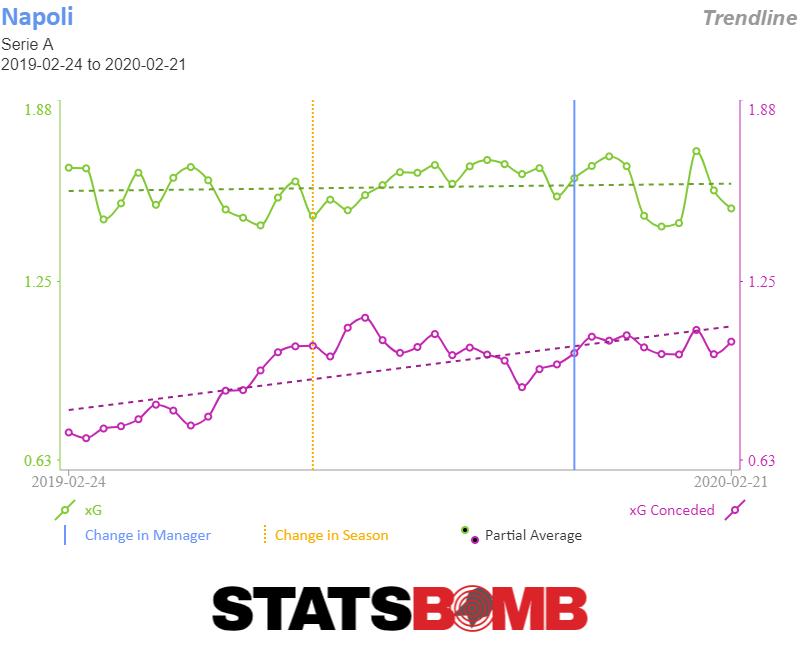 Nothing much has changed under new management. Carlo Ancelotti and his flexible 4-4-2 might have departed for Everton and been replaced by Gennaro Gattuso and a more traditional 4-3-3, but the basic contours of the problem remain exactly the same. Napoli are a pretty good side, but they aren’t as good as they used to be, and they certainly aren’t getting any better. Despite their struggles Barcelona are a significantly better side. When you’re a team that’s getting slowly worse it sure helps to have Lionel Messi.
Nothing much has changed under new management. Carlo Ancelotti and his flexible 4-4-2 might have departed for Everton and been replaced by Gennaro Gattuso and a more traditional 4-3-3, but the basic contours of the problem remain exactly the same. Napoli are a pretty good side, but they aren’t as good as they used to be, and they certainly aren’t getting any better. Despite their struggles Barcelona are a significantly better side. When you’re a team that’s getting slowly worse it sure helps to have Lionel Messi.
Chelsea v Bayern Munich
Two months ago a matchup between Chelsea and Bayern Munich might have looked like an opportunity for the English side to pull off a surprising upset. Bayern were in the midst of firing their manager while Chelsea were flying high off surprisingly strong performances from the youth movement who'd finally been given a chance. Then injuries hit Chelsea, Bayern righted the ship and now the task looks monumental for Frank Lampard’s men. Chelsea’s attack has tapered off dramatically. With Christian Pulisic out injured and Tammy Abraham injured, but not quite out, the side’s xG has really come back to earth since the turn of the year. 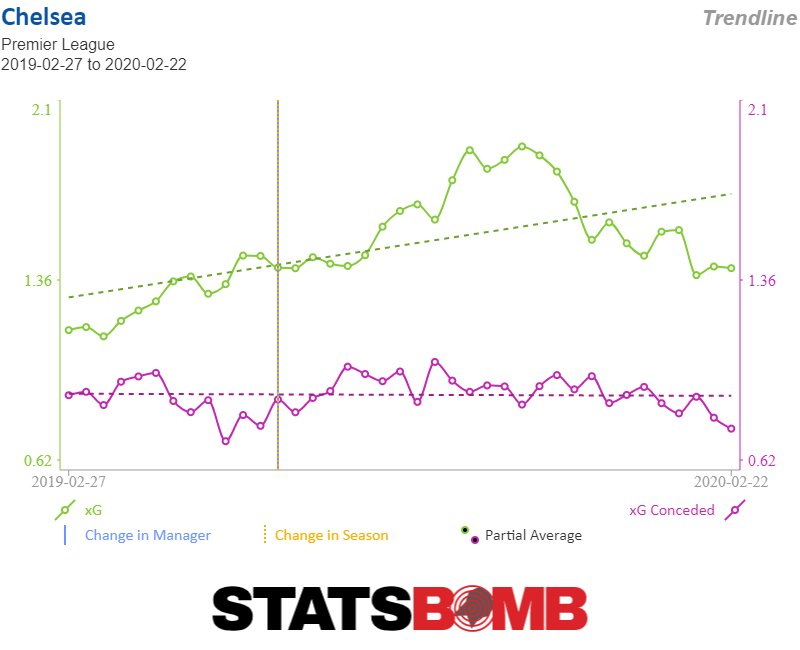 But, despite the attacking struggles, it’s really defensively where the Blues are likely to get exposed against Bayern. Chelsea are a very aggressive defensive side. They don’t know how to sit back and instead want to press from the front and defend in their opponent’s half. At their best they create opportunities for their attacking trio by winning the ball high up the pitch. At their worst they end up playing destabilized football, exposing themselves to opponents who are disciplined enough to hold the ball against them.
But, despite the attacking struggles, it’s really defensively where the Blues are likely to get exposed against Bayern. Chelsea are a very aggressive defensive side. They don’t know how to sit back and instead want to press from the front and defend in their opponent’s half. At their best they create opportunities for their attacking trio by winning the ball high up the pitch. At their worst they end up playing destabilized football, exposing themselves to opponents who are disciplined enough to hold the ball against them. 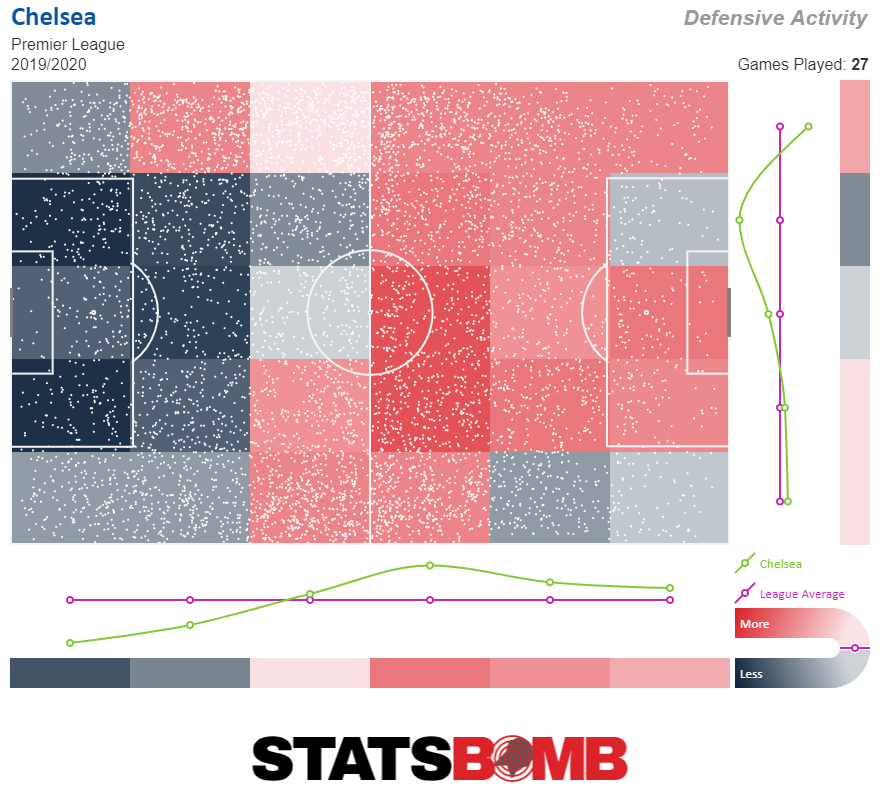 Bayern are clearly disciplined enough. The side's high-powered midfield often features Joshua Kimmich at the base, and he’s simply a machine at moving the ball up the field without losing possession.
Bayern are clearly disciplined enough. The side's high-powered midfield often features Joshua Kimmich at the base, and he’s simply a machine at moving the ball up the field without losing possession. 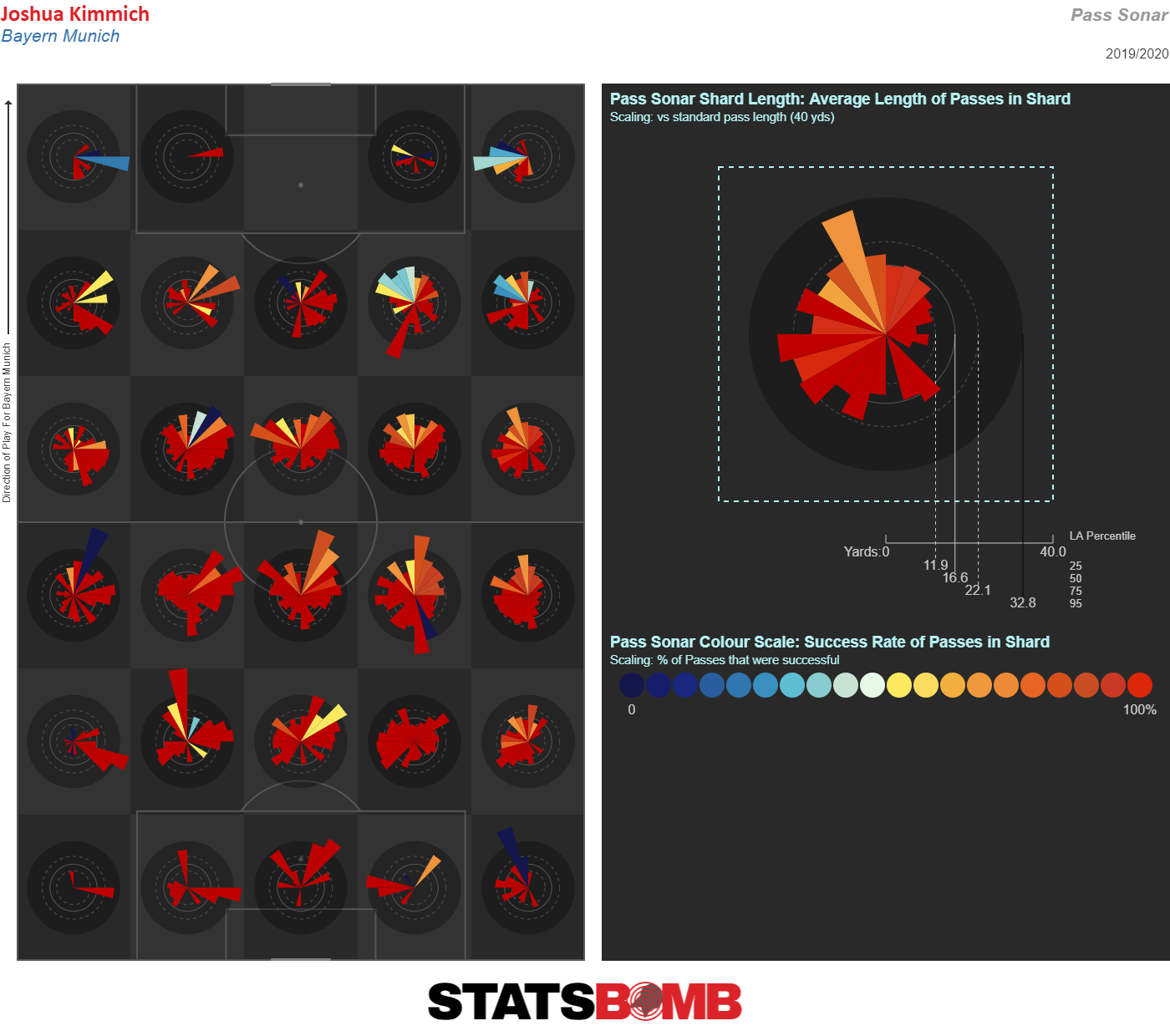 The same is true of Thiago, who both advances the ball from deep and moves forward to help orchestrate the attack.
The same is true of Thiago, who both advances the ball from deep and moves forward to help orchestrate the attack. 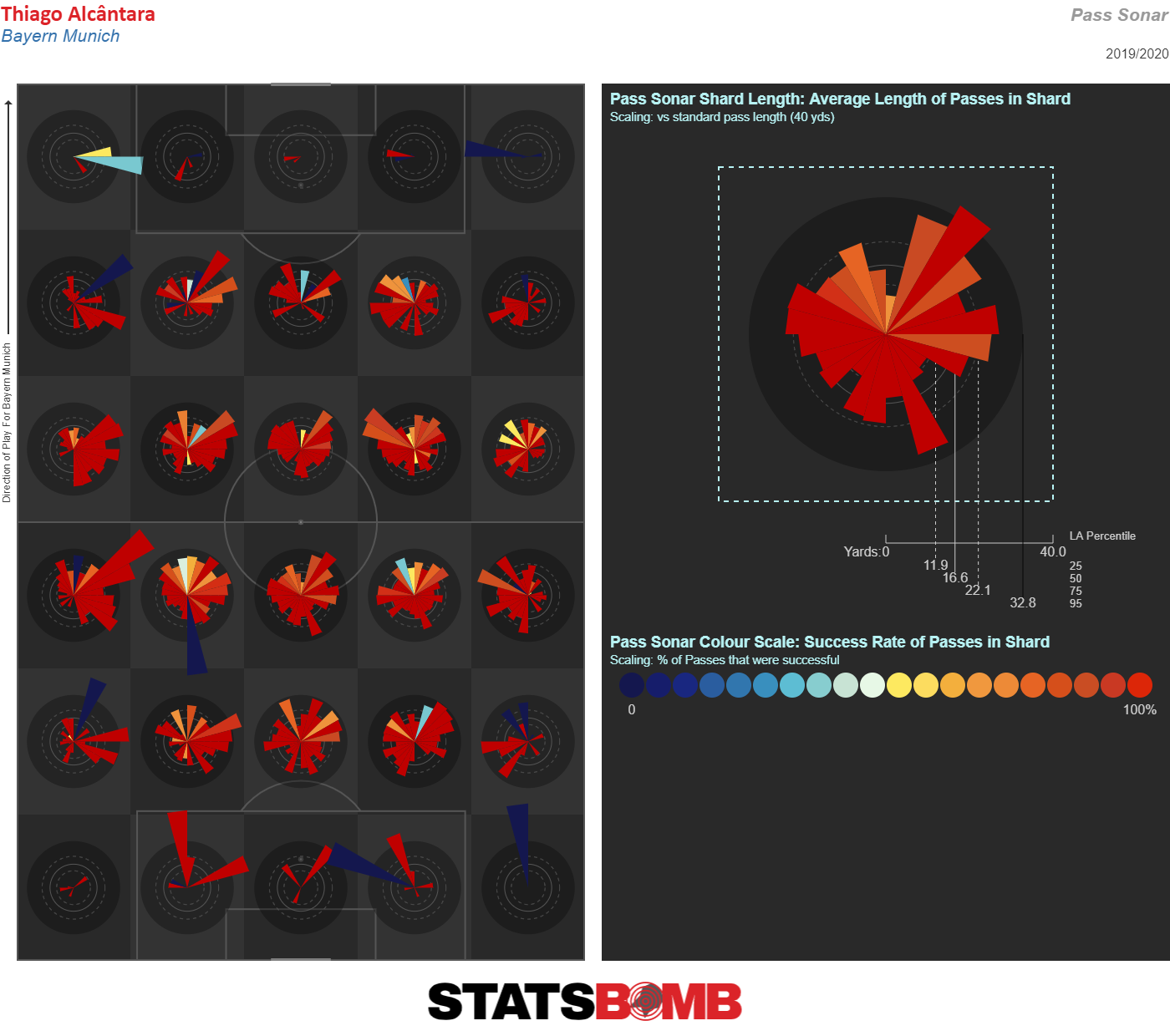 It’s possible that a disciplined underdog might cause Bayern problems. Their attacking front line is great, and Robert Lewandowski continues to have an all-timer of a season, smashing goals from the best spots in the world.
It’s possible that a disciplined underdog might cause Bayern problems. Their attacking front line is great, and Robert Lewandowski continues to have an all-timer of a season, smashing goals from the best spots in the world. 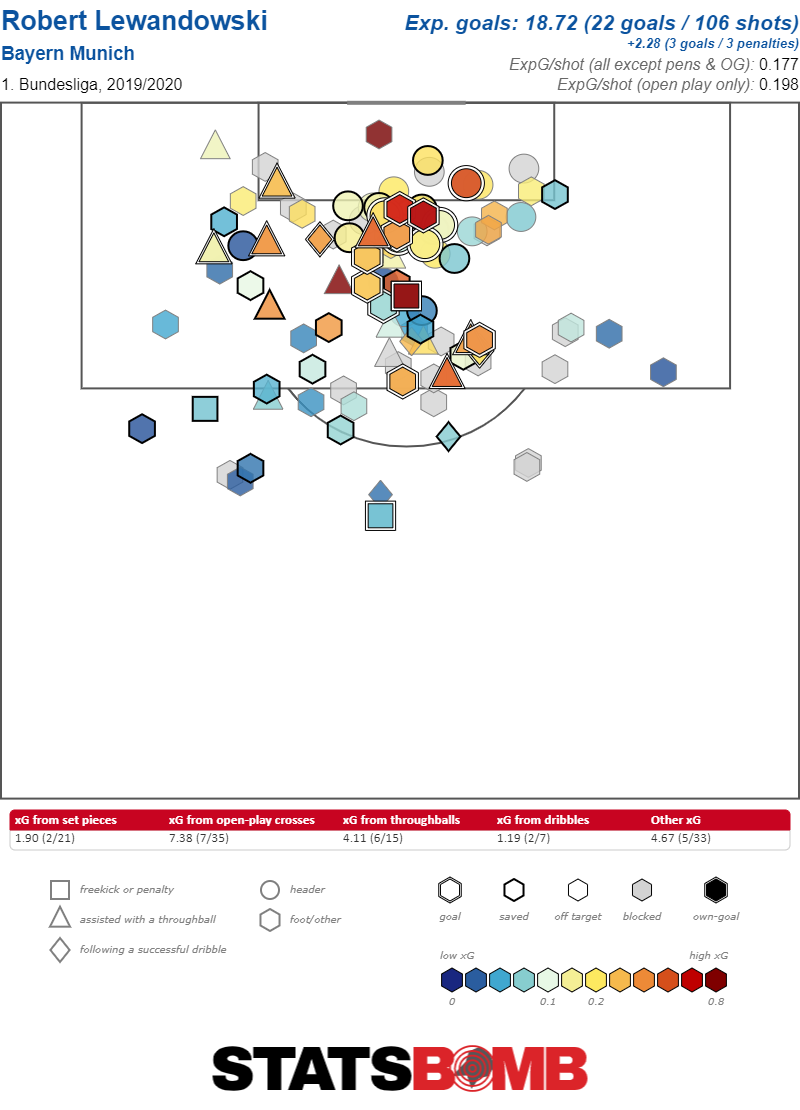 But, maybe under the right circumstances, with a little bit of luck and a lot of deep defending an underdog could hold them and exploit the German giants on the counterattack. Chelsea under Lampard simply don’t have that club in their bag. In order to win they’re going to need Bayern’s midfield to crack under the pressure they apply. That seems exceedingly unlikely to happen.
But, maybe under the right circumstances, with a little bit of luck and a lot of deep defending an underdog could hold them and exploit the German giants on the counterattack. Chelsea under Lampard simply don’t have that club in their bag. In order to win they’re going to need Bayern’s midfield to crack under the pressure they apply. That seems exceedingly unlikely to happen.
Unpacking the League One promotion race
Death, taxes, some form of end-of-season carnage in League One. The three certainties of life on planet Earth. At this point last season, it was the relegation battle encompassing 50% of the division that was causing palpitations across the third tier on a weekly basis. This season the logjam occurs at the top: eight points separates Rotherham in 1st with Ipswich in 8th. It’s jostling, bunching, tight and bordering on claustrophobic. At least two of the sides that have eyes focused squarely on promotion won’t even make the end of season play-offs. It’s someone’s job to sift through it all to help form a clearer picture for you ahead on the run-in, and the pleasure is all mine. Looking to complete another rotation of their perpetual yo-yoing are current leaders of the pack, Rotherham. Paul Warne hasn’t quite refined the formula to keep the club in the Championship yet, but the managerial alchemist seems to have found a potent combination to securing promotion from League One, something he’ll have achieved twice in two attempts should the Millers get over the line. The elements at the forefront of this formula are straightforward: pressing & set pieces. No team in the league presses harder or higher than Rotherham… 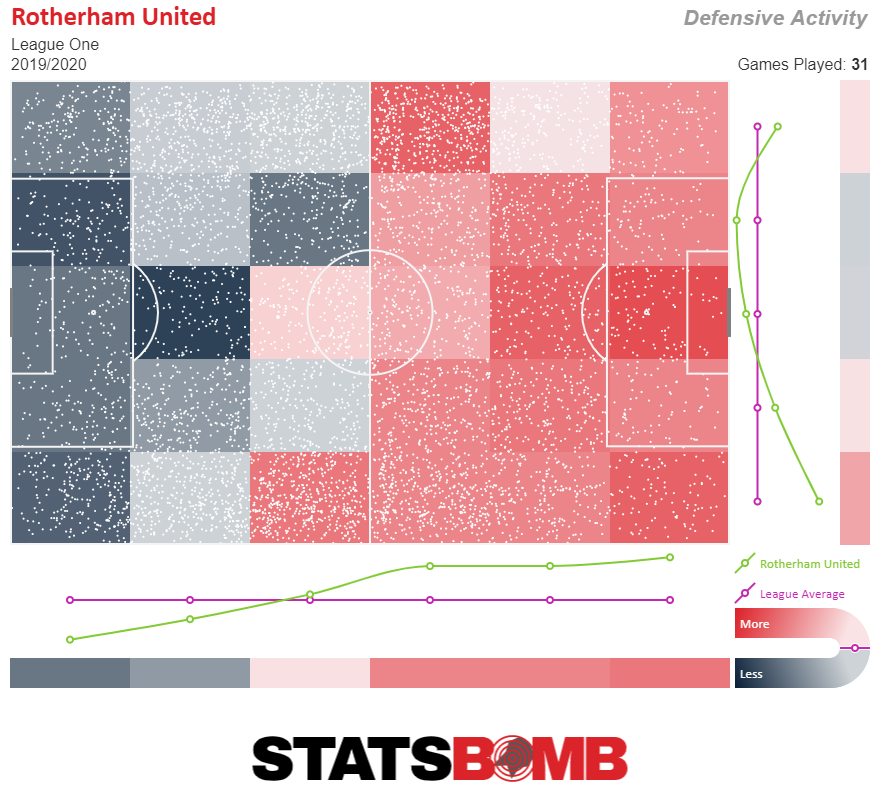 … which just makes them an unpleasant and uncomfortable side to play against: 90 minutes of constant duelling all over the pitch, on the ground and in the air. 28% of the opposition’s passes are pressed aggressively by Rotherham, the highest percentage in League One. As well as making the opposition run a red and white gauntlet, they match this with a, frankly absurd, set piece threat, scoring 21 set piece goals in 31 matches.
… which just makes them an unpleasant and uncomfortable side to play against: 90 minutes of constant duelling all over the pitch, on the ground and in the air. 28% of the opposition’s passes are pressed aggressively by Rotherham, the highest percentage in League One. As well as making the opposition run a red and white gauntlet, they match this with a, frankly absurd, set piece threat, scoring 21 set piece goals in 31 matches. 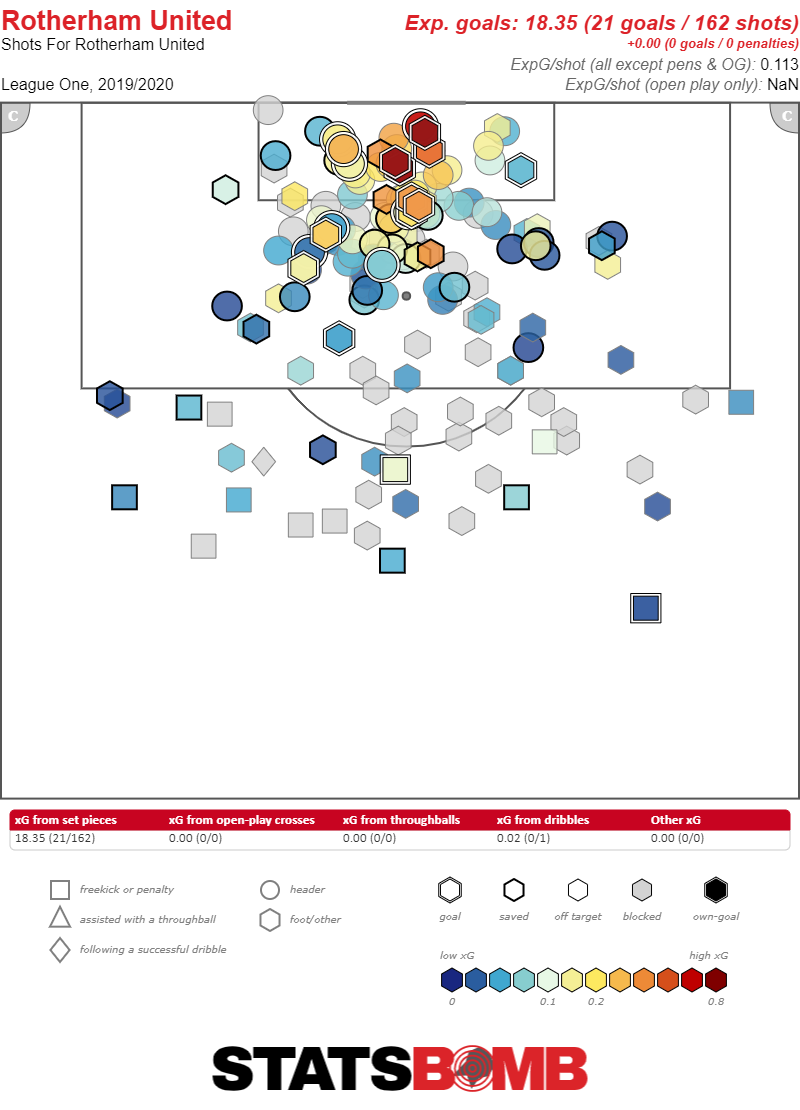 Another note is the fitness levels of the side, owed in large part to Warne’s previous role as a fitness coach. Where the rest of the league may be just starting to flag with the majority of a gruelling season behind them, the Millers may only just be hitting their peak. An ominous sign to their promotion rivals. A strong run has propelled Coventry from play-off hopefuls into the automatic promotion places. Were the Sky Blues to go up this season it would be the culmination of three years of upward trajectory under Mark Robins, after securing a play-off promotion from League Two in 2017-18 and just missing out on a play-off berth in last season’s League One. It’s as commendable as it is surprising that Coventry have managed to hit these heights despite being forced to play their home games at a neutral venue, but equally impressive is that they’re doing so with the 2nd youngest squad on average across the whole division. Their collection of early and mid-peak players has swept aside far more experienced campaigners to get to this position, playing an easy-on-the-eye short passing possession game in the process.
Another note is the fitness levels of the side, owed in large part to Warne’s previous role as a fitness coach. Where the rest of the league may be just starting to flag with the majority of a gruelling season behind them, the Millers may only just be hitting their peak. An ominous sign to their promotion rivals. A strong run has propelled Coventry from play-off hopefuls into the automatic promotion places. Were the Sky Blues to go up this season it would be the culmination of three years of upward trajectory under Mark Robins, after securing a play-off promotion from League Two in 2017-18 and just missing out on a play-off berth in last season’s League One. It’s as commendable as it is surprising that Coventry have managed to hit these heights despite being forced to play their home games at a neutral venue, but equally impressive is that they’re doing so with the 2nd youngest squad on average across the whole division. Their collection of early and mid-peak players has swept aside far more experienced campaigners to get to this position, playing an easy-on-the-eye short passing possession game in the process. 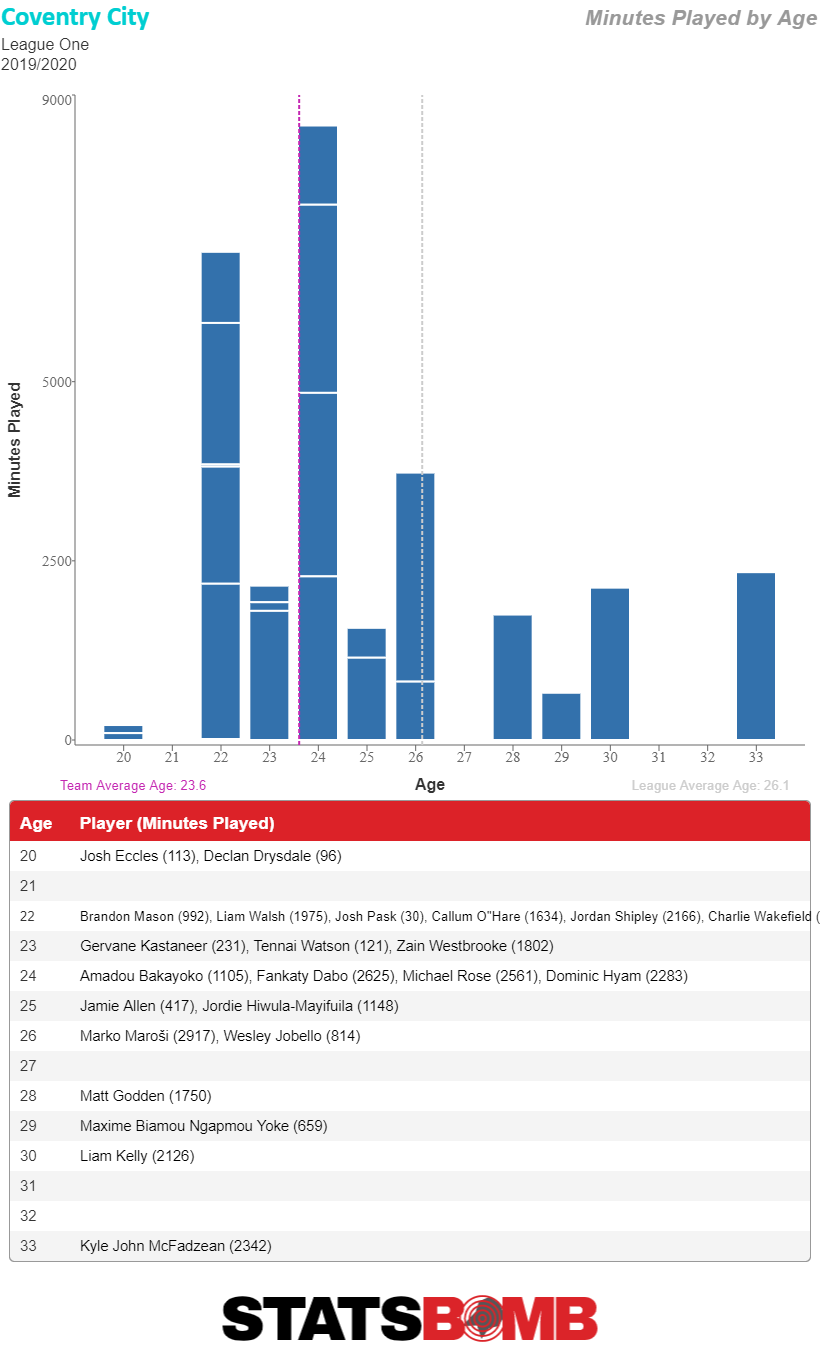 Despite the acclaim for their on-ball work, it’s as much their shape out of possession that has led them to this position, having only been defeated on three occasions this season and conceding the joint-fewest shots per game alongside Rotherham. Wycombe’s unlikely rise to the top of the division in the first half of the season was eye-catching and eyebrow-raising in equal measure. As more fancied outfits stalled around them, the Chairboys stole a march and they remain in contention despite being clawed back into the pack more recently. Part of their unlikely rise was owed in-part to a bit of a statistical freak when they embarked on a run of eight games between October and December in which they conceded just one goal, scored ten and managed to go W6 D2 L0. Seven clean sheets in eight games was some doing and they’d given very few genuine chances away in that time but of their opponents’ 101 shots, just 10 hit the target and just one made it into the net. A 1% conversion rate is rare at any level even in small eight game samples.
Despite the acclaim for their on-ball work, it’s as much their shape out of possession that has led them to this position, having only been defeated on three occasions this season and conceding the joint-fewest shots per game alongside Rotherham. Wycombe’s unlikely rise to the top of the division in the first half of the season was eye-catching and eyebrow-raising in equal measure. As more fancied outfits stalled around them, the Chairboys stole a march and they remain in contention despite being clawed back into the pack more recently. Part of their unlikely rise was owed in-part to a bit of a statistical freak when they embarked on a run of eight games between October and December in which they conceded just one goal, scored ten and managed to go W6 D2 L0. Seven clean sheets in eight games was some doing and they’d given very few genuine chances away in that time but of their opponents’ 101 shots, just 10 hit the target and just one made it into the net. A 1% conversion rate is rare at any level even in small eight game samples. 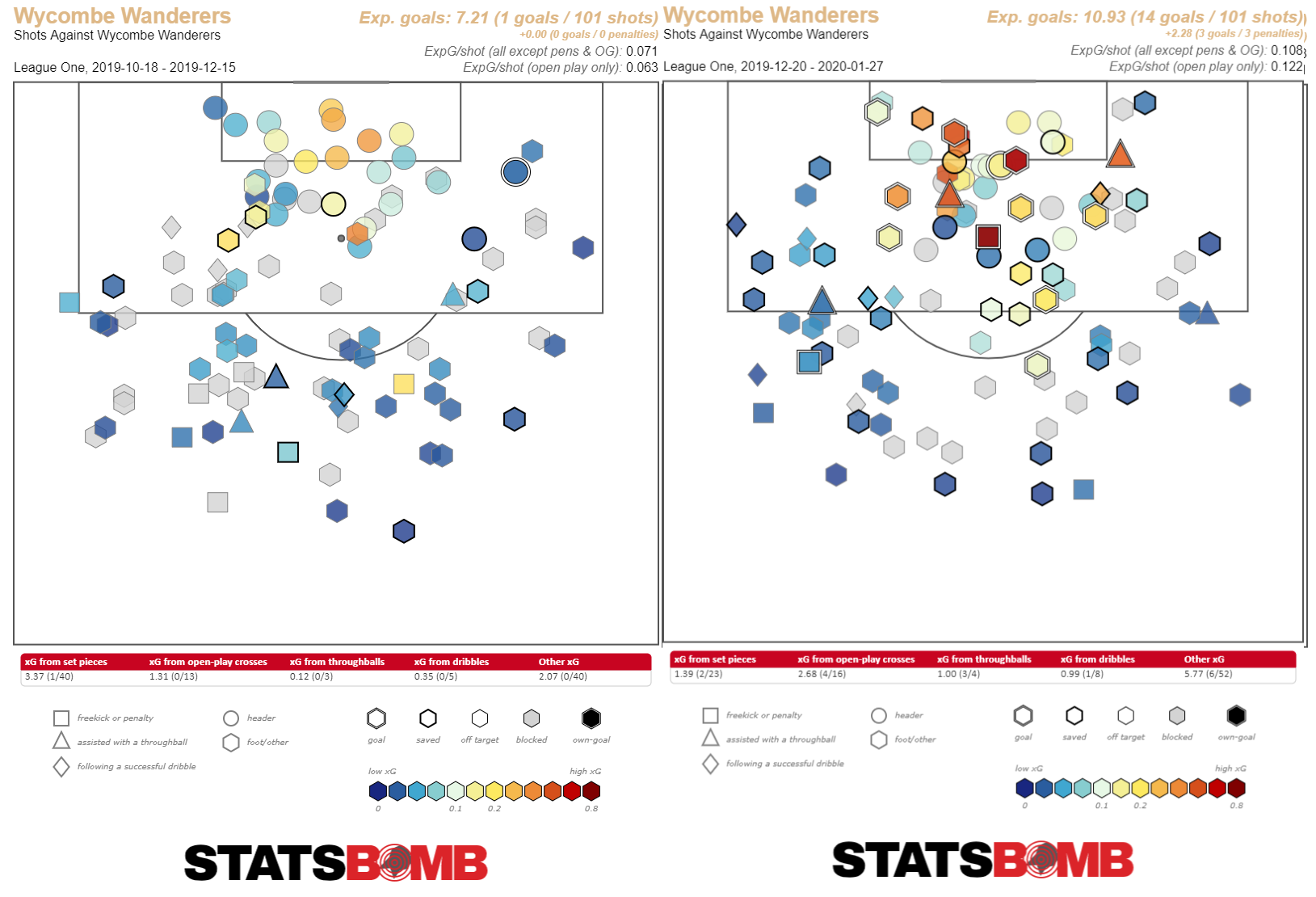 I reiterate that Wycombe defended well in that time but cruelly, as if to ram home the point of how unlikely it was, from their next 101 shots Wycombe conceded 14 goals and their lead at the top was eaten up. Given their position, no one will tell Wycombe not to shoot for the stars and outrun their pre-season expectations by as great a margin as possible from here. As unlikely as it is, we’ve seen unlikely occurrences at Adams Park already this season, so why not another? Next… Sunderland AFC [suhn-der-luh nd] noun
I reiterate that Wycombe defended well in that time but cruelly, as if to ram home the point of how unlikely it was, from their next 101 shots Wycombe conceded 14 goals and their lead at the top was eaten up. Given their position, no one will tell Wycombe not to shoot for the stars and outrun their pre-season expectations by as great a margin as possible from here. As unlikely as it is, we’ve seen unlikely occurrences at Adams Park already this season, so why not another? Next… Sunderland AFC [suhn-der-luh nd] noun
- A football team located in a Tyne and Wear seaport, in North East England.
- A vortex. Defined as that downward swirling motion regularly observed in nature, often during volatile environmental conditions. A vortex is manifested in different forms, such as tornadoes, whirlpools, or a flushing toilet.
I’ll let you decide which of those forms best describes Sunderland’s recent years. Joking aside, it genuinely appears that Sunderland might have found the saviour to kick that downward swirling motion into reverse. The most confounding thing about Phil Parkinson’s impact in turning the team around was that his first milestone as the new manager was to lead them to the lowest league position in their history on Christmas Day 2019 after picking up just eight points in his first eight games, leaving them in the bottom half of the table. Surely the only thing that’d turn the season and get the fans onside would be a run of 30 points from the next 13 games? Thankfully for Parkinson, that’s what he managed to achieve and promotion rivals are now shifting nervously as the Black Cats pick up that all important momentum (and other such proverbials) heading into the final straight. Eight clean sheets in their last nine means Sunderland now have the best defensive record in the league but another piece of good work by Parkinson has been to get Lynden Gooch firing and showing his best form since their relegation. 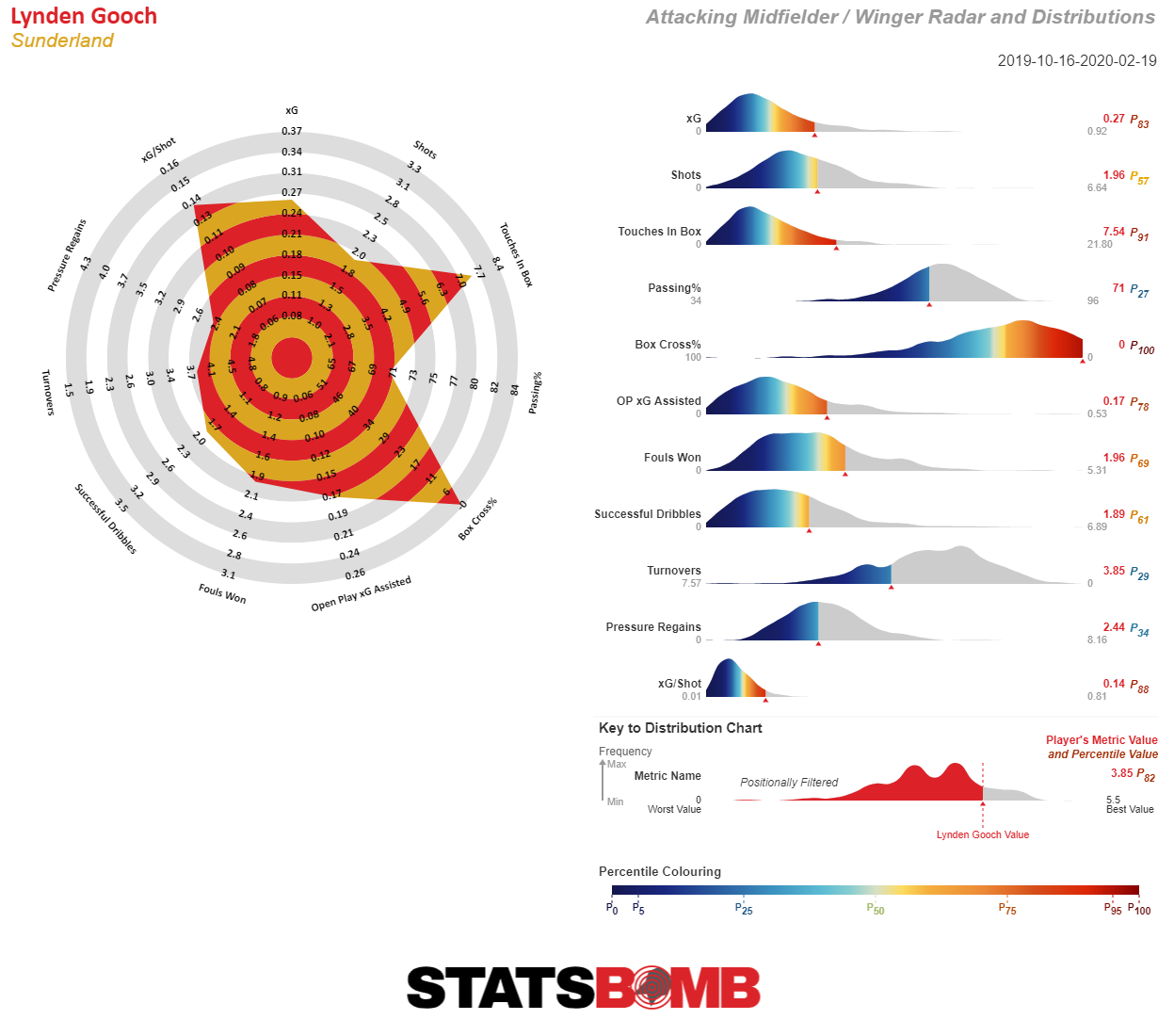 A quick and easy way to summarise Peterborough’s season so far would be to examine their expected goals trendlines.
A quick and easy way to summarise Peterborough’s season so far would be to examine their expected goals trendlines. 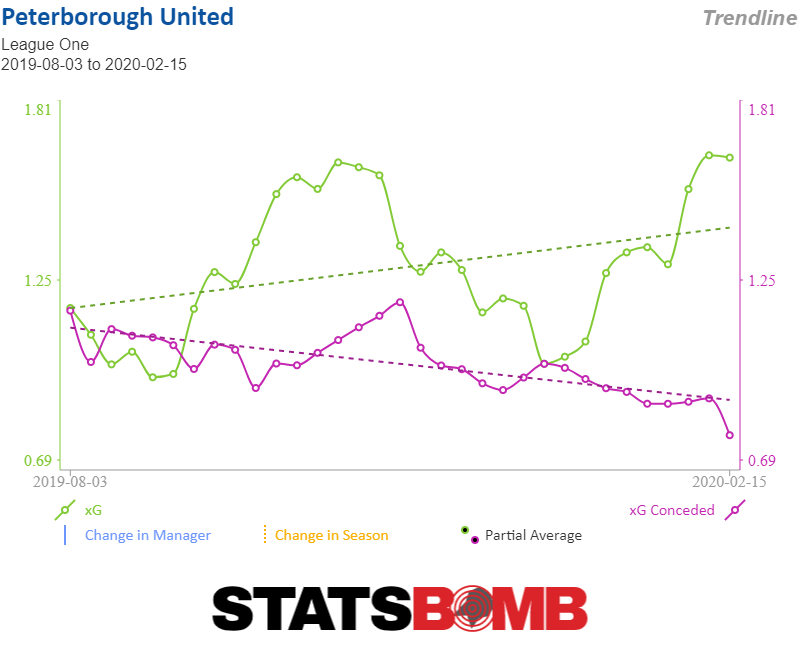 There’s been three strong periods of narrative amongst the fanbase which I’ll annotate below:
There’s been three strong periods of narrative amongst the fanbase which I’ll annotate below:
- Early peak: “Wow, we cannot stop scoring goals! Marcus Maddison, Mo Eisa and Ivan Toney are the Holy Trinity of goalscoring and creativity!”
- Middle trough: “Wow, whatever this is, it is not working. Marcus Maddison sold, Mo Eisa dropped. Please ditch the diamond formation.”
- Late peak: “Wow, we cannot stop scoring goals! Sammy Szmodics, Siriki Dembele and Ivan Toney are the Holy Trinity of goalscoring and creativity!”
In all seriousness, Darren Ferguson gets credit for successfully changing the shape and personnel of the team when it stopped working to keep the promotion aim alive, a major quirk of Peterborough’s season being the difference in the first-choice team being five, if not six, players different to the first choice used during the early season good form. If Peterborough do seal promotion then a lot will be down to the form of Ivan Toney up front, who has made the leap from flashes of potential to simply far too good for this level. The January-acquired support act of Sammy Szmodics has also proven to be a shrewd signing and not just because of his four goals and three assists in his first seven appearances for Posh; his movement in the hole both when Peterborough have and do not have possession has been far more effective to the system than that of predecessor Marcus Maddison. Five wins in a row sees Fleetwood make a timely run into the top six. A recent run of seven draws in nine games threatened to blow their promotion ambitions off course but the evolution in the team since the turn of the year looks to be paying off. More mobility has been added to the backline in Everton loanees Callum Connolly and Lewis Gibson, counterbalanced with the installation of he-of-over-200-Premier-League-appearances Glenn Whelan to central midfield, and the tweaks appear to have taken the Cod Army to a new level. 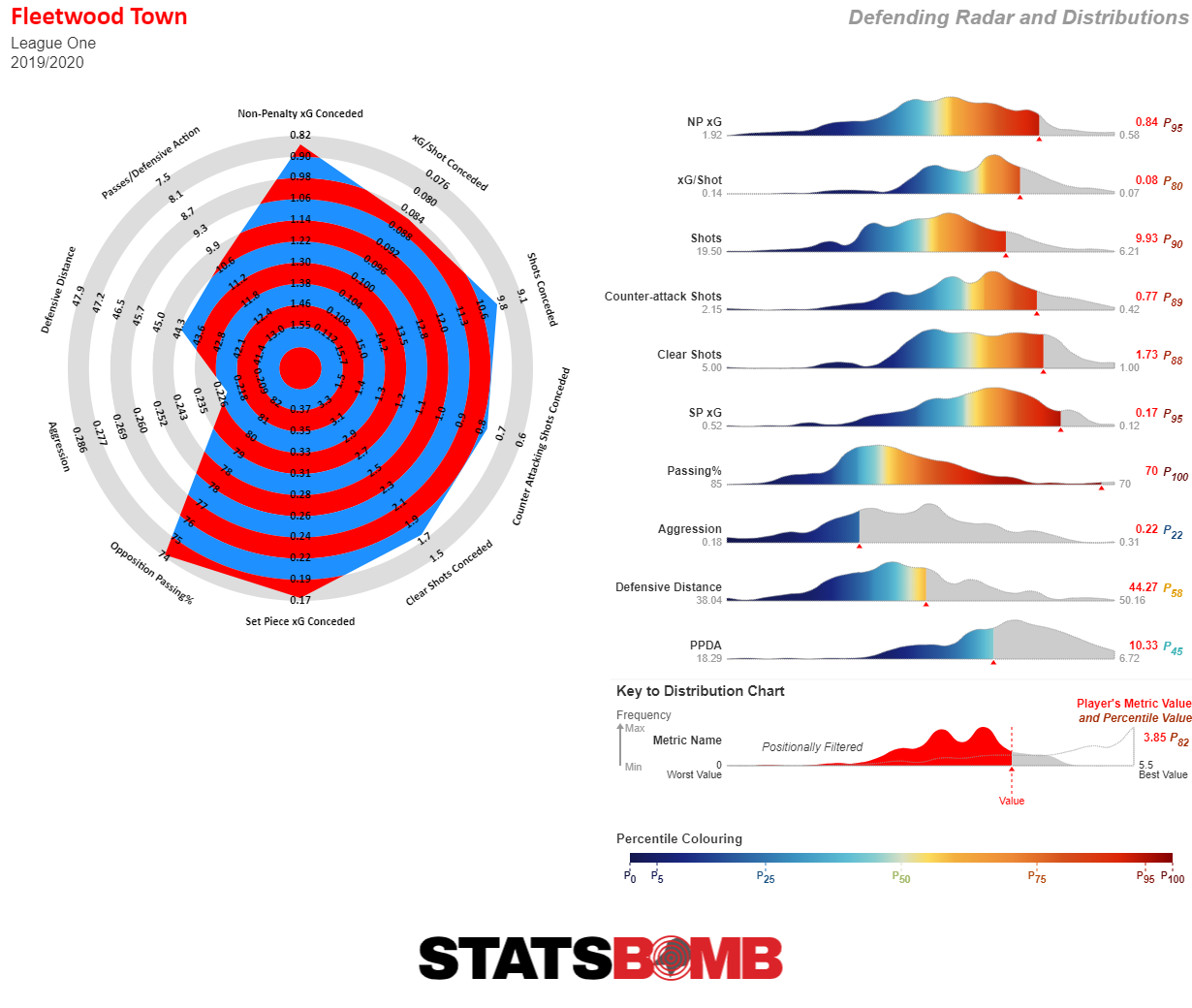 For a team that has spent more time out of the top six than in it this season, the signs, particularly defensively, have always been there in the underlying numbers that they could be capable of ending up there. They give away fewer than 10 shots per game, which are rarely of a clear-cut quality, and give very little away on set plays. A foundation as solid as that could enable Fleetwood to swim upstream, through the busy logjam and into Championship waters. Portsmouth are another resurgent force hitting form at the right time of the season. Falling in last season’s play-offs, Pompey were pre-season favourites to win the league this time around but found themselves as low as 16th in November. The early struggles were a result of the slight flaws in Kenny Jackett’s system being exposed repeatedly. There were numerous games in the early stages where Pompey would have an equal or better part of the game, and either go behind in unlikely circumstances or routinely concede an equaliser having looked to defend any lead they’d gained, when if anything they’d had the better opportunities to extend their lead. They simply couldn’t close a game out. The performances during this run were never as bad as the results they were getting and below highlights the disparity between Portsmouth’s expected goal difference and actual goal difference in the earlier part of the season, with green shade representing an underperformance.
For a team that has spent more time out of the top six than in it this season, the signs, particularly defensively, have always been there in the underlying numbers that they could be capable of ending up there. They give away fewer than 10 shots per game, which are rarely of a clear-cut quality, and give very little away on set plays. A foundation as solid as that could enable Fleetwood to swim upstream, through the busy logjam and into Championship waters. Portsmouth are another resurgent force hitting form at the right time of the season. Falling in last season’s play-offs, Pompey were pre-season favourites to win the league this time around but found themselves as low as 16th in November. The early struggles were a result of the slight flaws in Kenny Jackett’s system being exposed repeatedly. There were numerous games in the early stages where Pompey would have an equal or better part of the game, and either go behind in unlikely circumstances or routinely concede an equaliser having looked to defend any lead they’d gained, when if anything they’d had the better opportunities to extend their lead. They simply couldn’t close a game out. The performances during this run were never as bad as the results they were getting and below highlights the disparity between Portsmouth’s expected goal difference and actual goal difference in the earlier part of the season, with green shade representing an underperformance. 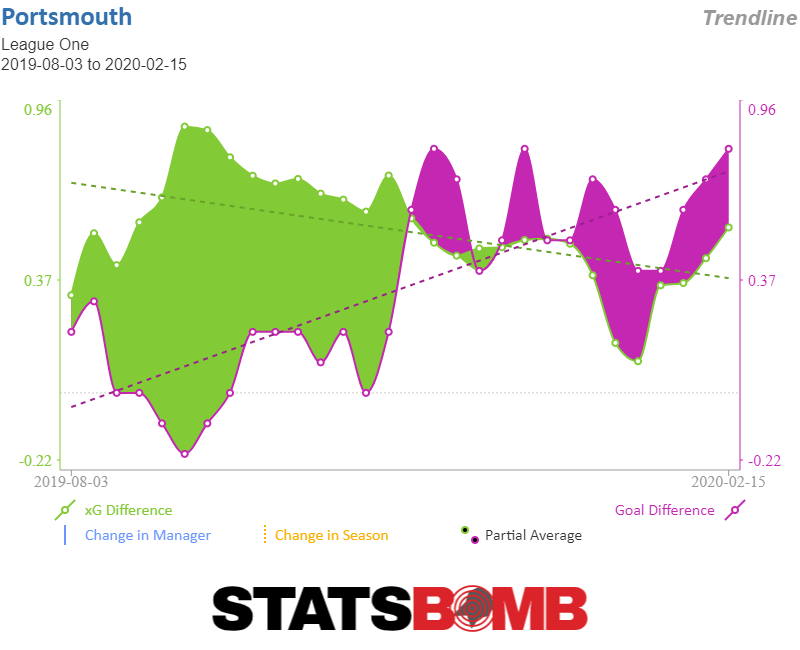 The early struggles prompted Kenny Jackett to rethink the process and the answer he came up with was to shift the team up the pitch, pressing higher and aiming to disrupt the opposition’s build up further away from Portsmouth’s goal. You’ll see below, the average distance away from their own goal that they’re committing defensive actions (in purple) has increased, with the amount of passes the opposition are allowed to complete before a Portsmouth defensive action (in green) has decreased.
The early struggles prompted Kenny Jackett to rethink the process and the answer he came up with was to shift the team up the pitch, pressing higher and aiming to disrupt the opposition’s build up further away from Portsmouth’s goal. You’ll see below, the average distance away from their own goal that they’re committing defensive actions (in purple) has increased, with the amount of passes the opposition are allowed to complete before a Portsmouth defensive action (in green) has decreased. 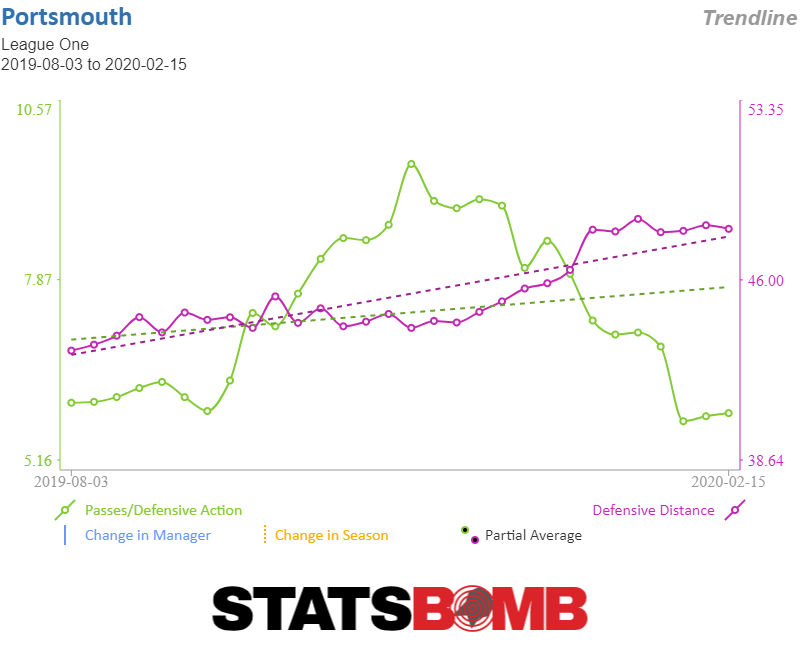 The introduction of the energetic Andy Cannon to the #10 position as well as the January acquisition of Cameron McGeehan has helped to alter the balance of the side in a positive way and hopes of going one further than last season are far from extinguished. When I put it to you that Ipswich have picked up 25 points from their last 22 games you would be perfectly entitled to wonder how they remain in this race. They exploded out of the blocks with 8 wins in their first 11 games but the downward trend in both results and performances has seen them fall flat on their face since. Only a reverse of those trends would see an automatic promotion place become theirs.
The introduction of the energetic Andy Cannon to the #10 position as well as the January acquisition of Cameron McGeehan has helped to alter the balance of the side in a positive way and hopes of going one further than last season are far from extinguished. When I put it to you that Ipswich have picked up 25 points from their last 22 games you would be perfectly entitled to wonder how they remain in this race. They exploded out of the blocks with 8 wins in their first 11 games but the downward trend in both results and performances has seen them fall flat on their face since. Only a reverse of those trends would see an automatic promotion place become theirs. 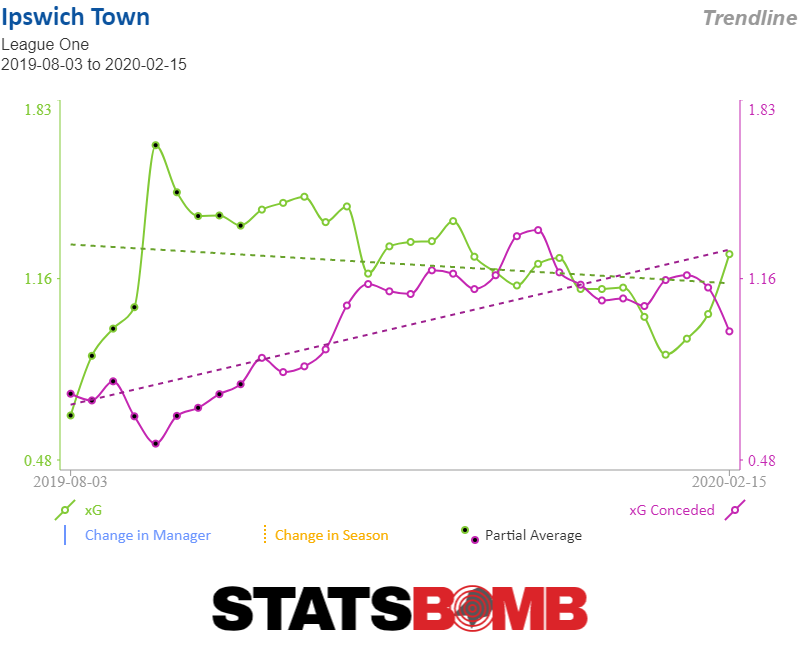 Exactly why their early season results contrast so starkly from runaway title winning standard to bottom-half struggler standard seems to be a cocktail of factors. They were wildly overperforming in the early stages: on-pitch performances were never as good as such a dominant run of results and inevitably results were always going to come back down to earth a bit. Secondly, the long-term injury to flying wing-back Kane Vincent-Young, who gave the team real attacking impetus on the right flank which has so far proven to be irreplaceable. The juggling between teams and systems to try and redress that imbalance is the third factor; the level of rotation and tinkering between personnel and team shape without identifying a solution that works. Fourth is just good old player form. Only Flynn Downes has performed to a consistently good level for Ipswich this season, look across the rest of the side and it’s hard to spot a player that’s made a significant impact on the division, with individuals showing form in bursts but never across a prolonged stretch of games. That said, there’s still 25% of the season in which to fix those issues, but in order to go up Ipswich will have to start doing something we haven’t seen them do for half a season now.
Exactly why their early season results contrast so starkly from runaway title winning standard to bottom-half struggler standard seems to be a cocktail of factors. They were wildly overperforming in the early stages: on-pitch performances were never as good as such a dominant run of results and inevitably results were always going to come back down to earth a bit. Secondly, the long-term injury to flying wing-back Kane Vincent-Young, who gave the team real attacking impetus on the right flank which has so far proven to be irreplaceable. The juggling between teams and systems to try and redress that imbalance is the third factor; the level of rotation and tinkering between personnel and team shape without identifying a solution that works. Fourth is just good old player form. Only Flynn Downes has performed to a consistently good level for Ipswich this season, look across the rest of the side and it’s hard to spot a player that’s made a significant impact on the division, with individuals showing form in bursts but never across a prolonged stretch of games. That said, there’s still 25% of the season in which to fix those issues, but in order to go up Ipswich will have to start doing something we haven’t seen them do for half a season now.
Inter's got a shot at the title, but risk it slipping away again
The arrival of Antonio Conte and Romelu Lukaku instantly turned Inter into a contender for the Scudetto. They dropped only 5 points in the first 14 games of the season, then began declining significantly in performance in December. Sunday's loss against Lazio is only their second defeat in the league — they lost to Juventus in October — but 5 draws in the last 10 games cost Antonio Conte's team first place in the standings. Looking at the season as a whole, Inter are 2nd in Serie A for non-penalty expected goals (1.59), far from Atalanta (2.21, 1st), but just slightly above Napoli (1.59, 3rd), Juventus (1.58, 4th) and Lazio (1.55, 5th). They are also strong defensively, with the 3rd best defense according to non-penalty goals conceded (0.99), only behind Atalanta (0.96, 2nd) and Juventus (0.85, 1st). Despite the latest results, nothing is absolutely lost, as Juventus only have a three-point advantage and Lazio two points, but while there are still 14 games left to play, the trend is not positive for the Nerazzurri. Inter probably benefited from variance, despite Romelu Lukaku’s and Lautaro Martínez’s observed numbers matching those expected. As a team, their non-penalty goal difference of 0.96 is 1.6 times greater than their non-penalty xG difference of 0.60. 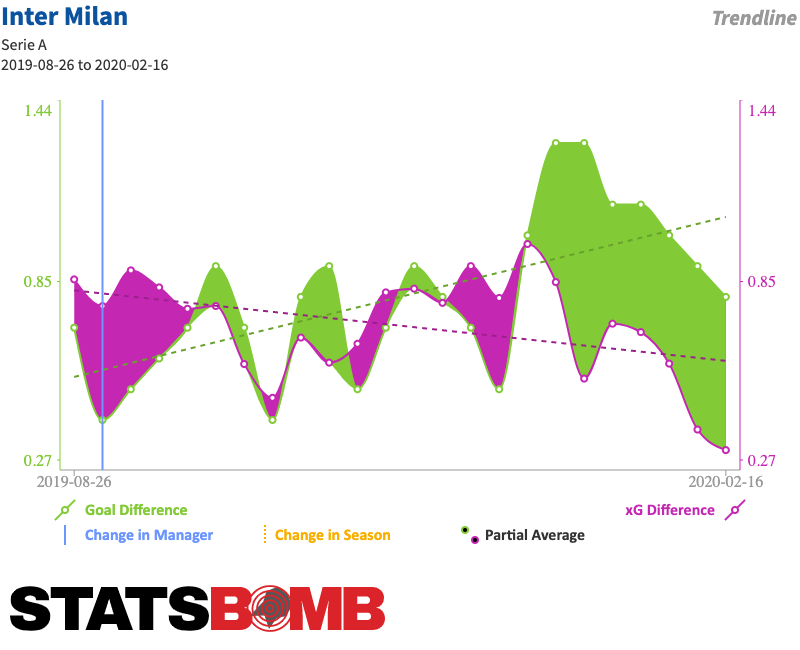 The gap between the two values has been growing since December; Inter managed to maintain a strong goal difference but their non-penalty goal difference collapsed. Excluding penalties, in the last 10 games, they averaged a goal difference of 0.80 but an xG of 0.30. Over the first 14 games, Inter maintained an average non-penalty xG of 1.75 and non-penalty xG conceded of 0.93. In the last 10 games played, offensive production dropped to 1.34 xG, while the defense declined to an average of 1.07 xG conceded.
The gap between the two values has been growing since December; Inter managed to maintain a strong goal difference but their non-penalty goal difference collapsed. Excluding penalties, in the last 10 games, they averaged a goal difference of 0.80 but an xG of 0.30. Over the first 14 games, Inter maintained an average non-penalty xG of 1.75 and non-penalty xG conceded of 0.93. In the last 10 games played, offensive production dropped to 1.34 xG, while the defense declined to an average of 1.07 xG conceded. 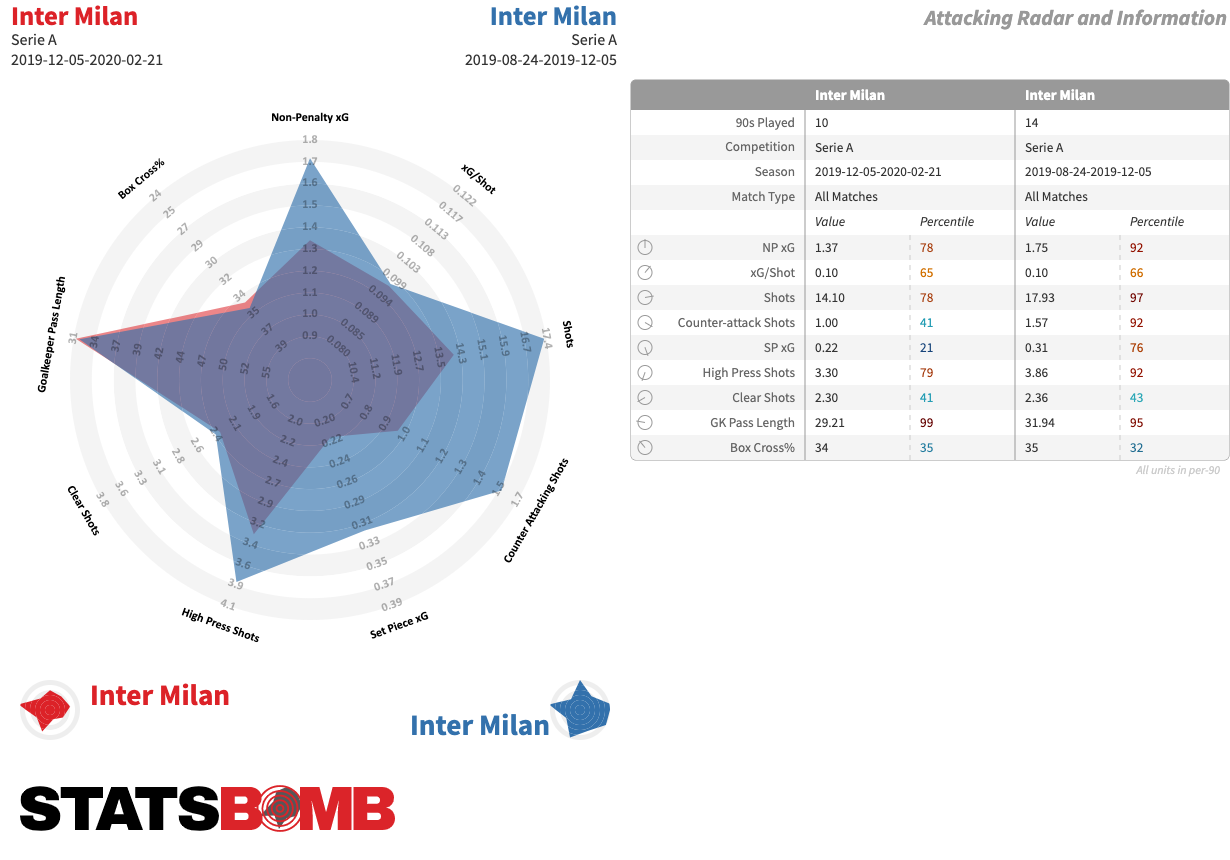 The non-penalty xG difference has therefore dropped by 64% (from 0.82 to 0.30). With their performances now 7th best in the league, it's no wonder they've lost the lead. Inter are also now having difficulty creating chances, as their opponents have found useful strategies to limit them. Inter's offensive game is not highly sophisticated, based on recurring passing patterns and the ability to create chances for its two extraordinary attackers. To give you a concrete example, in an interesting interview with El País' Diego Torres, Atalanta's Papu Gomez explained how they faced Inter:
The non-penalty xG difference has therefore dropped by 64% (from 0.82 to 0.30). With their performances now 7th best in the league, it's no wonder they've lost the lead. Inter are also now having difficulty creating chances, as their opponents have found useful strategies to limit them. Inter's offensive game is not highly sophisticated, based on recurring passing patterns and the ability to create chances for its two extraordinary attackers. To give you a concrete example, in an interesting interview with El País' Diego Torres, Atalanta's Papu Gomez explained how they faced Inter:
Inter had only one move: they played out from the back moving the ball from the center-back to the wing-back, who played a first touch pass to the forwards, Lukaku and Lautaro. One of them was used as a target man, while the other one dropped back to collect the ball, defend it and make his team advance. We man-marked their strikers with our center-backs: we were aware that it was risky, but we also knew that in that way we were able to limit them and create opportunities every time we recovered the ball.
Of their defensive metrics, their aggression coefficient (which measures the proportion of an opponent's passes that are aggressively pressed) dropped from 74th to the 7th percentile) and their passes per defensive action dropped from the 95th to the 34th percentile. 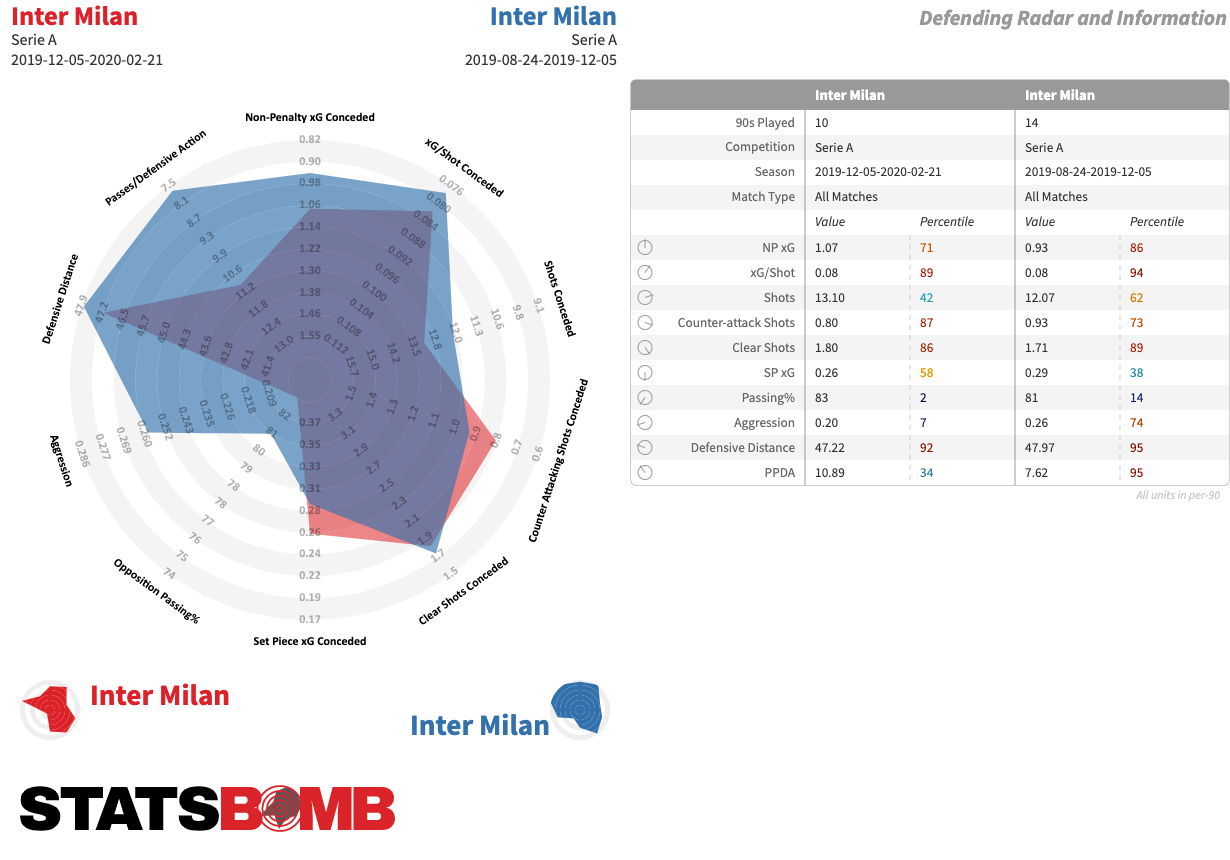 Since December, the decline has been dramatic and Inter, who were among the best teams in the league with a PPDA value of around 7.5, can no longer suppress the opponent's plays as effectively as in the first part of the season. In the last 10 games, their average PPDA was 10.89, a value similar to that of teams struggling not to get relegated, like SPAL and Sampdoria. It's also near that of Lazio, but they have a different style of play, often deliberately trying to leave the ball to their opponents to open up spaces to attack in transition.
Since December, the decline has been dramatic and Inter, who were among the best teams in the league with a PPDA value of around 7.5, can no longer suppress the opponent's plays as effectively as in the first part of the season. In the last 10 games, their average PPDA was 10.89, a value similar to that of teams struggling not to get relegated, like SPAL and Sampdoria. It's also near that of Lazio, but they have a different style of play, often deliberately trying to leave the ball to their opponents to open up spaces to attack in transition. 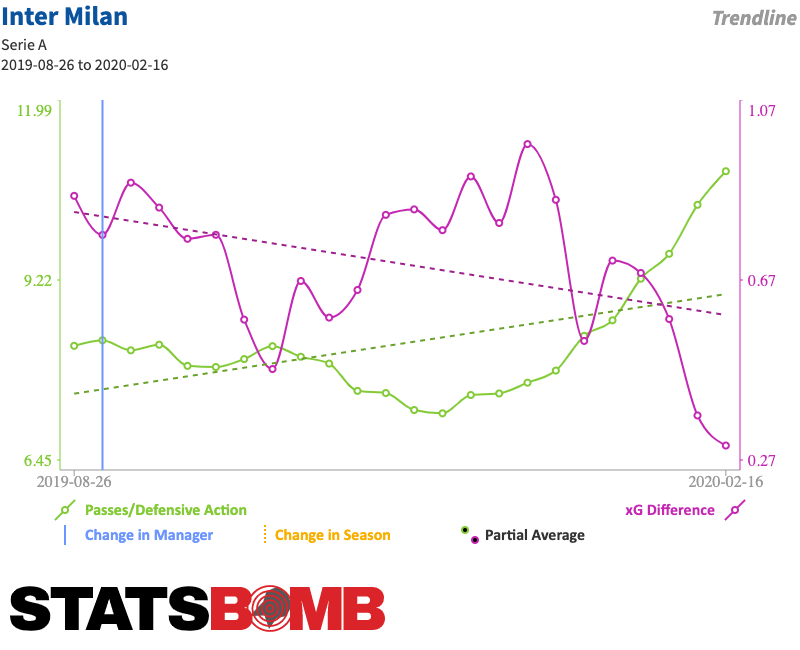 It's not easy to say whether this trend is caused by a different strategic attitude implemented by Conte, considering how many times he's stressed the importance of balancing a roster that in his opinion lacks depth. It could simply the drop of form the manager feared, as 12 players have played about 75% of the total minutes available. The decrease in intensity is easy to see by looking at the last few matches, in which Inter have neither managed to create chances consistently nor to limit their opponents (especially against Lazio), which contrast sharply with their form at the beginning of the season. What matters is that the significant PPDA decline coincides with an equally steep decline in performance as measured once again by non-penalty xG difference. The decline of Marcelo Brozović, who previously looked like an elite performer, is emblematic. The Croatian is no longer able to provide the creativity he offered earlier, nor is he reliable playing as a holding midfielder in front of the defense, as evidenced from the wildly different output in terms of possession adjusted interceptions and tackles.
It's not easy to say whether this trend is caused by a different strategic attitude implemented by Conte, considering how many times he's stressed the importance of balancing a roster that in his opinion lacks depth. It could simply the drop of form the manager feared, as 12 players have played about 75% of the total minutes available. The decrease in intensity is easy to see by looking at the last few matches, in which Inter have neither managed to create chances consistently nor to limit their opponents (especially against Lazio), which contrast sharply with their form at the beginning of the season. What matters is that the significant PPDA decline coincides with an equally steep decline in performance as measured once again by non-penalty xG difference. The decline of Marcelo Brozović, who previously looked like an elite performer, is emblematic. The Croatian is no longer able to provide the creativity he offered earlier, nor is he reliable playing as a holding midfielder in front of the defense, as evidenced from the wildly different output in terms of possession adjusted interceptions and tackles. 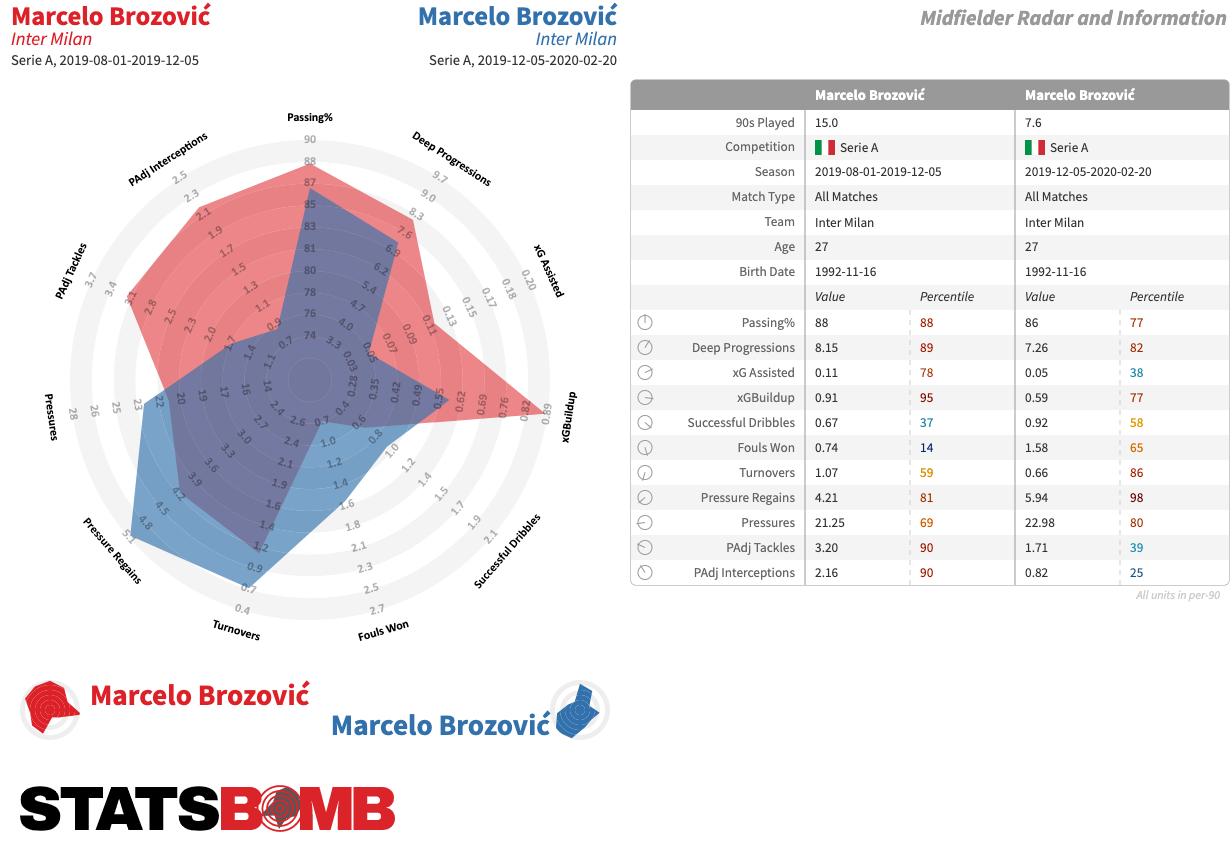 Inter have no alternative but to hope that Brozović will return to his original level of performance and again provide creativity to a stagnating side. Conte is in a tough situation. In addition to going without Samir Handanović at least for one more match, it's likely the team's drop in intensity in the defensive phase is due to the players’ fitness. And there's little chance of recovering, not least because the team is still competing in the Europa League and faces Napoli in the second leg of the semifinals of the Coppa Italia. On the offensive side, much will depend on the incorporation of Christian Eriksen in the starting XI. In Thursday's Europa League game against Ludogorets, playing as number 8, he positively shone, scoring a goal and causing the penalty converted by Lukaku.
Inter have no alternative but to hope that Brozović will return to his original level of performance and again provide creativity to a stagnating side. Conte is in a tough situation. In addition to going without Samir Handanović at least for one more match, it's likely the team's drop in intensity in the defensive phase is due to the players’ fitness. And there's little chance of recovering, not least because the team is still competing in the Europa League and faces Napoli in the second leg of the semifinals of the Coppa Italia. On the offensive side, much will depend on the incorporation of Christian Eriksen in the starting XI. In Thursday's Europa League game against Ludogorets, playing as number 8, he positively shone, scoring a goal and causing the penalty converted by Lukaku. 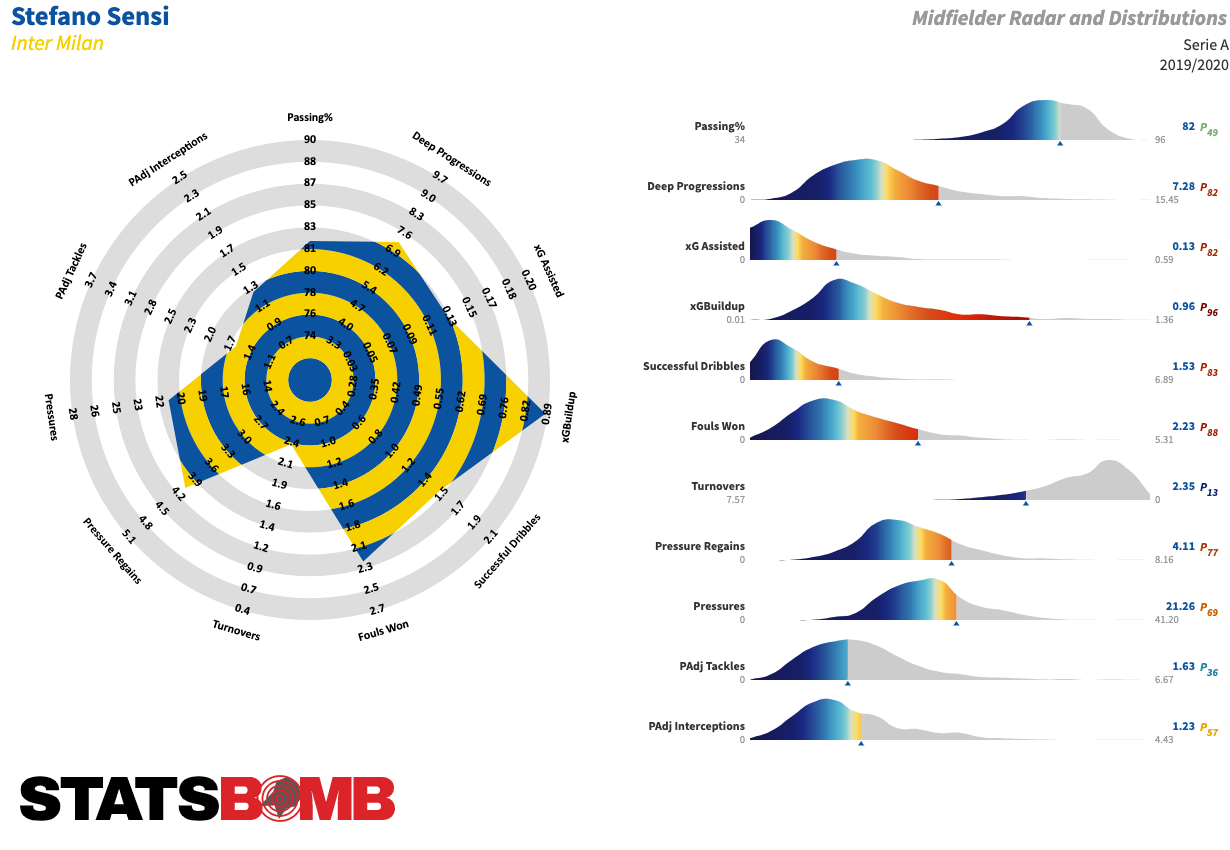 Stefano Sensi was the best Nerazzurri player at the beginning of the season, and had the highest values in xG buildup (0.96) and xG chain (1.04); however, he's been out with injury. Eriksen, an elite Premier League playmaker during his years at Tottenham, could be an upgrade over Sensi, but he must immediately step into his new role in the league as well as Europe. Together with Lazio, Inter are in a position that hardly any teams have enjoyed in the recent seasons of Juventus' domination. They have a shot at the title and must keep fighting for it until the last match of the season. But to keep fighting they need to improve. And to improve quickly.
Stefano Sensi was the best Nerazzurri player at the beginning of the season, and had the highest values in xG buildup (0.96) and xG chain (1.04); however, he's been out with injury. Eriksen, an elite Premier League playmaker during his years at Tottenham, could be an upgrade over Sensi, but he must immediately step into his new role in the league as well as Europe. Together with Lazio, Inter are in a position that hardly any teams have enjoyed in the recent seasons of Juventus' domination. They have a shot at the title and must keep fighting for it until the last match of the season. But to keep fighting they need to improve. And to improve quickly.
